Australian
and international
exploratory
performance and
media arts
Ian Haig
Anti ergonomic hump machine
An installation designed to produce bad posture and humps in the backs of its users with continual use, this work looks at the inverse of ergonomics, where the adverse effects of computers on the human body can be seen as desirable body modifications.
The challenge is to deliberately produce a work that is regressive and self consciously wrong in its thinking—an alternative orthopaedic device for reshaping the human body, which explores the theme of devolution and rethinks our relationship with technology as something which is not always intrinsically ‘progressive.’
Ian Haig is a media artist working across video, installation and animation media. Recently his work has been seen in The New York Digital Salon, Visual Arts Museum, New York; Transmediale Festival, Berlin; and FILE, Museum of Image and Sound, Sao Paulo, Brazil. Recent works include The Super Human Factory Online, Psycho Samba and Web Devolution.
Completion November 2000.
Megan Heyward
Of Day Of Night
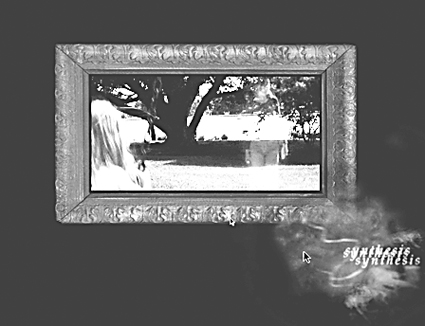
Megan Heyward, Of Day Of Night
A person has lost the ability to dream. Through a series of creative tasks, they attempt to spark their unconscious into dreaming again. This experiment in new media narrative is a hybrid of cinematic, textual and interactive elements, exploring intersections between oneiric experience and the fragmentations, multiplicities and juxtapositions of new media form. The challenge is to animate a text through sound and image with room for uncertainty, indecision, wandering and chance.
With video, sound, text and interactivity, Megan Heyward writes in new media. She developed I Am A Singer (1997) with the support of the Australian Film Commission, acting as writer, artist, programmer, sound designer and director. I Am A Singer has been widely exhibited internationally and has won several Australian and international new media awards. Megan lectures in new media in the Faculty of Humanities & Social Sciences, UTS. Collaborators: Graham Cheney, Suheil Dahdal, Phil Kakulas.
Completion February/March 2001. Australian Film Commission and University of Technology, Sydney.
Hobbs, Xavier, Beames & Glaser
Doctor Pancoast’s Cabinet de Curiosités
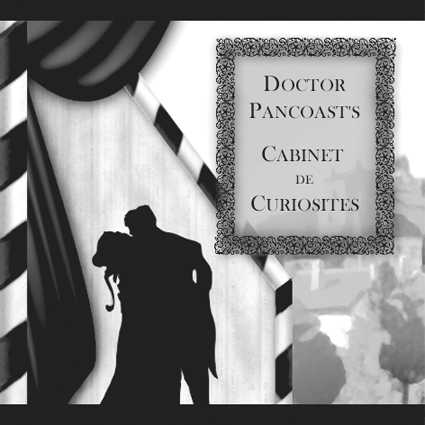
Hobbs, Xavier, Beames & Glaser, Doctor Pancoast’s Cabinet de Curiosités
Anatomically accurate computer graphics and original celluloid vignettes recreate Doctor Pancoast’s prurient misadventures. Locked inside his Cabinet are clues to fascinating and vile perversions. In here, monsters live, hidden behind rules of genteel etiquette, concealed inside quaint notions of scientific discovery.
Doctor Pancoast’s Cabinet de Curiosités is a narrative with 2 intended distribution outcomes: release as an interactive multimedia and self contained linear short. Managing the narrative structure of each whilst making best use of common graphic content has posed a great challenge. Also, providing a satisfying story experience in the interactive has been a key issue for ongoing discussion.
Collaborators: Amelia Lalanne Hobbs, Marie-Louise Xavier, Nic Beames and Michelle Glaser. Past collaborations between Xavier and Glaser (with Robyn Marais) include tetragenia, a net based artwork exhibited in the 1999 Festival of Perth and Juvenate (with Andrew Hutchison), an interactive narrative selected for exhibition in the interactive program of the 2000 Melbourne Film Festival. Lalanne Hobbs is a freelancer accomplished in both screen and print design. Featured in Doctor Pancoast are drawings by WA artists Gina Moore and Richard Giblet.
Completion December 2000. Australian Film Commission; ScreenWest.
ART ORIENTE Objet & Maria Lunney
This as yet untitled work involves a 4 month collaboration-residency in Paris with contemporary art duo ART ORIENTE Objet (Marion Laval-Jeantet and Benoit Mangin) to create a multimedia installation for an exhibition in September 2000 at Galerie des Archives, Paris. The project will explore the connections between visual culture, technology, science and philosophy via the concept of the “ready thought” in opposition to the “open work.” The project contends that if Dadaism pondered the questions of the machine age, and the International Situationists questioned the urban capitalist environment, then today’s question would be to find the place of artistic production in an excessively image saturated world.
Maria Lunney completed a Graduate Diploma in Fine Arts at the VCA in printmaking/film/video and has exhibited recently at the Melbourne International Biennial and the New York Drawing Marathon.
Completion September 2000; online December 2000. Also planned for CD-ROM. New Media Arts Fund, Australia Council.
Kaz Madigan
Feast
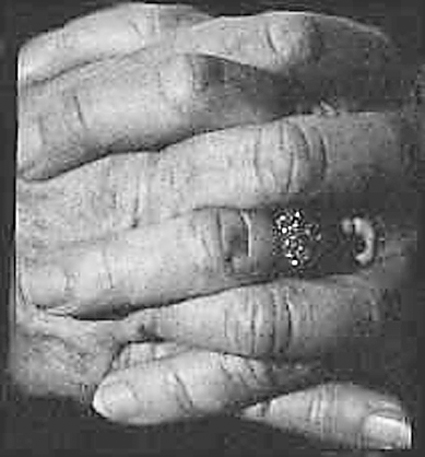
Kaz Madigan, Feast
This project is my contribution to an exhibition by ArtAngels (a group of regional women artists). The collective focus is on the interpretation of feast imagery and its meaning in reference to food, indulgence, body image and food justice.
I am interested in technical platforms which create artistic, fluid works. Like my arts practice, handweaving, the internet presents strict protocols which can be reworked with innovation to create new types of communication and imagery.
I am an artist/handweaver/writer and teacher currently transferring these skills and ideas to internet projects. I am the author of The Australian Weaving Book and was publisher/editor of Curious Weaver, a journal for Australasian weavers. I also serve as a mentor at trAce International Online Writing Community.
Completion, September 2000. www.geocities.com/curiousweaver [expired]
Fiona MacDonald
Museum Emotions
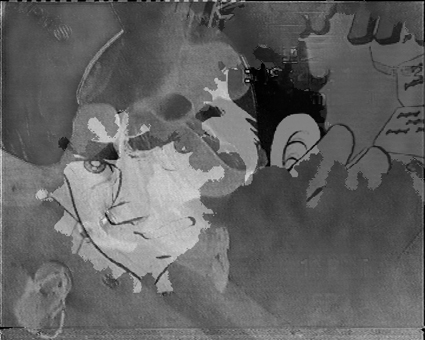
Fiona MacDonald, Museum of Emotions
This project brings together the disciplines and conventions of narrative script writing, video and digital imagery, dance performance, composed music and digital sound design to develop a participatory and experiential concept of narrative using a spatial framework of video and sound installation.
The challenge of this work is to develop a form of narrative writing that is created as much through a spatial dimension as a time-based one. Using televisual conventions and rendering them in a purely imagistic way while sustaining a narrative through boundaries of sound and movement is a central idea. Narrative meaning develops from the audience’s movement. This could occur in ways that are quite dramatic and confronting for the audience while remaining ‘invisible.’
Fiona Macdonald is an artist working in photography, video and installation. Her work has been directed towards showing in public places and she has exhibited in contemporary art spaces and state galleries. Collaborators: Shelley Lasica (choreographer), Francois Tetaz (composer), Jo Lloyd, Deanne Butterworth, Kylie Walters (performers).
New Media Arts Fund, Australia Council.
Second Nature
This non-narrative, 12 minute digital video work develops from abstract fast-moving colour and graphic sequences into tightly edited footage shot in a heavy industrial workplace. The soundtrack, a series of escalating noise intensities, uses the audio recorded onsite as a pure industrial sound element with no mixing down. The script, part translated into Japanese, is rendered in text as subtitles and as a graphic element.
The work is structured partly as a (computer) game, although without clear protagonists. The concept is a meditation on capitalism, commodification and the global economy. The graphic/animated sequences underline this by presenting the human element as interchangeable with a cartoon like or virtual presence.
Fiona Macdonald’s video work has been shown in Australia at Experimenta and the St Kilda Film Festival, overseas at Ars Electronica and ISEA, and film festivals in Italy, Canada, USA and Germany.
Completion July 2000. Work made during tenure as artist-in-residence in the Department of Visual Culture at Monash University.
Sally McLaughlin
Real: a digital installation
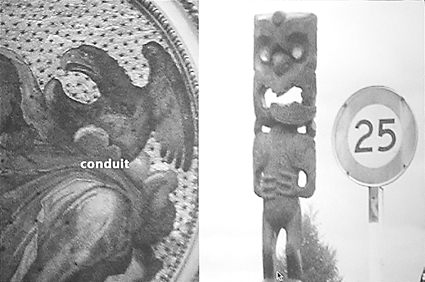
Sally McLaughlin, Real: a digital installation
In this exploration of the dynamics of interpreting experience, images drawn from contemporary environments are juxtaposed with terms such as ‘nature’, ‘prosthesis’ and ‘body.’ Shifts occur in understanding both the images and the terms. Assumptions about the authenticity of practices, modes and readings of experience are brought into play. The work was created over a period of 2 years, the collaborating artists working initially in different cities and ultimately in different countries.
Sydney-based Sally McLaughlin is an educator and interface designer who has developed commercial software, written on theoretical issues in interface design, and developed programmes of study in media arts. Aaron Fry is a New Zealand artist currently in the USA where he teaches art and digital media.
Completion October 2000. The Waikato Polytechnic and Massey University, New Zealand; equipment and facilities provided by Massachusetts College of Art, USA.
mez
Dataface Babee
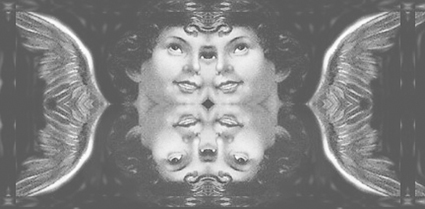
mez, Dataface Babee
Dataface Babee is a collaborative net.wurk that mezanders into the real wurld via a sculptural statement of virtual worth. This project is concerned with exploring the hackneyed notions of the ‘interface’ and developing alternative perspectives through a net.wurk reworking of this accepted paradigm.
Mez (Mary-Anne Breeze) is a widely exhibited net.wurk artist, avataristic author of the networked polysemic language system termed “mezangelle” and regular on and off-line journalist. Walter Brecely is an Australian-based visual artist with a fetish for metal who has exhibited and been involved in artistic-commissioned work for the last 7 years.
Completion December 2000. http://wollongong.starway.net.au/~mezandwalt [expired]
RealTime issue #38 Aug-Sept 2000 pg. 5, 8
© RealTime ; for permission to reproduce apply to realtime@realtimearts.net
In the 12 months since Working the Screen 1999 appeared it has been a constant point of reference in print and online for keeping track of digital media works-in-progress. Some of the works previewed in 1999 are com- plete and are reviewed in the pages of Working the Screen 2000, others are still being developed, such is the creative (and labour-intensive) nature of this work and the challenge of funding it.
Given the large number of requests for reviews and the paucity of review space in general for digital work, we decided to allocate space to reviews as well as previews in the 2000 edition. We couldn’t review every- thing submitted, but we got close to it.
Working the Screen provides a unique and much needed resource. Our thanks to the Australian Film Commission for providing the initiative and their continuing support for Working the Screen.
Our thanks too to the artists and writers who have kept us up to date with work evolving across the country.
As in 1999, we hope that Working the Screen will encourage the keen anticipation and comprehension of new work and the breadth of activity in Australia, be it in video, film, installation, online or in performance and their ever-increasing combinations and permutations. The Editors
Cover image: Unstill life, from Spectrascope
Photograph of the Mari Velonaki and Gary Zebington installation Unstill Life, exhibited as part of Spectrascope, curated by Julianne Pierce and Jacqueline Phillips, Performance Space as part of the Sydney Biennale. For a response to Unstill Life.
I found myself returning to Spectrascope every time I went to see a performance at Performance Space in recent months, seduced by Mari Velonaki’s offering of a real apple to manipulate a digital image of the artist herself; entranced by Denis Beaubois’ hand-cam-surveillance camera view of the act of writing what he sees before him in an occasionally glimpsed public space; moved by the curious alchemy of the ever dissolving golden face of John Gillies’ sister (her photos held before a camera, splitting into pixels as it struggles to focus); and, after these intimacies, unnervingly entertained by the spectacle of Adrienne Doig and Peter Spilsbury’s to-scale-recreation of the Little Boy A-Bomb, its nose reflecting video projections of political low points and Doig playing “the cheerleader, the spy and the warrior…enact(ing) a form of complicity in the structures of power” (Julianne Pierce, catalogue). KG
RealTime issue #38 Aug-Sept 2000 pg.
© RealTime ; for permission to reproduce apply to realtime@realtimearts.net
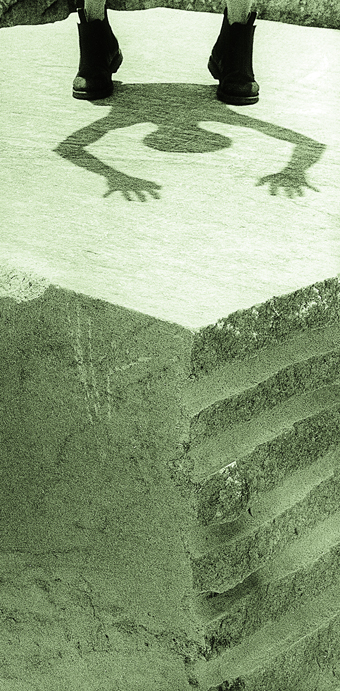
Bonemap
courtesy the artists
Bonemap
Bonemap the wild edge dance | screen | sound | image | object is a site-specific artwork emphasising the ephemeral body via the social and natural landscape. The artists interpret contrasts between the tropical Australian environment and the ‘wild edge’ of urban and built spaces. Exploring relationships of the moment and notations of identity and place sees performance, multimedia, exhibition, installation and sound composition merge into the wild edge. Available as discrete modules.
Challenges: reconnaissance and personal knowledge of sites; small crew multi-tasking in diverse and distant locations; meteorological and extreme environmental effects on technical equipment (sun, water, tiny insects inside camera lens); and stretching of human/technical resources.
Russell Milledge is an artist, curator and consultant. His performance, sculpture, installation art, interface design and multimedia work is collaborative and represented in the collections of Queensland Art Gallery and Cairns Regional Gallery. Rebecca Youdell is a choreographer and performer working in contemporary dance via site-specific collaborations involving multimedia, installation and performance. Collaborators: Glen O’Malley, Michael Whiticker and Paul Lawrence.
the wild edge has been presented in Cairns and Tokyo and will be seen in Townsville in August and as part of l’attitude 27.5º at Brisbane Powerhouse, Septermber 9 – 25. Australia Council, Arts Queensland, The Choreographic Centre (ACT), Cairns City Council. www.bonemap.com
Working the Screen 2000 was a supplement in RT38 surveying media arts.
RealTime issue #38 Aug-Sept 2000 pg. WTS17
© RealTime ; for permission to reproduce apply to realtime@realtimearts.net
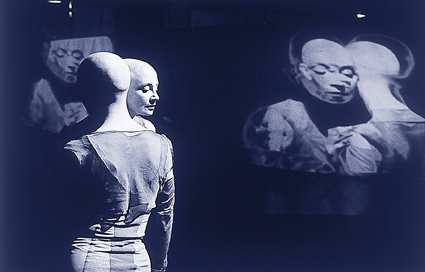
Company in Space, Escape Velocity
Across Australia, there are a significant number of artists and companies working with digital media and in multimedia, each in their own distinctive way, sometimes continuously, occasionally in one-off projects, exploring the relationship between live and pre-recorded performance, or between live and realtime mediated performance, or combinations. This list is by no means exhaustive, but it is indicative of the extent of the engagement: Arena Theatre, Trash Vaudeville, Bonemap, Back to Back Theatre, Sidetrack Performance Group, Urban Theatre Projects, Melbourne Workers Theatre, Nerve Shell, Salamanca Theatre, Dance Works, Heliograph, Doppio Parallello, Anna Sabiel and Sarah Waterson, Dina Panozzo, Marrugeku Company, Louise Taube, Snafu, skadada, Sam James, Mark Rogers, Brink Visual Theatre (Brisbane) and Cazerine Barry. The most dedicated and widely travelled (and broadcast) of groups committed to exploring performance and technology, and for the longest time, has been Company in Space.
In the first of the RealTime/Performance Space forums for artists about vision, training and practice, Company in Space co-Artistic Director Hellen Sky talked to Keith Gallasch, with questions coming from the audience when they wished. This is a small part of a much longer discussion available on the RealTime website. After a brief introduction to the work of Company in Space (John McCormick is co-Artistic Director ), Keith asked about the dancer’s “relationship with the screen in performance, your awareness of the other dancer who is in another space?”
It’s not like you’re watching the screen all the time but a part of your eye, if you need it to, is going to the screen. In telematic works when you’re dealing with different geographies, the screen is your conduit to the other dancer. No longer are you sharing a space, no longer can you hear their breath, their footfall. When working in any group choreography and looking at simultaneity of movement, your perception is already in the physical space, not just through your eyes, it’s listening, you feel the people you’re dancing with. There is this shared body thing. When you separate from that, you still have to feel that you’re sharing that space, that you can get this sense of them being there. In terms of consciousness, this is very expansive—how might you perceive yourself being in the moment of the performance? But there is this thing which is the screen. And it changes depending on the circumstances. In January I was in Hong Kong and Louise Taube was in a nightclub in Melbourne. You can’t always put the screen exactly where you want it to be in the performance space. It’s not like you can always design it to have the privilege of your point of view going straight to your partner. And you don’t want to be looking at the screen anyway. You actually want to be addressing all the other things that are going on in the space.
KG Here on video are 2 versions of Escape Velocity, one Hellen calls the “contained” performance, and then the telematic version performed in 2 locations.
HS This was done in 1998 in a non-conventional space. At this point, the hand and the head are orchestrating the sound. So very small movements of the body are creating the score. What you can’t see is the little laser lights on the floor, a grid that doesn’t emerge in the video. The movement is being motion-detected. The velocity of the movement is creating the score. The other sound is being mixed into the score because there’s a ledge up there and we were out of the range of the camera and couldn’t trigger the score. We’re about 6 metres up in the air by now. You can see Kelly and Luke here. They’re the ones down below who are stopping us from falling on our faces. Not only are they belaying us through all of this (controlling the raising and lowering of the performers) but they’re also filming us from underneath and our images are being fed into the computer and an effect added and it’s going across a whole cyclorama of screens at the back. This is their camera point of view happening in real time as they’re belaying us and leaning backwards on the floor. The whole thing was about gravity and loss of gravity. Where is the body really when we have the possibility to exist in this virtual space where there’s no gravity? What is meaning there? What is memory there?
Audience All the movement is set?
Hellen Skye It’s set in that if we want it to go slow we can. In that section where we’re pushing it, we still have the privilege of being with each other and hearing each other. The movement is trying very much to be in unison. If we were to hang back we would do so together and know that we’d brought the score to silence. So from night to night, there’s some flexibility to deal with—’Hey, I really like it here. It’s good to have it quiet for a bit.’ It’s quite flexible.
Audience The audience is not necessarily aware what is happening technically?
In a way I don’t care if the audience knows it or not but it changes my relationship to it and, therefore, it changes my presence and the evolution of the piece.
Audience I can see that not knowing that the dance and the sound are connected wouldn’t matter but the sound seems like a sea of sound. How does the technology handle specific or subtle movements affecting the sound?
HS When we were experimenting with it, I could go like that with my little finger and Garth Paine could make it a huge or a little sound or it could happen 4 minutes later. That’s its potential. That’s a nice thing to play with. I could put the camera on my face and just do a whole thing with my tongue. It’s something more than choreography responding to music. It’s an expansive experience. And, if we had the privilege of being able to educate ourselves with this stuff, it’d be an expansive experience for the body to learn.
Audience Those little movements, do they happen live or did they have to be pre-programmed?
HS Absolutely in real time. I could ask him to delay the data and it would be different. The collaboration then is what becomes of data. I have to know the possibilities. Those are the things that take time to negotiate. For Garth to be able to set up the parameters and the data it takes time but it’s quite interesting. These animations and graphics are pre-constructed with a brief. Some of them I made and some of them I’ve worked with an animation artist. I don’t work with 3D graphics. You can’t do everything. That’s great. Why would you want to? Other people do one thing really well. You don’t have to multi-skill. When you’re beginning maybe you want to just so you know. I worked with an electronics engineer and each of the laser lights had stepper motors on them so that when you broke the laser beam the light would shift. My idea was to have a 3- dimensional light space which enclosed the body but which kept shifting around it. Sometimes these things fail too. The stepper motors didn’t always work but there’s a sense that I’m changing the light around the body.
Now you can see the 2 dancers juxtaposed against this but then the camera choreography comes in and we’re working with a duplication of ourselves in the video frame. Now Louise is in red and has an overhead camera with virtual objects in it. Her virtual body is breaking these objects, creating noises, constructing her score. You can see the little icons there on the field. So we have an overhead camera point of view which is giving her virtual body the option of being able to break a virtual video object which can change the background but also orchestrate the sound in real time.
Audience What’s a virtual video object?
HS It’s a video icon which you can call a button. That’s one layer. The mixing in of the camera point of view is another layer. Then the animations under that are another layer. When this object perceives the breaking of the object from the virtual camera body, it triggers the sound. That’s the system that John invented.
KG That’s the video of the “contained” version. Here’s the telematic duet.
HS This was between Arizona and Melbourne. And just to think about how you might set something like this up is a whole dialogue in itself. It’s about pragmatic things, about finding overseas partners who understand what you’re trying to do…and installing the link. Just getting the link right! That’s me in Arizona chatting to the audience. It was a thing called International Dance and Technology that they held at Arizona State University (see RealTime 31, page 35). The other place is the Rusden Campus of Deakin University.
Audience How is it connected?
HS Through an ISDN. A single line. 264k ISDN so it’s 128k point to point ISDN. ISDN is what they use for tele-conferencing in the corporate sector or in the medical and educational sectors more and more, when you have 2 or 3 talking heads.
Audience It’s like 6 telephone lines.
HS And ideally you want to have 3 of them. But each time you do it between here and America it’s like a $450 per half hour phone bill. So, the thing about budgets is interesting once you start working on it. So for me to do this work was to reduce it from about 45 minutes into a 20 minute performance where the 2 camera operators and 2 dancers are in separate locations. The negotiation of framing is very intuitive. They’re having to watch the screen output and know that they’re putting us in the right relationship. Also, the intelligent hub with all the computers and the camera network is based in Melbourne and it’s a camera feed that’s going through to Melbourne. On the way it’s going through a whole lot of processes and it’s being sent back and there’s a 3 second delay. So there’s this whole thing about time. Some people might see it as a problem. I think it’s quite interesting that time is altered because you’re trying to pipe all this visual and audio information through what can be a 2 way exchange. You can see here that the image is slightly degraded, my image moreso than Louise’s. I like that. Something’s happening in the conduit. I think that’s interesting.
Audience I’m curious at what point, if ever, do considerations of more traditional screen arts and their processes and methods come into play?
HS A lot actually and maybe in our next work it’s more obvious. Often when you’re having to control the cross-fades between 4 or 5 cameras it’s much more cinematic and cinematic in real time. Things like the duration of a cross-over, when you want that to happen. It’s very much a part of the direction of the whole work. As a choreographer I always used to work with film. I’ve been a photographer and a lot of my work would have Super8 or slides or something to do with light. I guess when we first started to work with these computers, there was a way of actually having all these different things speak to each other through a hub which meant there was a duplicity of possible juxtapositions of meaning, and that keeps happening now but through more complex interfaces.
Audience Does it influence considerations of structure in the whole work?
HS It does. Is the image just happening on the screen? Is it happening in the space? How long will the image be suspended? I don’t know if we’re consciously thinking about filmic structures in terms of say scripting but we’ve discovered that we score things in quite a complex way. When you’re thinking about which camera, what frame, what effect, what cross-over, I suppose we are. But I hadn’t deliberately thought about working in the sense of say, story-boarding or something like that.
KG Trial by Video is interesting in terms of site. It was done at the Economiser Building and in the Old Magistrates Court in Melbourne where Ned Kelly was tried. It’s been done in an old building in Glasgow recently. What’s the importance of site in the work you perform?
HS I think they empower a work. I suppose that’s my visual arts perspective—how you install a work, what you actually get from the physical space, how that can amplify the content, how can you construct things so that they’re satisfying for people just to walk in as an installation before they become enlivened through the performance. There’s lots of histories and textures, possibilities within the physical space we’ve worked in.
For Trial by Video we set up installations at PICA in Perth and at Performance Space and another space in Brisbane. Simultaneously, we were performing in an underground railway station in Melbourne. We had 2 cameras set up in the installation spaces with 2 cameras and an ISDN connection so that the viewers at this end could do certain actions and have an influence on the performance as it happened in Melbourne. They also became part of the visual environment of the performance work.
The tunnel was blocked at both ends so people were contained within the 2 screens at either end of the tunnel. In each of the spaces in PICA and Performance Space and here we had the screen, the cameras, a tray of sand (audiences could move the sand to trigger sound) and a giant book with black and white pages. We did it in 1997 when Pauline Hanson was so, um, “outspoken”. It’s a very political work deliberately looking at the technology and the power of the media to be able to manipulate the masses and what the potential offloading of that is on an individual.
KG A lot of it is about the language of political gesture.
HS All of the movement was done from John’s research into gestures. Basically a person doesn’t just have identity through language and appearance but the way they talk with their hands is a development of who they are. He gave us scores of gestures to use. I was the voice of dissent. He was a politician. It’s a very strong work and even though it was done in 1998, no matter what context we do it in again, (we did it in Glasgow in March this year) the work becomes more sophisticated because we know more about the technology and possibilities. We change it according to the political environment. If you’re actually looking at media power and politics, it’s not ever gonna get out of history. You’ll remember there was a strong anti-Asian immigration debate going on too. John’s half-Chinese and he learned the gestures from A-Z of all of these different words and performed it like a language test. It was as if he was being tested in Chinese and English. There was also a little bit of text from a Pauline Hanson speech—another flavour to the oral content.
KG What have you seen of motion capture technology?
HS Merce Cunningham has done some great things with motion capture. I saw it at SIGGRAPH in 1998 in Florida. He has 3 screens and he’s working with coming in and out of the frame. And it’s Merce’s choreography. You just know it’s Merce’s choreography but it’s not a body. It’s just this whisp of a line but it has weight because it’s come from a body with weight. And it’s beautiful, it’s just beautiful. And I’m thinking I’m getting old too and perhaps I can keep going on too. That’s a big thing about age and Australia. A lot of us want to keep on moving and there’s not a lot of acceptance for older movers in this culture.
Audience I think technology has the potential to change what we experience as a real event. That’s really going to change a lot in the next 20 years if they do away with the screen and write on the retina. So your experience will be like a waking dream. There’s still touch and smell locking you back down to earth but…
HS At SIGGRAPH there was a wonderful woman called Gretchen from Paris. She’s an installation artist working with ‘a trip around the world.’ It was much more lateral than that but the way you experienced it was on a little footpad that had pebbles. Depending on how you shifted your weight, you went on a journey. The materials were all very tactile but it was like this very haptic relationship to the technology that just grounded the body in this other experience. It was so beautiful. That’s installation work but the thing of touch and so on are important to work about the interfaces—not just the eye and the body and the screen.
KG That’s something that Mari Velonaki’s doing in her work.
Mari Velonaki Yes, I’m trying to link the spectator with a projected digital person through objects, through smell, touch, breath…
HS In installation it’s very much more a one-to-one relationship. Even though you might be in a room with lots of people and there might be devices that are making that more complex, the notion of engaging in the experience in an installation is still very much yourself with it. When it can be as haptic as possible that’s when it’s most satisfying.
Mari Velonaki When you can forget about the interface and just go through it.
Company in Space’s new work Architecture of Biography (see Working the Screen 99, page 16) will premiere in association with Melbourne International Festival 2001.
RealTime issue #38 Aug-Sept 2000 pg. WTS16
© Keith Gallasch; for permission to reproduce apply to realtime@realtimearts.net
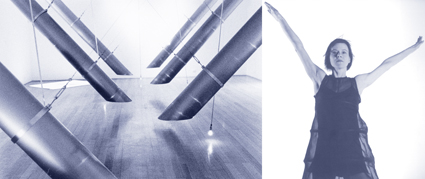
Lucy Guerin, 25 Songs on 25 Lines of Words on Art Statement for Seven Voices and Dance
courtesy the artists
Lucy Guerin, 25 Songs on 25 Lines of Words on Art Statement for Seven Voices and Dance
25 Songs on 25 Lines of Words on Art Statement for Seven Voices and Dance is a collaborative work between artist Joe Felber, composer Elliott Gyger and dancer Lucy Guerin, each of whom is responding directly to American painter Ad Reinhardt’s famous 25 Lines of Words on Art Statement. The 3 artists have created a theatre of response, reconsidering Reinhardt’s seminal 1958 writing on abstraction, art and modernism through the creation of a work combining music, image, video and dance.
Involving interdisciplinary arts practice and new media technology, the installation runs from the Cubase program. The video, stills photography and text graphics were created on Adobe After Effects and Premiere. The Pendulums run on a 12 volt magnet call from 2 transformers.
Joe Felber is an Australian citizen of Swiss origin. He completed an architectural draftsman apprenticeship in Switzerland and Master in Art (sculpture) at RMIT. His is a pluralistic arts practice including painting, photography, video and new media art. He has exhibited internationally since 1985 in New York, Europe and Australia.
This work toured Australia and Singapore and will be shown October-December 2001 at the Minioriten in Graz and Landesgalerie, Ladesmuseum in Linz Austria. Australia Council for the Arts, Pro Helvetia, Switzerland, Credit Suisse Group, Singapore.
Working the Screen 2000 was a supplement in RT38 surveying media arts.
–
RealTime issue #38 Aug-Sept 2000, WTS p15
© RealTime; for permission to reproduce apply to realtime@realtimearts.net
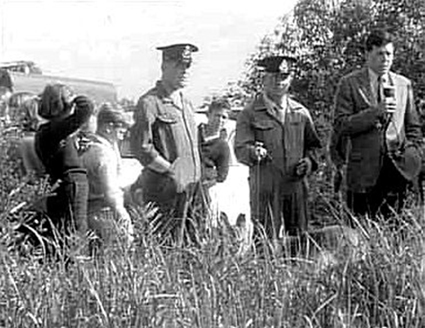
Sharkfeed, archival footage, courtesy ABC
In July 1960, a Sydney schoolboy was abducted and killed. His family had recently won 100,000 pounds in the Opera House lottery—the reason Stephen Lesley Bradley targeted the boy—which triggered cultural responses like ‘stranger danger.’ There have been a variety of readings of this narrative, and Sharkfeed is the latest, a new ABC website which highlights some of the challenges and possibilities for delivering documentary content on the internet. Here artist John Grech and sound designer Matthew Leonard discuss some of the issues raised in its production.
ML Attempting to bring the philosophy of the radio feature or documentary to the internet harks back to elements of the historical form after the Second World War. There is a real emphasis on writing again; and balancing this with the potential for carefully deployed images and sound. Both share a sparseness of texture.
JG There is a lot of scope for artists to transform their practices into new media. However, this presents the same problems that early filmmakers faced. For example, how do you make a movie like Metropolis when no-one’s ever made a movie like that before? How many movie genres do we have today? Back in 1900, there were no such production discourses available. But artists must adapt their techniques to new technologies to utilise new media possibilities, not try to make new technologies do what old technologies do. Also, writing highlights the origins of documentary. As film theorist Bill Nichols pointed out, the distinction between writing as description (traditional documentary) and writing as narrative (fiction) is spurious. Writing a fictional narrative and writing a documentary description are both highly constructed, creative acts of storytelling.
ML Sharkfeed has enabled us to explore the subjectivities that surround these various acts of storytelling. Another interesting aspect has been the disruption of chronology which historically characterises ‘classic’ radio and cinema documentaries. Has this also had an impact on your approach to the visual material?
JG Visual art is basically a spatial medium. Although the web offers an unpredictable space, it still deals with time as time, not just by spatialising it as visual art does. The digital screen is a fascinating way of experiencing both time and space, but I’m not sure there is yet a very useful critical or theoretical framework on how people actually experience these.
ML Again, if we compare it with existing forms, the experience of hearing a radio program is driven by the durations of sound events, conversations, voices. This has a critical impact on the tone of a program, but part of the trick with the internet is being able to anticipate such factors as download time and server timeouts which strongly dictate the ‘tempo’ of the work. From a sound perspective, this is a critical difference.
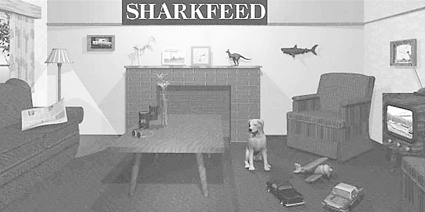
Sharkfeed
JG This probably represents the greatest limitation of the medium. But it is closer to how people experience an exhibition in a gallery—someone might walk quickly or haphazardly through a space, while another might tread very carefully along a more predictable path. One major difference between the web and a gallery is the fact that people in galleries still determine the speed and succession of events. On the web, these are determined more by technology. The web is still at an early stage of development.
ML The potential for synchronous sound on the internet is still at a fairly primitive level, and seems to require a high level of commitment and experience from the users to get the most out it. We agreed it was important that the site represent a mixture of period and contemporary interpretation in a way that leaves interpretation open for the audience. However, I feel that Sharkfeed has also become an interrogation of our own processes of understanding, particularly with the inclusion of a variety of commentaries in the experience.
JG That was one of the lies about conventional documentary. What gave analog photography the “aura” it had was the belief that it truly was the “Pencil of Nature” or that it created a footprint of the real world on a negative which was incapable of being interfered with by its maker. Thinkers like Walter Benjamin, Umberto Eco and Roland Barthes have shown that no image is neutral of its maker’s subjectivity. If we eradicate our subjectivity from the things we make, they would become meaningless. Subjectivity gives meaning to things. Without subjectivity, everything is reduced to a flat and featureless landscape. It’s the difference between noise and sound, although people like John Cage have played a lot with such distinctions.
Sharkfeed, Matthew Leonard & John Grech, www.abc.net.au/sharkfeed/index.htm (expired), was launched at ABC Radio Arts, Sydney, July 25. See review, Working the Screen, page 3.
RealTime issue #38 Aug-Sept 2000 pg. 26
© Matthew Leonard & John Grech; for permission to reproduce apply to realtime@realtimearts.net
Once again dLux media arts has played a notable role in the Sydney Film Festival, displaying interactive digital works in its d>art00 Exhibition at Customs House, Circular Quay (several of the works are reviewed in Working the Screen, see below) and screenings in the Dendy Opera Quays cinema. Both events were well-attended. While the interactive works offered various levels of pleasure, depending on your patience and the availability of computers, and pretty much looked how you’d expect digital works to look, the films and videos were another matter altogether and provoked some intense discussion.
There was more than a hint from d>art00 Project Manager Susan Charlton in her preface to the program that there would be an issue here:
What should we now expect a digital artwork to look or sound like? Have digital technologies become so pervasive that they are almost invisible…There is no question that artists are increasingly taking up digital technologies to create their works. But how are they using them right now?
This theme of invisibility and its ramifications is developed by Mitchell Whitelaw in an extension of a paper (Working the Screen) he gave at the d>art00 forum in which he proposed an end to the use of terms like new media arts and digital arts. Peta Tait’s review of the new work at the Melbourne Planetarium by The Men Who Knew Too Much, Virtual Humanoids (Working the Screen, page 18), offers another perspective on the same theme.
The d>art00 screenings provoked 2 kinds of response. The first was acclaim, a response to the absence, pretty much, of conspicuous computer animation and pleasure in a return to avant-garde form—short bursts of serious, grainy, sometimes scratchy filmmaking, various discontinuities and ruptures and a shortage of Tropfest jokiness. The second was disappointment, surprise that this is where ditigal film and video are alleged to be going—backwards into the well-established conventions of Super 8 ‘experimentation.’ A dispassionate viewing could sympathise with both sides, weary of slick digital animation but too familar with the film language, but the selection was certainly curious and there was a pronounced formal retro feel in many of the films. The works that offered most appeared to exploit new technology more visibly, and that feeling was doubtless exacerbated by the unadventurousness of many of the others where the mere flicker of an idea or a formal gesture seemed to have been enough to warrant a screening. Anyway, who was I to know where the technology was showing through? Clearly though, the technology is available to make your video look like Super 8.
Some works started out with promise. How to become a Film Freak in 7 Easy Lessons (Germany, Harrald Schleicher, video 1999) offered vaguely interesting floating full motion ‘cut-outs’ (backgrounds casually deleted) of mostly famous film actors (Bogart and Swanson repeatedly) delivering lines from movies about movie-making. Soon it felt like not much more than a nostalgic pick-the-movie trivia game. It wasn’t as funny as it thought it was. Kerry Tribe’s The Audition Tapes (video, USA, 1998) promised more than it could deliver, like a side show to something more significant as actors auditioned to play members of the filmmakers’ family in a mock documentary. The director’s sometimes confusing offscreen instructions and the hint of a dark family secret offered a certain frisson. But what was it doing in d>art00? Jim Finn’s Sharambaba (video, USA, 1999) shifted from a conversation between a man and a woman (the sound as if fed backwards and against a rackety clicking, the framing unsteady, subtitles for the dialogue) to faded shots of dusty streets, perhaps from another time. Lots of layering, but adding up to little. A Sheep in Wolf’s Clothing (Sam Easterson, USA, video 1999) has a camera attached to the head of a sheep. A bumpy run. The other sheep seem alarmed. Hardly a sheep’s point of view and certainly not an example of cultural relativity. A slight video that has won a lot of unwarranted attention.
There were more engaging works that seemed to be pushing the limits of film by way of having something to say. Little Echo Lost (Armagan Ballantyne, Australia, 35mm, 1999) was the only film with any visceral punch, offering a widescreen, vertiginous, Rosemary Laing-ish landscape, and a potent degree of visual subjectivity in the breath-taking moment when ‘we’ emerge from our little hole in the ground into Blue Mountains spectacle with a sonic whoosh. Doubtless some thought it a slick AFTRS product. The technically adroit lovehotel (Linda Wallace, video, Australia 2000), a commercial for an inscrutable, sun-glassed global citizen, Francesca (“suck my code, baby”) da Rimini, looked like it would be more at home on a computer screen and all the better for being manipulable—at least to get a better look and to attend properly to the gash girl’s texts (see Working the Screen, page 6). Michiel van Bakel’s Undertow (video, Netherlands, 1999), set in the columns beneath a freeway, intially appears to be a formal exercise, rearranging the columns by angles and various lenses. But a man is introduced, leaping into the air until he remains suspended between the columns, the camera circling him magically without interruption or edit. Of course Matrix did this kind of thing but without offering us the opportunity for a long, contemplative gaze. Auto-matic (Manu Gondeau, France, video, 1998) a brisk digitally animated anti-advertisment has its best moment early on in its 1’30 when a cut-out muscular young man coughs up a sleek motor vehicle, as if giving birth. Nought after that, unless you see flashes of “Static” and “Monomonia” as meaningful.
Somewhere between the traditions of the avant-garde and the new technical virtuosity (not that I know how she did it) is Festa Mobile (Moving Party; Valentina Coccetti, video, Italy, 1999), a visual feast, a bizarre animation with the key figure a bulbous black duck (an image from somewhere in modernist iconography) transforming into a mouse a la Mickey, a bear and an elephant and moving in and out of westerns, pornography and travelogues against a soundtrack shifting elegantly from romantic strings to jazz by composer Nunzi. Despite the lurching, earnest animation we know so well, there was a deftness of touch and a visual richness that underpinned this increasingly sinister reverie.
The d>art00 screenings were a very mixed bag. Whether they affirmed the curatorial thesis of the increasing invisibility of the digital is another matter (it would have been interesting to have more detailed technical program notes on each film—a future possibility?). While the truth of that invisibility is obvious in many respects (eg in action feature films) the argument does little justice to a different kind of distinctiveness, the hybrids emerging in places other than cinemas and screening rooms, like d>art00 in Customs House, in theatres and public places and events like Cyber Cultures. While it’s pleasing to see film festivals embrace ‘new media’, it does position such work as an adjunct to the movie experience (while doubtless promoting an interest in it). Why, with a few inviting exceptions, did d>art00 place itself firmly back in film tradition? What exactly is its curatorial rationale, or are we really at some defining moment where the old forms rule again and film is film, dance is dance, theatre is theatre?
dLux media arts, d>art00 screenings, film & video, Sydney Film Festival, Dendy Opera Quays cinema, June 20, 22
See Working the Screen page 6 for reviews of Rebecca Bryant’s TellTale, Linda Wallace’s lovehotel, Tobias Kazumichi Grimes’ Electronic Sound Remixer, Leon Cmielewski and Josephine Starrs’ Dream Kitchen from the d>art00 Exhibition, Customs House, Circular Quay, Sydney. June 8 – July 2
RealTime issue #38 Aug-Sept 2000 pg. 25-
© Keith Gallasch; for permission to reproduce apply to realtime@realtimearts.net
Online
Johnny Ice, Digital Detective is a weekly multimedia comic about futuristic cop Johnny, “working with cheap clients and even cheaper technology.” There are plenty of soundbytes and animations within the 13 edisodes, and more to come. www.secretcity.com.au/johnnyice/ [expired]
PreFab, curated by Shiralee Saul & Helen Stuckey, is an exhibition of VRML sites exploring the “pleasures and potentialities of the digital suburbs”, allowing viewers to explore the virtual homes of architects and multimedia artists including Horst Kiechle & Jamie C Paynter. www.maap.org.au/maap99/prefab/ [expired]
Sydney@rt maps a maze of artists from non-English speaking backgrounds, using music, video, digital images, writing labs and animation to investigate Sydney life; some are incredibly confronting like the abusive woman who rings the Multicultural Arts Alliance with a diatribe against migrants. Real or fiction? Artists featured: Justo Diaz, Misako Sugiyama, Tiet Ho, Zoja Bojic, Vahid Vahed. www.multiart.org.au/sydneyart/ [expired]
The Fine Art Forum online gallery always features interesting digital artists, both Australian and international, and explores crossovers between arts and sciences, and the use of medical technology. An upcoming exhibition in August is eyesee where new Indigenous artists explore digital media. www.fineartforum.org/Gallery/navbar.html [expired]
Melbourne’s Next Wave festival (see Alex Hutchinson review, RT 38) featured a wide range of web works under the banner Wide Awake: dreaming at twilight, including Matt Gardiner’s temple of dreams, a virtual drive-in cinema, and fest on the net (http://arts.abc.net.au/netfest/ [expired]), online festival coverage including net radio, video of performances and reviews compiled by RMIT students. www.nextwave.org.au
University of SA’s mag net (www.magnet.unisa.edu.au/ [expired]) promotes the work of students from the Department of Communications with a multimedia channel showcasing animation, interactive works and digital video, while design students at UWS have put together gleematrix, a nifty site commissioned by gleebooks, which looks at the art of writing in a digital context. www.design.nepean.uws.edu.au/projects/ [expired]
gleematrix: Juliana Wong’s teasing site of manga gifs and text should keep you busy for a while. That’s if you can find your way into the site. Persevere. Tiny glimpses, almost unattainable, offer frustration and fun. www.anu.edu.au/ITA/CSA/photomedia/wong/interface/ [expired]. KK
The Australian Multimedia Catalogue has been updated and is available on the website of the Australian Film Commission (www.afc.gov.au/resources/searchd/mm/ – expired]). The catalogue lists 740 interactive multimedia titles recently completed or currently being developed by Australian multimedia developers. The catalogue is produced from the Multimedia Projects Database maintained by AFC Research and Information. This database is also used to produce a hard copy version of the catalogue which is distributed free to distributors and at major international markets such as Milia and E3.
CD-ROM
Helen Grace’s Before Utopia, A Non-official Prehistory of the Present is a really good read. That’s something you can’t often say of a CD-ROM. It’s a multi-layered history of art, politics and visual art politics from the mid 50s to 1990 with the Art Workers Union (NSW) at its centre. Grace has done the editing, collating, curating and timelining—at the centre of the work is a string of years to click your way through, each marked by a choice quotation and an image—a photo or a poster. Then you click into the year of your choice to find a table of 3 columns—Art, Union, World—each with events, documents, interview transcripts and images. If you want to go further into the documents, you can and, beyond, into the extensive artist/writer bibliographies. The glimpses of Art Workers Union posters designed for parties and protests are powerfully evocative of more combative political times as are the often vigorous documents and diatribes taken from notes, minutes, jounals, catalogues, BUGA UP graffiti and the press. Grace hasn’t written a history, she’s facilitated the making of one. It’s up to you to put it all together. It’s an invaluable resource, easy to use, and, as she says, the CD-ROM format allows it to be sooner or later added to—something you find yourself often inclined to. One complaint—the single loop of music (it’s all I got) could drive you mad unless you’re addicted to the band, but even then… Turn off the sound. Before Utopia is not a whizz-bang CD-ROM but it does what it sets out to do and does it well. Media.Culture Books, Series Editor McKenzie Wark. Distributed by Pluto Press. KG
Uncle Bill, created by Debra Petrovich and produced by Julianne Pierce, forecast in Working the Screen 1999, is about to be launched as part of an installation at Artspace in August. A sneak preview revealed a haunting evocation of a disturbing relationship, shot in black and white and mixed in with historical/home movie footage. You work your way through a house and the surrounding landscape in a regional industrial town, triggering recollections and anxieties. KG
Kiersty Garbett’s Parasite follows the journey of a parasite through the human body—a street system with road signs to vital organs. It was recently exhibited at the e-media gallery at the Contemporary Centre for Photography in Melbourne.
Events
Experimenta’s Orbital, shown simultaneously at CCP and the Lux Centre for Film, Video and Digital Media in London, has just finished. It featured artists Brook Andrew, Raymond Peer, Megan Jones, Nicola Loader, Margie Medlin & Nigel Helyer exploring, through digital media, Australia’s cultural and topographical landscapes and issues surrounding salination, biological & technological ecosystems, cultural identity & colonialism (see review in RealTime 39).
Octopus no. 1 at 200 Gertrude St Melbourne (until August 16) is the first in a series engaging with the “changing perception of objects according to the tenets of the digital, the virtual and the technological realms.” Curated by Max Delany, artists include ADS Donaldson, Julia Gorman, Michael Graeve & Sandra Selig.
James Angus’ new works at Experimental Art Foundation, Adelaide (until August 5), play with scale, using digital technologies to calculate and model shapes and objects falling from high altitudes at the moment of collapse. Chris Chapman, director, writes that “dynamics software, CAD and stereolithography [are used] to realise in actual physical terms an imaginary, or as the artist suggests, ‘virtual event’.”
Marrugeku Company, a collaboration between Stalker and Kunwinjki people from Kumbbulunya in the Northern Territory, is developing Crying Baby, a large-scale outdoor inter-cultural performance employing physical theatre, Kunwinjki dance, music, film, installation, weaving, sound art and composition. Funded by the New Media Arts Fund of the Australia Council.
Recent publications
Go online, slip in the ensemble logic CD-ROM, and you have access to a host of electronic Writing Research ensemble and associated writers. As editor Teri Hoskin says in her “post-face”, “what this book wants to do is to open up portals, or spaces between projects/events—to restructure the structure without shifting a tag, sans touching a stone or a strut.” A handsomely produced book of text offers a foretastes of the works. Contributors include Linda Marie Walker, Linda Carroli, Josephine Wilson, Bill Seaman, Sue Thomas, Mark Amerika, Katie More, Dylan Everett and more. http://ensemble.va.com.au
Artlink, Vol 20, no 1, Reconciliation? Indigenous Art for the 21st century, includes Susan Angel’s “Remote area computer art: multimedia talent emerges at Yuendumu”, focusing on the work of Donovan Rice.
Photofile #60, August 2000. Edited by Mike Leggett, this edition includes Darren Tofts on Murray McKeich; Les Walkling on the industrialisation of image manipulation tools; Leggett on the discontinued Photoshop ‘rival’, Live Picture; Edwina Bartleme on queer theory and digital aesthetics as she prepares Queer Transgressions for the Brisbane Powerhouse; Ricky Cox on internet opportunities for photographers; plus the work of the Perth-based group of media artists, Retarded Eye. The issue features work by Patricia Piccinini, Caroline Brunet, Marty Saint James, Xiao Xian Liu and Rebecca Cummins along with reviews of recent exhibitions. Published by Australian Centre for Photography. www.acp.au.com [expired]
ART Asia Pacific, Issue 27, new.media. For images and information alone, this is an impressive issue. It includes Japan’s Dumb type; interactive art in Japan; Korean video art; Melbourne’s Federation Square; electronic art in Malaysia; Taiwan-born Shu Lea Chang’s provocative New York site and online works; and the boom in mainland Chinese video installation. Kathy Cleland writes about New Zealand’s Maureen Lander and John Fairclough, Sydney-based artists Melinda Rackham and Justine Cooper, and Canberra-based, Hong Kong-born Juliana Wong. With assistance from MAAP, a selection of articles will appear on www.artasiapacific.com
Ashley Crawford, formerly Editor of the late lamented 21.C and new media correspondent has been appointed Editor of the New York-based Artbyte magazine. It’s glossy and informative and occasionally glimpsed in Australian inner-city newsagencies. Congratulations Ashley. www.artbyte.com
RealTime issue #38 Aug-Sept 2000 pg. 18
© inhouse ; for permission to reproduce apply to realtime@realtimearts.net
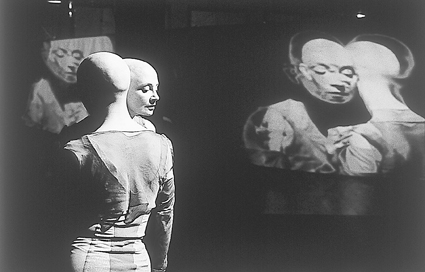
Company in Space, Escape Velocity
Across Australia, there are a significant number of artists and companies working with digital media and in multimedia, each in their own distinctive way, sometimes continuously, occasionally in one-off projects, exploring the relationship between live and pre-recorded performance, or between live and realtime mediated performance, or combinations. This list is by no means exhaustive, but it is indicative of the extent of the engagement: Arena Theatre, Trash Vaudeville, Bonemap, Back to Back Theatre, Sidetrack Performance Group, Urban Theatre Projects, Melbourne Workers Theatre, Nerve Shell, Salamanca Theatre, Dance Works, Heliograph, Doppio Parallello, Anna Sabiel and Sarah Waterson, Dina Panozzo, Marrugeku Company, Louise Taube, Snafu, skadada, Sam James, Mark Rogers, Brink Visual Theatre (Brisbane) and Cazerine Barry. The most dedicated and widely travelled (and broadcast) of groups committed to exploring performance and technology, and for the longest time, has been Company in Space.
In the first of the RealTime/Performance Space forums for artists about vision, training and practice, Company in Space co-Artistic Director Hellen Sky talked to Keith Gallasch, with questions coming from the audience when they wished. This is a small part of a much longer discussion available on the RealTime website. After a brief introduction to the work of Company in Space (John McCormick is co-Artistic Director ), Keith asked about the dancer’s “relationship with the screen in performance, your awareness of the other dancer who is in another space?”
It’s not like you’re watching the screen all the time but a part of your eye, if you need it to, is going to the screen. In telematic works when you’re dealing with different geographies, the screen is your conduit to the other dancer. No longer are you sharing a space, no longer can you hear their breath, their footfall. When working in any group choreography and looking at simultaneity of movement, your perception is already in the physical space, not just through your eyes, it’s listening, you feel the people you’re dancing with. There is this shared body thing. When you separate from that, you still have to feel that you’re sharing that space, that you can get this sense of them being there. In terms of consciousness, this is very expansive—how might you perceive yourself being in the moment of the performance? But there is this thing which is the screen. And it changes depending on the circumstances. In January I was in Hong Kong and Louise Taube was in a nightclub in Melbourne. You can’t always put the screen exactly where you want it to be in the performance space. It’s not like you can always design it to have the privilege of your point of view going straight to your partner. And you don’t want to be looking at the screen anyway. You actually want to be addressing all the other things that are going on in the space.
KG Here on video are 2 versions of Escape Velocity, one Hellen calls the “contained” performance, and then the telematic version performed in 2 locations.
This was done in 1998 in a non-conventional space. At this point, the hand and the head are orchestrating the sound. So very small movements of the body are creating the score. What you can’t see is the little laser lights on the floor, a grid that doesn’t emerge in the video. The movement is being motion-detected. The velocity of the movement is creating the score. The other sound is being mixed into the score because there’s a ledge up there and we were out of the range of the camera and couldn’t trigger the score. We’re about 6 metres up in the air by now. You can see Kelly and Luke here. They’re the ones down below who are stopping us from falling on our faces. Not only are they belaying us through all of this (controlling the raising and lowering of the performers) but they’re also filming us from underneath and our images are being fed into the computer and an effect added and it’s going across a whole cyclorama of screens at the back. This is their camera point of view happening in real time as they’re belaying us and leaning backwards on the floor. The whole thing was about gravity and loss of gravity. Where is the body really when we have the possibility to exist in this virtual space where there’s no gravity? What is meaning there? What is memory there?
Audience All the movement is set?
It’s set in that if we want it to go slow we can. In that section where we’re pushing it, we still have the privilege of being with each other and hearing each other. The movement is trying very much to be in unison. If we were to hang back we would do so together and know that we’d brought the score to silence. So from night to night, there’s some flexibility to deal with—’Hey, I really like it here. It’s good to have it quiet for a bit.’ It’s quite flexible.
Audience The audience is not necessarily aware what is happening technically?
In a way I don’t care if the audience knows it or not but it changes my relationship to it and, therefore, it changes my presence and the evolution of the piece.
Audience I can see that not knowing that the dance and the sound are connected wouldn’t matter but the sound seems like a sea of sound. How does the technology handle specific or subtle movements affecting the sound?
When we were experimenting with it, I could go like that with my little finger and Garth Paine could make it a huge or a little sound or it could happen 4 minutes later. That’s its potential. That’s a nice thing to play with. I could put the camera on my face and just do a whole thing with my tongue. It’s something more than choreography responding to music. It’s an expansive experience. And, if we had the privilege of being able to educate ourselves with this stuff, it’d be an expansive experience for the body to learn.
Audience Those little movements, do they happen live or did they have to be pre-programmed?
Absolutely in real time. I could ask him to delay the data and it would be different. The collaboration then is what becomes of data. I have to know the possibilities. Those are the things that take time to negotiate. For Garth to be able to set up the parameters and the data it takes time but it’s quite interesting. These animations and graphics are pre-constructed with a brief. Some of them I made and some of them I’ve worked with an animation artist. I don’t work with 3D graphics. You can’t do everything. That’s great. Why would you want to? Other people do one thing really well. You don’t have to multi-skill. When you’re beginning maybe you want to just so you know. I worked with an electronics engineer and each of the laser lights had stepper motors on them so that when you broke the laser beam the light would shift. My idea was to have a 3- dimensional light space which enclosed the body but which kept shifting around it. Sometimes these things fail too. The stepper motors didn’t always work but there’s a sense that I’m changing the light around the body.
Now you can see the 2 dancers juxtaposed against this but then the camera choreography comes in and we’re working with a duplication of ourselves in the video frame. Now Louise is in red and has an overhead camera with virtual objects in it. Her virtual body is breaking these objects, creating noises, constructing her score. You can see the little icons there on the field. So we have an overhead camera point of view which is giving her virtual body the option of being able to break a virtual video object which can change the background but also orchestrate the sound in real time.
Audience What’s a virtual video object?
It’s a video icon which you can call a button. That’s one layer. The mixing in of the camera point of view is another layer. Then the animations under that are another layer. When this object perceives the breaking of the object from the virtual camera body, it triggers the sound. That’s the system that John invented.
KG That’s the video of the “contained” version. Here’s the telematic duet.
This was between Arizona and Melbourne. And just to think about how you might set something like this up is a whole dialogue in itself. It’s about pragmatic things, about finding overseas partners who understand what you’re trying to do…and installing the link. Just getting the link right! That’s me in Arizona chatting to the audience. It was a thing called International Dance and Technology that they held at Arizona State University (see RealTime 31, page 35). The other place is the Rusden Campus of Deakin University.
Audience How is it connected?
Through an ISDN. A single line. 264k ISDN so it’s 128k point to point ISDN. ISDN is what they use for tele-conferencing in the corporate sector or in the medical and educational sectors more and more, when you have 2 or 3 talking heads.
Audience It’s like 6 telephone lines.
And ideally you want to have 3 of them. But each time you do it between here and America it’s like a $450 per half hour phone bill. So, the thing about budgets is interesting once you start working on it. So for me to do this work was to reduce it from about 45 minutes into a 20 minute performance where the 2 camera operators and 2 dancers are in separate locations. The negotiation of framing is very intuitive. They’re having to watch the screen output and know that they’re putting us in the right relationship. Also, the intelligent hub with all the computers and the camera network is based in Melbourne and it’s a camera feed that’s going through to Melbourne. On the way it’s going through a whole lot of processes and it’s being sent back and there’s a 3 second delay. So there’s this whole thing about time. Some people might see it as a problem. I think it’s quite interesting that time is altered because you’re trying to pipe all this visual and audio information through what can be a 2 way exchange. You can see here that the image is slightly degraded, my image moreso than Louise’s. I like that. Something’s happening in the conduit. I think that’s interesting.
Audience I’m curious at what point, if ever, do considerations of more traditional screen arts and their processes and methods come into play?
A lot actually and maybe in our next work it’s more obvious. Often when you’re having to control the cross-fades between 4 or 5 cameras it’s much more cinematic and cinematic in real time. Things like the duration of a cross-over, when you want that to happen. It’s very much a part of the direction of the whole work. As a choreographer I always used to work with film. I’ve been a photographer and a lot of my work would have Super8 or slides or something to do with light. I guess when we first started to work with these computers, there was a way of actually having all these different things speak to each other through a hub which meant there was a duplicity of possible juxtapositions of meaning, and that keeps happening now but through more complex interfaces.
Audience Does it influence considerations of structure in the whole work?
It does. Is the image just happening on the screen? Is it happening in the space? How long will the image be suspended? I don’t know if we’re consciously thinking about filmic structures in terms of say scripting but we’ve discovered that we score things in quite a complex way. When you’re thinking about which camera, what frame, what effect, what cross-over, I suppose we are. But I hadn’t deliberately thought about working in the sense of say, story-boarding or something like that.
KG Trial by Video is interesting in terms of site. It was done at the Economiser Building and in the Old Magistrates Court in Melbourne where Ned Kelly was tried. It’s been done in an old building in Glasgow recently. What’s the importance of site in the work you perform?
I think they empower a work. I suppose that’s my visual arts perspective—how you install a work, what you actually get from the physical space, how that can amplify the content, how can you construct things so that they’re satisfying for people just to walk in as an installation before they become enlivened through the performance. There’s lots of histories and textures, possibilities within the physical space we’ve worked in.
For Trial by Video we set up installations at PICA in Perth and at Performance Space and another space in Brisbane. Simultaneously, we were performing in an underground railway station in Melbourne. We had 2 cameras set up in the installation spaces with 2 cameras and an ISDN connection so that the viewers at this end could do certain actions and have an influence on the performance as it happened in Melbourne. They also became part of the visual environment of the performance work.
The tunnel was blocked at both ends so people were contained within the 2 screens at either end of the tunnel. In each of the spaces in PICA and Performance Space and here we had the screen, the cameras, a tray of sand (audiences could move the sand to trigger sound) and a giant book with black and white pages. We did it in 1997 when Pauline Hanson was so, um, “outspoken”. It’s a very political work deliberately looking at the technology and the power of the media to be able to manipulate the masses and what the potential offloading of that is on an individual.
KG A lot of it is about the language of political gesture.
All of the movement was done from John’s research into gestures. Basically a person doesn’t just have identity through language and appearance but the way they talk with their hands is a development of who they are. He gave us scores of gestures to use. I was the voice of dissent. He was a politician. It’s a very strong work and even though it was done in 1998, no matter what context we do it in again, (we did it in Glasgow in March this year) the work becomes more sophisticated because we know more about the technology and possibilities. We change it according to the political environment. If you’re actually looking at media power and politics, it’s not ever gonna get out of history. You’ll remember there was a strong anti-Asian immigration debate going on too. John’s half-Chinese and he learned the gestures from A-Z of all of these different words and performed it like a language test. It was as if he was being tested in Chinese and English. There was also a little bit of text from a Pauline Hanson speech—another flavour to the oral content.
KG What have you seen of motion capture technology?
Merce Cunningham has done some great things with motion capture. I saw it at SIGGRAPH in 1998 in Florida. He has 3 screens and he’s working with coming in and out of the frame. And it’s Merce’s choreography. You just know it’s Merce’s choreography but it’s not a body. It’s just this whisp of a line but it has weight because it’s come from a body with weight. And it’s beautiful, it’s just beautiful. And I’m thinking I’m getting old too and perhaps I can keep going on too. That’s a big thing about age and Australia. A lot of us want to keep on moving and there’s not a lot of acceptance for older movers in this culture.
Audience I think technology has the potential to change what we experience as a real event. That’s really going to change a lot in the next 20 years if they do away with the screen and write on the retina. So your experience will be like a waking dream. There’s still touch and smell locking you back down to earth but…
At SIGGRAPH there was a wonderful woman called Gretchen from Paris. She’s an installation artist working with ‘a trip around the world.’ It was much more lateral than that but the way you experienced it was on a little footpad that had pebbles. Depending on how you shifted your weight, you went on a journey. The materials were all very tactile but it was like this very haptic relationship to the technology that just grounded the body in this other experience. It was so beautiful. That’s installation work but the thing of touch and so on are important to work about the interfaces—not just the eye and the body and the screen.
KG That’s something that Mari Velonaki’s doing in her work.
Mari Velonaki Yes, I’m trying to link the spectator with a projected digital person through objects, through smell, touch, breath…
In installation it’s very much more a one-to-one relationship. Even though you might be in a room with lots of people and there might be devices that are making that more complex, the notion of engaging in the experience in an installation is still very much yourself with it. When it can be as haptic as possible that’s when it’s most satisfying.
Mari Velonaki When you can forget about the interface and just go through it.
Company in Space’s new work Architecture of Biography (see Working the Screen 99, page 16) will premiere in association with Melbourne International Festival 2001.
RealTime issue #38 Aug-Sept 2000 pg. 16-
© Keith Gallasch; for permission to reproduce apply to realtime@realtimearts.net
Back to Back Theatre
Soft
A collaboration between Back To Back Theatre and Deakin University’s School of Architecture, Soft is a performance merging architectural design, virtual and live performance, character animation and surround sound. Soft will take place in a purpose-built architectural structure and utilise a diversity of media to realise the performers’ inner worlds. The venue will be a purpose-built, inflatable unit or self-supporting structure incorporating a 360 degree projection membrane with surround sound. It will include elements of virtual architecture with the capacity to respond to the actions of performers.
Established in 1987, Back to Back Theatre operates around an ensemble of professional performers with intellectual disabilities. Recent artistic work employs digital technology for pre-production, documentation, show control and operating technology.
Collaborators: Rita Halabarec, Mark Deans, Darren Riches, Nicki Holland, Sonia Teuben (actors/devisers), Bruce Gladwin (director), Julianne O’Brien (dramaturg), Hugh Covill (sound design), Professor Mark Barry with students of Architecture & Building, Deakin University, Geelong (physical and virtual design), Efterpi Soropos (lighting design), Anna Tregloan (costume design).
Creative development period July-December 2000.New Media Arts Fund, Australia Council; Arts Victoria.
Denis Beaubois
Group Stare #1 and #4
A situation is created where a group of strangers is divided into 2 groups, separated and invited to look at each other, each individual given a partner to look at from the other group. At any time they may leave the room and their partner choose to refocus their gaze on another person.
The group stare is a closed system which generates its own performative platform where the viewer is also the performer. The work is exhibited as 2 projections side by side. The initial impact in the gallery provides an impression of a crowd (possibly an audience) looking back at the viewer. This crowd appears to be reacting to something outside the camera’s field of vision. As more time is spent with the work, a relationship can be derived between the people from the different screens.
Denis Beaubois’ practice includes performance, video and photography. His works have been performed and exhibited throughout Australia, New Zealand, Germany, Spain, South America and the US. In 1998 he performed in New York and at the Cleveland Festival of Performance Art. He was the winner of Bonn Videonale 8 in Germany. In 1999 he was the resident guest artist at the Artist Unlimited Group in Bielefeld Germany and is currently artist in residence at the University of NSW. His work, Writing, is exhibited as part of Spectrascope at Performance Space (see page 2).
Group Stare is an ongoing project which has been exhibited in Bielfeld, Germany and was recently shown at BUNKER @ Linden Gallery in St Kilda as well as being performed at the Canberra Contemporary Art Space. New Media Arts Fund, Australia Council.
Bonemap
the wild edge
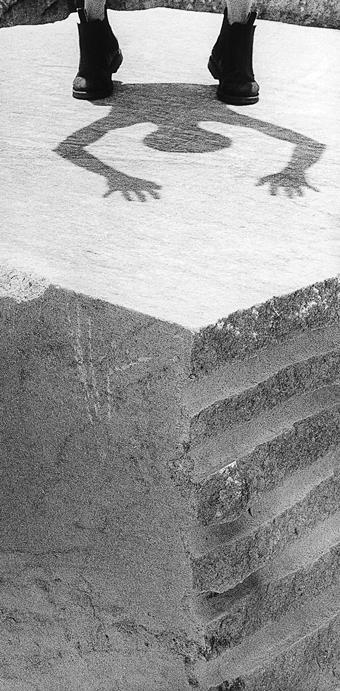
Bonemap
Bonemap the wild edge dance | screen | sound | image | object is a site-specific artwork emphasising the ephemeral body via the social and natural landscape. The artists interpret contrasts between the tropical Australian environment and the ‘wild edge’ of urban and built spaces. Exploring relationships of the moment and notations of identity and place sees performance, multimedia, exhibition, installation and sound composition merge into the wild edge. Available as discrete modules.
Challenges: reconnaissance and personal knowledge of sites; small crew multi-tasking in diverse and distant locations; meteorological and extreme environmental effects on technical equipment (sun, water, tiny insects inside camera lens); and stretching of human/technical resources.
Russell Milledge is an artist, curator and consultant. His performance, sculpture, installation art, interface design and multimedia work is collaborative and represented in the collections of Queensland Art Gallery and Cairns Regional Gallery. Rebecca Youdell is a choreographer and performer working in contemporary dance via site-specific collaborations involving multimedia, installation and performance. Collaborators: Glen O’Malley, Michael Whiticker and Paul Lawrence. info@bonemap.com.
the wild edge has been presented in Cairns and Tokyo and will be seen in Townsville in August and as part of l’attitude 27.5º at Brisbane Powerhouse, Septermber 9 – 25. Australia Council, Arts Queensland, The Choreographic Centre (ACT), Cairns City Council. www.bonemap.com
Joe Felber
25 Songs…
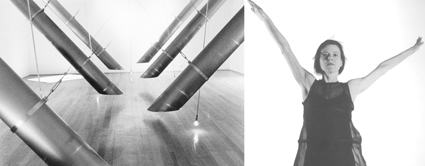
Joe Felber, 25 Songs, dancer Lucy Guerin
25 Songs on 25 Lines of Words on Art Statement for Seven Voices and Dance is a collaborative work between artist Joe Felber, composer Elliott Gyger and dancer Lucy Guerin, each of whom is responding directly to American painter Ad Reinhardt’s famous 25 Lines of Words on Art Statement. The 3 artists have created a theatre of response, reconsidering Reinhardt’s seminal 1958 writing on abstraction, art and modernism through the creation of a work combining music, image, video and dance.
Involving interdisciplinary arts practice and new media technology, the installation runs from the Cubase program. The video, stills photography and text graphics were created on Adobe After Effects and Premiere. The Pendulums run on a 12 volt magnet call from 2 transformers.
Joe Felber is an Australian citizen of Swiss origin. He completed an architectural draftsman apprenticeship in Switzerland and Master in Art (sculpture) at RMIT. His is a pluralistic arts practice including painting, photography, video and new media art. He has exhibited internationally since 1985 in New York, Europe and Australia.
This work toured Australia and Singapore and will be shown October-December 2001 at the Minioriten in Graz and Landesgalerie, Ladesmuseum in Linz Austria. Australia Council for the Arts, Pro Helvetia, Switzerland, Credit Suisse Group, Singapore.
PACT Youth Theatre
Replicant Hotel
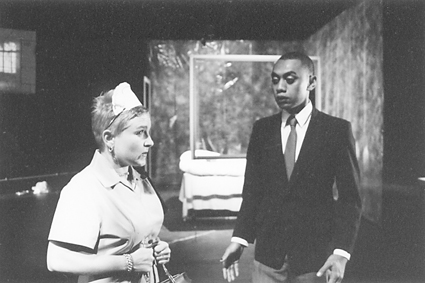
Replicant Hotel, PACT Youth Theatre
photo Heidrun Löhr
Replicant Hotel, PACT Youth Theatre
Replicant Hotel is a contemporary performance work incorporating collaborative writing and performance processes. The performance is layered with media archives or keyholes strewn about the hotel, a refuge for Replicants (read anything from Poe to Blade Runner).
Replicant Hotel centres on 5 figures abandoned by the 20th century. We have a Bell Boy (sometimes encountered in multiples) who is always intervening in potential wars with a calming soup. Voltaire, that populist journalist, is pronouncing revolution and croissants from his bedroom podium while cities crumble in the distance. Television Boy is locked to the Box, in love with the trickle of images that keep him awake at night. A painter is escaping his own portrait and a charming maid plays out movie scenes behind the curtains.
The challenges of this production include the integration of 5 distinct aesthetics supplied by 5 writers and the incorporation of pre-recorded “archives” (video, sound, film) based on the writing and performance making process. Novelist and dramaturg Mireille Juchau has been working with a small group of emerging writers: Shelley O’Donnell, Brian Fuata, Roanna Gonsalvez, Adrian Chiarella and Sarah Rodigari. Together they are plotting an intricate web of moments, each informed by a central figure that has fascinated them in the wake of the 20th century. This work is then fed into the performance group who interpret, rip and tear at the material to develop a performance labyrinth.
Collaborators: Caitlin Newton-Broad (director), Mireille Juchau (dramaturg & writing facilitator), Samuel James (space & media design), Gail Priest (sound designer), Richard Manner (lighting design).
Completion: August 2000. New Media Arts and Theatre Funds, Australia Council, NSW Ministry for the Arts, South Sydney Council.
Trash Vaudeville
Loose End
The focus of this new work is a process of experimentation using projected animation sequences and live performance. Animation, produced using clunky but vibrant analogue technology, is projected onto large screens and mixed with the live performer to tell a seedy story of finding desire and losing your mind. Two characters inhabiting the peripheries of gay life cross paths on the stroke of midnight. Loose End traces the ensuing havoc.
Trash Vaudeville
A work in development, Loose End is an investigation into the total integration of performer and projection. Animated sequences run across 3 screens. Some animations run solo, some involve actual highlighted spaces for the performer to become part of the animation and to interact with the projected characters. The work is quite literal in its methods of integration creating the effect of a cartoon character coming to life. The body/image integration works particularly well when the animations are used to stretch reality—when a cat transforms into a man, or the soul leaves a battered body and flies up to the heavens. The strength of the work is that the technology is used to expand reality, without losing the special vibrancy that can only be created by the presence of the living, breathing body on stage. Gail Priest
Direction, animation and performance Trash Vaudeville, sound & audio visual management Severin Sieben, set construction Chris Fox, lighting design David Darker. Performance Space, Sydney, July 15 – 17
The Men WHo Knew Too Much
Virtual Humanoids
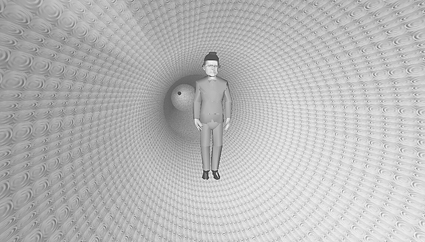
The Men Who Knew Too Much, Virtual Humanoids
Melbourne’s Planetarium as a performance venue was an inspired choice by The Men Who Knew Too Much. In this space Virtual Humanoids was a wondrous meeting of interfaces; electronic art and absurdism, screen and stage, live and virtual, human bodies and computerised voices. The venue’s white dome-shaped roof functioned as more than the computer screen: it enveloped audience bodies leaning back in their chairs angled towards the horizontal. Projected images floated across laid-out torsos and upturned faces. A disembodied humanoid voice as director seems almost a family familiar tucking us in for the night—Hal meets Star Trek’s Spock.
Enter 6 male performers. Writer-designer Simon Hill, Patrick Cronin, Louis Dingemans and Richard Gray, live, vertical, human-like in dark suits and heavy-rimmed glasses delivering pithy lines. Peter Eckersall appeared on-screen, often only in ice blue, pinkish outlines of his head. Music and VR creator Adam Nash played the hacker, Setarcos, live, seated, driving the images on the dome screen and emailing longingly to the only visible woman, Yasuka Yohama, who emails back that she is virtual. Performance director was Susie Dee.
Virtual Humanoids is an early 21st century reinvention of the variety show: jokey, blokey, silly, amusing, beguiling, techno-savvy and clever. Larger-than life images of Man in evolution up to the stage of ‘suits’ ringed the dome, a blue-suited, headless virtual singer cloned as wall-paper, a Martian selling white-goods, gigantic table settings, a cyber housefly at the cyber fly port. The net refracted through domestic life. The show performed the aesthetics of the internet surf, short fast grabs seemingly at random, except that The Men’s web search deliberately brought up cultural clashes and longstanding anxieties; dehumanised corporate men, robotic unthinking behaviour, a cross-dressed bride, an electronic maze.
Screen images alternated back streets and identikit houses, with abstract computer generated figures and patterns, several of which were sensationally beautiful mobiles and sensory tunnels. Hilarious web pages with extreme environmental messages pointed towards alienated ineffectualness—trees as information lists. If the show’s gentle humour highlighted the deliciousness of human opportunism and games in the dotcom world, it’s form linked the disembodiment of dotcoms to dehumanising corporate norms. The ideas are not new. They have a history as the nostalgic use of lines from 60s comedy attested. However, making connections between the web’s illogicality and its market driven commercialism is a crucial message towards awareness of the consequence of social life mediated by on-line languages.
Virtual Humanoids’ polished, stylised format integrated its digital imagery completely with live sequences. Electronic technology was used in the artmaking, not merely as the broadcast medium. I found myself silently disputing Philip Auslander’s claim that the televisual invariably dominates liveness. My attention roamed equally between the performers’ faces and screen images, perhaps because their bodies were in a life-like scale to my own in the second row but also because their faces were specially lit.
The production confirmed my view that much of the new media arts retains the distinctions of artistic disciplines. This work was clearly performed to and for an audience who like theatre, with even the obligatory participation when one spectator was singled out to be photographed and scanned onto a suited body in the virtual world. This approach is quite different to the stand-alone electronic screens in the visual arts where flat gallery walls become huge screens or miniaturised monitors are hidden in other objects or multiples function like mundane sculpture, for example the shopping-mall aura of Nam June Paik’s latest work. Or where galleries overseas must employ attendants to encourage visitors to interactively click and scroll the artwork on screens like those they have at work. Because new technologies are already so advanced in corporate and game delivery, and webcam broadcasting seems to have been co-opted by the sex industry, innovation in electronic screen performance needs to generate more than technological presence in image display or more immediate script access. At least New York computer installation artist Toni Dove and dancers like Company in Space ‘move’ the technology imaginatively.
Virtual Humanoids also offers an innovative approach with its comic expressiveness and captivating spaces that expose the failings, foibles and duplicity of these new technologies we love. Peta Tait
Virtual Humanoids, The Men Who Knew Too Much, Melbourne Planetarium, Scienceworks, July 19-30
RealTime issue #38 Aug-Sept 2000 pg. 15,17,18
© RealTime ; for permission to reproduce apply to realtime@realtimearts.net

Martine Corompt & Philip Samartzis, Dodg’em 1999
Cyber Cultures has been a huge project, a long evolving thing. Originally it was done through Street Level (the moveable Western Sydney ‘gallery’ Kathy Cleland founded with David Cranswick. eds) and we approached Performance Space and Casula Powerhouse. We were hoping to do a 3-venue thing. As it happened we didn’t get the funding we needed and the whole thing ended up happening at Performance Space in 1996. That show was so popular that we actually managed to get more funding and we did quite a large show at Casula the next year. It really got some new audiences out to the Powerhouse. It was a really big event for the organisation. It required a huge amount of equipment. Nevertheless, out of that grew the idea of doing something more sustained—hence Cyber Cultures: Sustained Release. Instead of having the big bang exhibition where everything happens in a month, we decided to have 4 smaller exhibitions over a longer period which would really help us to build audiences out west. We’re in the middle of developing the touring itinerary at the moment. We’ve had a lot of interest from all over the country.
What seems to happen with new media work is that it’s quite well supported in the more urban centres and the contemporary artspace organisations who’ve got a bit of equipment. But a lot of the regional galleries have very little…so one of the motivations behind the tour this time is to really focus on the regional—particularly regional NSW—and try and tie it in with some training for local staff in how to set up and run and maintain an exhibition like this. Questions I’m asking regional spaces are, do you have a local Apple Centre? Maybe your local council has a data projector? What about the library? So it’s not just going in, doing a show and going out, and there’s nothing left.
What about your choice of works? You have quite a few significant names, award winners, fellowship winners. Is this a kind of ‘best-of’?
I wouldn’t necessarily want to say it’s a ‘best-of.’ It’s a very personal selection. These are people whose work has interested me, some of them for a very long time, some more recently. It’s also seeing what’s out there, what artists seem to be interested in and the directions that the work is going.
In this first stage, called Infectious Agents, there’s obviously some commonality in terms of the idea of infection.
The way the work is being exhibited at Casula it’s all over the building. It’s in these discrete areas that you stumble across. So it’s a bit like the idea of a virus spreading. And I suppose in terms of the tour we’re sending out these little viral pods.
I noted that there are 2 relatively private spaces, one for Melinda Rackham’s Carrier, (see RealTime 37, page 23), the other an adults-only space for Linda Dement’s In My Gash (see Working the Screen page 6) and then a couple are out in the open: the very playful one by Ian Haig called web devolution: a mobile digital evangelist unit (1998) and John Tonkin’s Prototype for a Universal Ideology (2000) and Notes for a Collective Memory (2000) where the user gets into a compositional experience.
It’s been really interesting watching John Tonkin’s works in the gallery. People love them. You can listen to other people’s ideas—either their theory of life or a personal memory which they’ve recorded—and you can cut it up and start mixing and matching it with other things. People sit there for ages. You can see them thinking, no I don’t like that one, I’ll try another one—listening to all these different permutations…
“…forming a gene pool of ideas and memory” says the catalogue. How does Ian Haig’s very playful work fit your theme?
Cyber evangelism. It’s very much like a digital soapbox spewing forth all sorts of crank ideas. That’s how it fits in. The way that the internet and the world wide web have become these huge international fora for mad ideas and the way we’re constantly bombarded from screens.
Other works invite quite a degree of intimacy. Sometimes this can be quite uncomfortable. Navigating Melinda Rackham’s Carrier, you’re implicating yourself in the world of the work.
In the user-notes that accompany that work there are 2 suggested ways of going through it. One is navigating through the linked words at the bottom of the screen but the way you’re describing. which is the best way to do it, is to enter your name and the piece talks to you and asks you questions.
It says, “Hello Keith,” and you have to decide whether to take on the infection and live with the consequences. I was standing there, musing on it and someone standing next to me was saying, oh no you should keep going, move ahead. I said no, no, I’m just absorbing this. Carrier is interesting because it looks like a cross between an informational site with medical data …
… and an incredibly poetic space…
… with 3 dimensional objects rotating in space which appear to be the viral components. Linda Dement’s In My Gash, which has some of the most sophisticated imaging of the 4 works, is full of shocks and surprises, quick-time violence.
I had assumed that Linda would have preferred it to be more of a private piece and that maybe we’d be constructing some kind of housing around a single monitor so it was like a one-person-at-a-time viewing situation. But she’d actually done a few demos more like artists’ talks with the work projected, and she likes the projected quality. So that was her decision. But it is in some ways an uncomfortable piece to watch with other people around.
Next up in the series is Post Human Bodies which we’re launching with a new performance work of Stelarc’s—Movotar. The work’s been in development for a long time. At the moment the pneumatic arm is being constructed in Hamburg. Stelarc’s using an avatar creation, a virtual autonomous body that lives onscreen. That will be projected but the avatar becomes what Stelarc calls a “movotar” in that it can access his fleshbody in the real world. There’s feedback and interaction between Stelarc’s body and the algorithms that are programming the movotar. When they reach threshold states Stelarc’s body will be activated by the movotar driving the pneumatic arm. So it’s kind of a turnaround of the normal avatar where you have a virtual body that represents you in cyberspace. This movotar controls the fleshbody to access the real world. Stelarc’s maintaining control of his legs so he can remain upright.
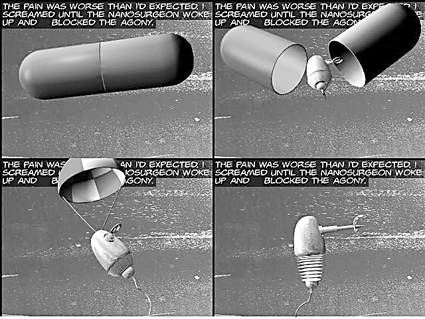
Jane Prophet, image from The Internal Organs of a Cyborg, 1999
Who’s triggering the action?
The movotar is autonomous. It has its own desires which Stelarc can respond to and override if they are becoming unsustainable.
Also in Post Human Bodies is a new work by Gary Zebington. As well as working with Stelarc, he’s been working on his own CD-ROM, Bodyssey, for a couple of years now. This will be its first public outing. I’m very happy to have the Lump CD-ROM, the project that Patricia Piccinini and Peter Hennessey have been working on for a few years. We exhibited Lump in 1996 Cyber Cultures. So this is the evolved CD-ROM project. Also there’s an international work by Jane Prophet called Internal Organs of a Cyborg which is like a comic book photo story. You know how when advertising agencies need images they go to stock libraries? Well Jane’s been using some of the same images which tend to be of elderly businessmen and beautiful young blondes. She’s created a story involving this woman who’s been a medical test subject for new drugs. There are all these ideas about the medicalised cyborg body. Also this elderly gentleman is about to have heart failure and her heart ends up going to him…The other work in Post Human Bodies is John Tonkin’s Personal Eugenics which has been exhibited in a number of spaces already but I just think it’s a wonderful work and one I really want to get out to the regions.
This is the one where you scan your face…
…and evolve yourself, decide which qualities you like, what you would like to become—more intellectual, more successful. And there’s a Java algorithm you can click on and it morphs your face in different ways. Then you pick the one that looks most like you’d like to be. And you can keep going. You can also play around with other people’s faces—based on what they say they want to be, you can help them evolve to their desired state.
How does Piccinini’s Lump fit in the Post Human Bodies scenario?
This is a completely digital world. The Lumps are digital mutant evolutions which are part human, part something else. When Piccinini was making this earlier on, the babies existed out in the world without a context. Peter Hennessey has created an architecture, like a factory or a museum. It’s like a Lump baby goes home. You go into the incubator and see all the facets of Lump life.
And the third show?
New Life is looking at crossovers between digital and biological life forms and how some of those boundaries are starting to blur. There’s a new work by Jon McCormack called Eden which is, as it suggests, a new world populated by entities that users interact with and help to breed. It’s an online world where you can create a herbivore or carnivore—its head, body and legs can be wheels or little spiky things and then you can track its existence, see how it gets on. I must confess when I tried it all my creatures died very quickly. Other people have had more success.
There are also some younger artists: Kathryn Mew’s Muto which, again, has been around for a little while now but this will be the first time she’s exhibited the work as installation and she’s always wanted to do this. She’s planning to project the work onto a huge weather balloon. Kathryn’s also working with little digital life forms and worlds that have organic as well as digital characteristics.
Anita Kocsis, like Jon and Kathryn, is a Melbourne-based artist. She has a new work called Neonvert which came out of an ANAT residency at Gertrude Street Gallery. It’s like a digital garden which Anita has largely developed on the web. The way she exhibits the work is via video documentation of that event and creating a physical installation around it. There are remnants of real garden and then projected digital gardenscapes. It’s not purely organic. She’s been working with Flash and some of the newer web software to help create it.
What about the final selection?
A fun family one we hope! It’s called Animation Playground and we’re exhibiting Martine Corompt and Philip Samartzis’ Dodg’em which has 2 push pedal cars you can drive round the gallery navigating via a soundscape (see RealTime 33). As you pedal, you trigger different sounds which let you know where various things are. Dogs start barking and you have to go somewhere else. It’s a lot of fun and the soundscape is a huge part of the work. It’s like animation sound meets amusement park. And the other works in that selection are Dream Kitchen, the CD-ROM from Josephine Starrs and Leon Cmielewski which was exhibited at Biomachines at the Adelaide Festival this year and as part of d>art00 during the Sydney Film Festival. What’s interesting about these artists is they’ve done so much work with different types of animation—stop motion, models, all sorts of things. People love it though some are a bit shocked at some of the violence…
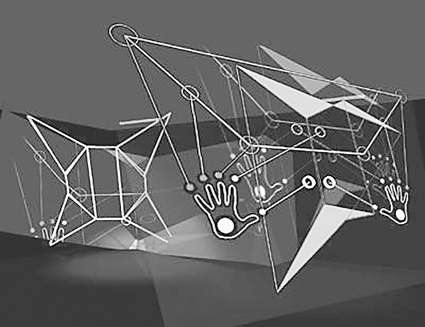
John Fairclough and Maureen Lander, Digital String Games 1998-2000
The pencil-sharpening scene is particularly scary.
…slicing open the rat. There’s a bit of dissection stuff but, you know, eminently enjoyable. There’s also Un-Icon by Mark and John Lycette which is a very simple but very beautiful animation. It takes different screen cursors like the little arrow or the blinking icon and transforms them in amazing animations. They’ll create their own shapes and then whiz off round the screen and then form into another shape altogether—magnifying glasses, arrows. It’s black and white and working very much with computer aesthetics. Very simple but really magical. We also have another work from Martine Corompt, a cute little thing called PetShop which has little animated animals scratching to get out of their TV monitors! And there’s another international collaborative work by Maureen Lander and John Fairclough. Maureen is a Maori artist and this particular piece is called Digital String Games 3. She’s created all these shapes which have cultural resonances for different peoples. They have Maori names but what happens when she leaves out the naming is that people say oh, that means this. It seems everyone has ideas about these shapes. John Fairclough has built an interactive program around it. There are digital handsets so you press buttons or coloured pads and you can create digital strings that link and build shapes as well. There’s an installation with threads that respond to UV light. So it’s a physical installation with a digital overlay. Apparently it’s quite complex and if you’re not successful, things dissolve. So you’re implicated in the cycle of creation and destruction.
As the curator of Cyber Cultures and Chair of dLux media arts, how do you see the health of new media in Australia?
I think organisations like dLux and MAAP in Brisbane and Experimenta in Melbourne are doing amazing things with really very small amounts of money. It’s quite difficult working in this area in NSW because the pools of money are pretty poor. The FTO (NSW Film & Television Office) for example and its staff like Sharon Baker are incredibly supportive but they have such small amounts to give out. It’s hard for us to look at something like Cinemedia in Victoria which has got substantial amounts of money. It’s fantastic what’s happening there and in Queensland as well. I’m a New Zealander and the Labor government there has just committed $86 million to the arts, the arts in general, over 3 years. Organisations like ANAT have been instrumental in supporting so many artists in this area, especially with summer schools and training. That’s been a huge factor for so many of the artists I’ve spoken to in the development of their work. There are some really good things going on in Australia but much more money needs to go into it. And into long-term support for work. It’s like everyone wants something now. And they’re more inclined to give money to a project that’s going to have a quick and very visible result in contrast to something that’s going to develop over a longer time. That’s where the Australia Council New Media Art Fellowships have been good in giving artists that 2 year period for a body of work. And it’s not tied to specific outcomes. Mind you, there usually are outcomes.
Cyber Cultures: sustained release: Infectious Agents, July 7 – August 11; Posthuman Bodies, August 19 – September 24; New Life, September 30 – November 12; Animation Playground, November 18 – December 22; presented by Casula Powerhouse Arts Centre, 1 Casula Road, Casula. Open every day 10am-4pm; www.casulapowerhouse.com/cybercultures [expired]
RealTime issue #38 Aug-Sept 2000 pg. 14-
© Keith Gallasch; for permission to reproduce apply to realtime@realtimearts.net
Annual MAAP festivals have become a notable fixture in the national and regional digital arts media calendar. After the rich collaboration with the Asia Pacific Triennial in 1999, MAAP 2000 centred at the Brisbane Powerhouse Centre for the Arts, is a deceptively smaller looking affair offering 3 days of concentrated viewing, interactivity and talk. There’s a screening program (SEE), interactive exhibitions (SEEK), and a forum in situ and online (SPEAK). The 2000 festival is both an affirmation and rethinking of MAAP’s role.
MAAP Festival Director Kim Machan explains, “This year we are directing a short and sharply focused physical festival with major labour pouring into the website! MAAP is working on a new emphasis for the organisation. We are building more content to attract and reflect the new media digital art community and progressing toward the full development of a meaningful new media digital art portal.” Machan is eager for “the web site…to develop as the major digital art portal for artists and our web strategies are predominantly in line with this goal.” She says that this next phase for MAAP has been driven by “streams of enquiries and demands for such a site.” Machan is eager to realise her goal in the next 12 months.
As for the 2000 festival, the opening on Friday September 15 will feature the launch of the new Singapore digital art portal artsvox and the world premiere of a new video work by Chinese artist Gongxin Wang.
On Saturday the SEE program will offer free all-day screenings in the Powerhouse Theatre of video/digital art with artists’ work from Singapore, Malaysia, China, Indonesia, Japan and Australia. The program includes new Chinese video; the Videotage selection from Hong Kong curated by Director Fion Ng; the dLux media arts d’art>00 interactive CD-ROM program; the 5th Malaysian video awards 2000; the Siggraph Singapore Chapter Animation Awards 2000; and the digital degrees student program from Australia and Asia-Pacific tertiary institutions.
Machan writes that for the SPEAK program there will be an all-day forum on Sunday, “with international panels in Brisbane and across the region to discuss and exchange issues presented by curators, theorists and artists. Panels will be netcast and streamed through the MAAP web site with online chats simultaneously open for interaction from international participants in Hong Kong, Seoul, Beijing, Tokyo and Australian cities.” This will be facilitated by international new media agitator Geert Lovink and co-coordinated by art and screen curator and teacher Molly Hankwitz,
In the SEEK program, MAAP will showcase a wide range of art and technology projects. The Chinese artists’ CD-ROM exhibition is being curated by Pi Li. Other works have yet to be announced. There’ll also be a sound installation by Adam Donovan. Russell Milledge will run a workshop based on his and Rebecca Youdell’s Bonemap—the wild edge, about site specific installation and performance with film and online art (September 16-17).
As in 1999, MAAP is again offering digital artists opportunities to display their work through links on the MAAP web site. The online missile launch project, featuring innovative web art from Asia. the Pacific and Australia, will be launched daily September 1-17. “Artists may also apply for free server space to host outstanding work. We are offering a ‘Free Tools’ section,” says Machan. “The website will also have a bulletin board, a chat room and, from MAAP research, extensive links with digital media organisations in the region.” Online computers will be available and projections continuously showing in the Powerhouse Bar over the festival. There’ll also be an informative Macromedia seminar.
Satellite events include Dodg’em, an audio interactive installation by Martine Corompt and Philip Samartzis at the IMA. New media artist Freya Pinner and mentor Di Ball will present [co]:installations, a multimedia show exploring notions of transgression between mediums, visual arts practices and between text and body relationships at Double Helix, opening September 9.
Kim says that the aim of the festival is “to create a presentation platform to promote excellence and exchange of creative ideas” and through “a dialogue between professionals who create, experiment, design and build electronic forms of art (to) focus on creativity and industry development.” The range of forms embraced by MAAP include new media installation, online artwork, digital animation, video, sound, photography, CD-ROM, and cultural internet projects.
Machan’s rallying cry is “See…Seek…Speak!” “SEE your work included in the online festival. SEEK out cultural content and people who are interested and curious. SPEAK your opinions and perceptions of the new media related world. We are at your server!” See you there, in the flesh or online. KG
MAAP 2000 Festival, Multimedia Art Asia Pacific Inc, Kim Machan Festival Director, http://www.maap.org.au. Venue: Brisbane Powerhouse September 15 -17
RealTime issue #38 Aug-Sept 2000 pg. 13
© Keith Gallasch; for permission to reproduce apply to realtime@realtimearts.net
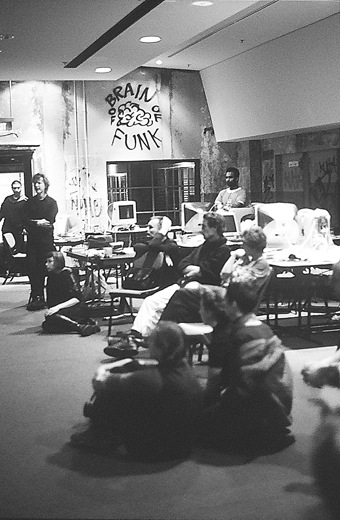
Alchemy
As her last major project for ANAT (Australian Network for Art and Technology), Director Amanda McDonald-Crowley planned and hosted Alchemy, a 5 week workshop presented at Brisbane’s Powerhouse (May 8 – June 9). In almost 5 years Amanda has expanded the scale and vision of ANAT, transforming its annual schools and international connections into something new and substantial, Alchemy, with its intensive workshops, forums and presentations with Australian and international participants and tutors. Amanda is now one of the growing team of Associate Directors for the Peter Sellars’ 2002 Adelaide Festival.
The first week of Alchemy was a set-up week. The sponsored equipment didn’t turn up until the Saturday before and doing it in a new building was pretty tricky too. It was a fantastic venue to work in: we had the run of the whole space. But it didn’t have any internet connectivity so we had to work with the Powerhouse to get that up. Getting the technical requirements out of the tutors was a pain. The best was when one of the UK group Mongrel said he needed 2 blow-up dolls. Cute, but not very useful.
You’ve run ANAT Summer Schools, what was the difference?
It was a lot bigger, 16 tutors, 46 participants, but never more than 26 there at any given time for a minimum of 2 weeks. In the future I’d insist on 3 weeks. Our Summer Schools have always been that and in teched-up venues belonging to organisations who sometimes use the schools as leverage to get enough equipment or set up a laboratory. By the third week people are using the tools and feeling familiar with them after being on a steep learning curve all the time.
We started out with art and science collaborations with tutors Nina Czegledy from Canada and Hungary, John Tonkin and Marko Peljan having just finished with Makrolab on Rottnest Island (RealTime 37, page 10). A lot of curators with some arts practice, attended this and there was a lot of discussion about public art and how you negotiate space and the overlap between public and private and then physical and virtual space. In the second week most of the Indigenous artists were there. I wanted them to be there at the same time. I think the bonding process is very important. Two of them, Christian Thompson and Jenny Fraser, had done the National Indigenous School in New Media Art last year that Brenda Croft had project-managed, so they mentored the 2 younger artists who had come from regional areas. That worked really well. They were doing a lot of digital imaging—Rea was teaching in that component—and work online, too, developing websites and building gif animations. A young guy called Chris Dempsey from Mount Isa is a cartoonist who’s never worked with computers and did some fantastic gif animations.
So the workshops are not focused on direct outcomes?
No. When people arrive, one of the first things I say is if you’ve come with a project you want to do, forget it now. It is about process, about what you can do. It’s exploratory, even moreso than the summer schools because there was a constantly shifting framework and negotiating with new arrivals, the people you’d be working with. I was there for almost all of it, except when I had to pop back to Adelaide for an AGM and a haircut. So I did a lot of hand holding. Having John Tonkin, who’s taught at the Summer Schools, and Rea who taught at NISNMA, was really useful. It was more difficult where the tutors hadn’t worked with us before. Then I did more hand-holding. The challenge is that it’s so formless—you arrive with ideas and talk it through.
In the second and third weeks we were looking at something ANAT’s been focussed on, ‘A Digital Region?’, what it might be, and the network of artists in our geographical region, mostly in Asia. Shuddhabrata Sengupta from India led some fantastic discussions. A majority of the international participants came from Asia and several from New Zealand. When I’m travelling I come across pockets of work in our region and there’s a sense that there’s a lot going on that you don’t know about. And it also comes from the frustration of going to the northern hemisphere to find that they’re convinced that the world is hemispherical and nothing exists below the equator…”So Australian artists make net art?”
Australians are well respected in this field and have great connections but it’s always with a complete lack of acknowledgment of the cultural and geographical differences that artists in our region here face…they think, ‘you’re kinda like us really.’ When Shuddha talks access, it’s a completely different way of thinking, it’s not about your computer at home not working or everyone having a connection, it’s much more about sharing and access. Seventeen people from the Raqs Media Collective and friends (part of the team setting up Sarai New Media Institute, New Delhi) shared the first computer they got and 32 people shared the email account. It’s also about printing out stuff from the internet and distributing it that way, a crossover between soft copy and hard copy.
Is this about collaboration within the region?
It can be about one-on-one collaborations. Graham Harwood from Mongrel said that it was the first time he’d been at an event with so many people from such diverse cultures who actually got beyond just cooking together, that people actually started to engage with what it might mean to work in cross-cultural ways. It was interesting that the fact that we were all working with new media was secondary to how we might work together. There were different expectations—someone like Raul Ferrera from Mexico arrived wanting skills—”You’ve got no idea what it’s like working in a Third World country, I don’t want to talk ideas anymore, I’ve done all this.” But he left feeling that the experience and connections had been rewarding. We did cook together and there were some fantastic meals.
Graham was at the school for 2 weeks and Richard Pierre-Davies and Mervin Jarman popped in and out a bit and did residencies elsewhere including with an Indigenous community in Cairns. Mongrel are all cultural ‘mongrels’ who do work with communities…like the Korean community in Bristol. They’re very generous, they’re not there to take anything away, they’re here to offer skills. They’ve developed a software called Linker, a bit like a Director hack, but very simple to use in order to allow participants in workshops to make their own stories, with images and sound and video, within a day or 2 of using it. Harwood gave a great presentation that had nice confluences—rather than teaching a piece of software he’s much more interested in people knowing about how software works. So he draws maps about grasping it conceptually. So even people with high-end skills in Director or Dreamweaver found it incredibly useful to go back to basics, to think about what is it you’re doing when you’re using a piece of high-end software. He also did a great lecture on the potato and its responsibility for the Industrial Revolution. That came out of some tense moments of cross-cultural discussion about what it means to have been colonised, difficult stories to be negotiated. We were talking about people a lot, so Harwood decided we should talk about potatoes. He’d also been commissioned to do a piece of web art work with the Tate Organisation (all of the Tate museums) so he hacked their entire site and re-told the stories and history of how the Tate came about. The Tate British is built on the ruins of a penitentiary built at the time of the hulks. So the site for Tate British was a key prison for transportation to Australia.
Richard and Mervin from Mongrel taught skills at the Murri school in the mornings during the DÄR Festival, the Indigenous arts festival that was happening at the same time.
What came next?
Performance and hybridity, but even earlier there had been a performative element with the curators. Earlier Sara Diamond (Director, New Media Institute, BANFF Centre for the Arts, Canada) had made everyone enact a game and it was one of the silliest things I’ve seen, all these curators and artists wandering around the Powerhouse looking like weirdos. They were broken into several groups, for example the designers looked at how you might think about the framework for a game. A lot of it came out of an interest in the history of the building we were in, the Indigenous site, the factory, kids playing in it and squatters after it was decommissioned. So Sara said let’s make a game about the building, a multimedia game which you can’t do until you’ve actually physically acted it out.
How far did this go?
It remained at the imaginary stage, but they went through how you get your head into the space to make a game. We rarely went straight to the computer. It wasn’t about sitting in front of the boxes all of the time. When Blast Theory (UK) came they did a digital karaoke workshop, a daggy way of stripping away the technology first before you think about using it. They then broke people up into smaller working groups and projects were again based on the building, developing a concept, bringing it back to the group. The following week, Tess de Quincey arrived and got everyone doing physical work in the mornings and conceptual project development in the afternoons with media artist and web designer Laura Jordan who worked with Tess on Triple Alice (RealTime 35).
What was the function of the physical work—getting into a state of mind or being before tackling the work?
That’s part of it, reminding ourselves that we have a body before sitting in front of a screen. Placing yourself in relation to the work but also the world around you. Sounds a bit warm and fuzzy, doesn’t it, but that’s what it was about, and it informed some of the projects. We had public events, 2 forums, a sound event, and then performances.
What kind of people came for the performance module?
Dance and movement people, Samuel James, stage designer and video, Vanessa Mafe-Kean, the PVI music collective from Perth, performance artist Peter Toy, Bruce Gladwin from Back to Back Theatre, Rebecca Youdell from Bonemap, Grisha Coleman from New York, Mike Stubbs a video artist from the UK, Kamal Krishna, performance artist from Brisbane. If anything, it was a bit too heavily balanced towards performers. The previous weeks had been much more cross-disciplinary with more skill sharing and cross-overs in working in totally different areas—a sound artist wants to be a visual artist for a fortnight working with digital manipulation. You don’t want people to go away owning a different discipline but knowing enough about it to be openminded about working with other people. But there was a lot of sharing, a lot of talk. A lot of show and tell. Laura would help people with technical skills, how to document work on the internet, how to use it. They didn’t walk out web designers, but they understood it. Participants became tutors for a moment. Sam James helped with video editing.
We invited the public in to show some of the work and I’d booked the Visy Theatre and the computer room, but the artists wanted to be outside the building, to use the lift (sound artist Sophea Lerner was determined to use it). It ended up like stations, each with a performative element. The aim of the audience that night was to find all of the 12 stations, to visit them each at least once. The Visy Theatre was used after all, a single computer sitting in a spotlight in the middle of the stage, next to a speaker on its back so that vibration would move the computer’s mouse and that would affect the interactive work on the computer. The rest of the sites were performative: in the lift people had to do things you wouldn’t normally do in a lift. Keith Armstrong I believe was good at getting far too close to people. When I entered the lift I suddenly knew that I would have to swap clothes with Mari Velonaki…with the help of a little girl. Kamal with Mike Stubbs did a video piece as a shrine. A sound piece was developed with sound artist Alexei Shulgin about a computer that only speaks computer language. You had to tell it something intimate about your life and it would come back with something as mundane as ‘System error 404.’ It’s about interactive sound pieces being about speaking very different languages. There was a great screaming sound installation with the lift and Vanessa playing the body. You could record your own scream.
These were works devised over 12 to 24 hours, they weren’t resolved so the audience didn’t get a slick performance—it was about playing with ideas, about networking and the participants are still chatting to each other on the list server we set up. From these schools people do get to work with each other years later and the international element of this one—the summer schools weren’t international—will have a long term effect.
How did you achieve support for Alchemy?
Last year we ran 3 workshops, one for curators with the AFC and the Australia Council, one for Indigenous artists in collaboration with the Australia Council and the ‘normal’ summer school. Because we’d developed our international connections so well, we’d get a lot of overseas interest about participating, but I’d have to say, no it’s funded for Australian artists. So we decided to go international and got money from the Daniel Langlois Foundation in Canada for the international participants, plus support from the Australia Council, the AFC, state governments, Macintosh and Choice Connections in Brisbane for the computers.
How many years were you at ANAT and was Alchemy a culmination of your work there?
Just under 5 years. Well it was a bit serendipitous. A few people made jokes, ‘Ah getting together all your mates and colleagues from across Australia and internationally to have a big party before you leave.’ In my job interview for ANAT I said I thought the summer school idea had run its course, tertiary institutions were starting up courses and now there’s a lot. But once I’d run some I saw that it was a completely different kettle of fish. It’s more about a masterclass environment, or perhaps I’ve turned it into that, rather than just skills-based.
You expanded the school model and ANAT to an international level. Was there enough strength in the organisation for you to build on when you arrived or did you have your work cut out for you?
It had gone through a lot and was at a bit of a sink or swim stage, and it didn’t get any money from Creative Nation, despite lobbying. Yes, I did have my work cut out for me. We worked closely with the Australia Council at the time. ANAT’s budget has now tripled, we’ve got fantastic support from the Australia Council, which comes as well from ANAT’s success prior to my arrival, giving the Council the courage to support it. And we’ve developed a relationship with the AFC on a project by project basis. We haven’t increased our infrastructure much (ANAT has 2 fulltime and 2 part-time staff). We have a national board and I think it’s remarkable that an organisation like this has grown up in Adelaide. And I’m pleased to say that for the first time ever that at the moment I’m leaving we’ve actually got core administration funding from the South Australian Government.
Why stop now?
I think it’s important for small organisations such as ANAT to have fresh input and ideas every few years. I’m stopping short of 5 years, and 5 years is all I’ve ever intended doing, because of the fabulous offer from the Adelaide Festival. We’ll all be working in a very collaborative way. I’m keen to see new media and technology fully integrated into the entire festival, not just for streaming what’s happening, but for community building and internet projects.
ANAT, Alchemy, Brisbane Powerhouse, May 8 – June 9, 2000
* * *
Alchemy wasn’t as I expected—full of tech-heads—but instead full of artists trying to find ways around the outside of technology or looking at technology from the outside-in. The title Alchemy I thought referred to artists pooling together all the parts of the world in order to create a new brew (with digital media as just one part of the collective terrain available to artists) and distilling down processes to find the intrinsic nature of communication and how we now think of it. It seemed that there was a lot of work being made (in the actual Alchemy workshops) that was about the means and the utilisation of the many available vehicles of communication. I know that the New Media Fund shies away from ‘discrete arts practices’ and Alchemy was the same. There was not much room for development of individual practices but more on communal exchange, personal exchange and thinking ‘low-tech’—can I make this performance/installation say what I’m trying to say without computers, or with a tape recorder or the existing potentials of the site or space, electronic or not. It was a bit like going to do a computer course and getting a massage instead. Then when you’re walking home each night you are often thinking, “Well, I feel refreshed, I feel human…” The course would be suited to being hosted by regional arts organisations, especially with the international participants. It was a very earthy course which is where I imagine Amanda believes our best resources are. Sam James
We flew into Brisbane from around the world and from within Australia, bringing our cultural backgrounds and experiences from a wide variety of media—coming together at the Powerhouse under the generous umbrella of new technologies. We spoke of similarities and difference, attempting to articulate impossible spaces while discovering new ones. We plotted maps to explore unfound territories, cooked magnificent feasts, invented crazy games, gained networks, enriched concepts, and strengthened and acquired new skills. Alchemy was an info surge, a completely invaluable experience. Megan Rainey
RealTime issue #38 Aug-Sept 2000 pg. 10
© Keith Gallasch; for permission to reproduce apply to realtime@realtimearts.net
Robin Petterd
Unsteady Motions
The visitor enters a dark space. An image of a tree being blown around in a storm appears. The visitor pauses to contemplate it. It freezes as they stop moving. They ponder the still image and the silence of the space in contrast to the turbulence of the storm. The image disappears. When the visitor moves the image erupts again.
The development of this piece has gone through many changes and explorations, different confirmations of images and sounds and responses to different types of movements. Constant technical compromises have had to be made between the image quality and the ability to process effects on the image in real time.
Robin Petterd’s recent web-based work has been included in events in Australia, Brazil, the USA and Spain. His move to installation work is relatively recent and is part of a research program at the Tasmanian School of Art, Hobart.
Completion November 2000
Sally Pryor
As I May Write
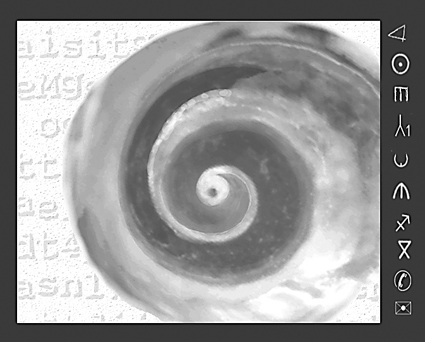
Sally Pryor, As I May Write
An experimental and interactive artwork about writing systems and the human-computer interface, this project explores histories (eg earliest graphemes, “Picture Writing” etc), contemporary visual languages (eg Blissymbolics, logos etc), relevant theories (eg hypertext, semiotics etc) and possible applications of “intelligent” icons in an interactive media space.
I am trying to create a hybrid form which combines advantages of CD-ROM (a bandwidth enabling generous/good quality images/audio; the creation of an actual physical object) with the immediacy, connectivity and changeability of a website. The other challenge is that I make art in order to find out what I think/feel about something. So I can’t do detailed technical and artistic planning before starting. I have to program it, “look” at it, re-program it, in a spiral process that works for me but makes team work difficult.
Sally Pryor is an artist/programmer and independent multimedia developer with an eclectic background including biochemistry and 3D computer animation. Her most recent work was the internationally award-winning CD-ROM Postcard From Tunis.
Completion June 2001. New Media Arts Fund Fellowship, Australia Council. A small web component exists online: www.ozemail.com.au/~spryor/write.html [expired]
Melinda Rackham
empyrean
empyrean is a parallel universe, an online multi-user virtual reality environment, an arena beyond space and time—the void where all things are possible, the realm of the spirit, embracing the folds of the soul, a soft world of gaps and intervals, fluidly traced and transversed by in-tensions, relations, attractions and transitions between energetic avatars.
The challenges of the work are in 3 phases: firstly, to build an elegant vrml space of low bandwidth and crossplatform and plugin compatibility for internet delivery by September 2000. Secondly, to have a stable crossplatform multiuser space for web performances by June 2001, and thirdly, to eventually port the online world into a hard space immersive virtual reality environment in a museum by late 2001.
Melinda Rackham is an artist and writer who has been constructing imaginal and hypertextual net.art in her domain www.subtle.net since 1995. She is currently undertaking a PhD at COFA UNSW, has widely exhibited her web works and published theoretical and poetic texts both in Australia and internationally, and recently won the Faulding Award for Multimedia for Carrier. melinda@subtle.net
Collaborators: Horst Kiechle (additional modelling and scripting), Mitchell Whitelaw (sound).
The website will be available for viewing in September. www.subtle.net
Lisa Roberts
Lillie’s Time Piece
A Victorian travelling clock opens to reveal a collection of memorabilia passed down by Lillian Williamson, frame maker and wife of painter Tom Roberts. Arranged within the 6 categories of meaning devised by Peter Roget for his Thesaurus, Lillian’s most treasured objects, her artwork, photographs and letters, are interlinked through a play on the written and spoken word through both scripted and randomly accessed voiceovers and text. Viewers are invited to read their own meaning into her memorabilia and pose questions about identity that might be expressed through the items we ourselves value and keep.
The technical challenges include keeping the hardware up to the demands of the data involved and optimising the script for seamless transitions and links between large files.
Tasmania-based Lisa Roberts, grand-daughter of Lillian Williamson and Tom Roberts, studied at the National Gallery Art School (later the VCA), Swinburne Film & TV School, and recently completed a Masters in Animation and Interactive Media at RMIT. Collaborators: Helen Rayment (curator), Ron Ngorka (composer), Ruth Luxford (programmer), Veronika Macnow (oral historian), Rosy Green (research assistant).
CD-ROM completion November 2000. Website under construction. Funded and sponsored by Gallery101, Queen Victoria Museum and Art Gallery, Macromedia, TechAustralia.
Roget’s Circular:
An Artist Book on CD-ROM
Peter Mark Roget wrote the Thesaurus, arranging words into Six Categories of Meaning so that the reader could bring order out of the chaos of thought and language. He saw that it was in their relationships to each other that words could approximate truth. A touch screen lies face-up in a suitcase, inviting viewers to participate in a dialogue between 2 travellers through 1999-2001, where Roget’s categories provide the framework for engaging with imagery, sound and text collected throughout their interconnecting journeys via email.
The challenge here was to design and program a navigable interface within which to interconnect the journeys of 2 travellers, as well as to involve the viewer in their own enquiry. An organising device developed at the turn of the last century is being appropriated and extended to incorporate the generation of random image, sound and text within a series of interconnecting calendars. Collaborators: Melissa Smith (visual artist/composer), Ruth Luxford (programmer).
Completion November 2000. Macromedia, TechAustralia.
Kristian Thomas
Pseudo sound project
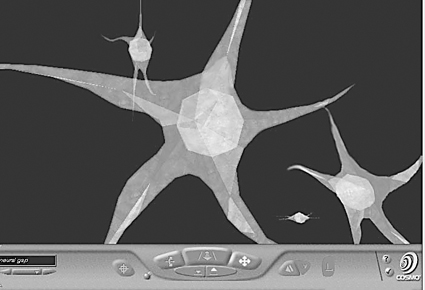
Melinda Rackham, empyrean
Pseudo sound project: you hear only what you want to hear is about sitting back and listening to weird techno-music, a focus very different from the typical nightclub scene. It will engage the eyes as well as the ears, as sounds are developed by interactive and/or graphic means, with hypnotic displays (sometimes called “eye candy”). The challenge is to program music into a computer, to make video, and make both simultaneously (not to mention faster).
When Kristian Thomas was 7, he ‘ganked’ his older brother’s “good at the time” Casio keyboard, and would place heavy objects on the keys to warm it up for a while. Today, studying at the School of Art, University of South Australia, he uses digital equipment that can be given its own consciousness, so it can warm itself up. Collaborators: I Candy is a group of mainly sound artists performing together in Adelaide, including Greg Peterkin (eyespine), Echelon, Dan freak, Trip Wire, Cooper Black and Free the Radical. kristianthomas@hotmail.com
The work was given a first hearing June 23. Online Mp3 and Mpeg works available at kristianthomas.jumptunes.com [expired]
John Tonkin
Prototype for a Universal Ideology
“Tell me a theory on life. It could be grand or mundane, advice your parents told you or a heart-felt belief.”
The spoken voice of each user becomes the raw material for a process analogous to the genetic recombination of DNA. The audio waveforms are broken down into fragments and rearranged with the phrases of other users. Users can breed different statements and decide which new recombinant statements survive, and consequently how they develop collaboratively over time to form a gene pool of ideas and memory.
John Tonkin is a Sydney-based artist who began programming and making computer animation in 1985. His current works involve building frameworks/tools/toys in which the artwork is formed through the accumulated interactions of its users. In 1999 Tonkin received a fellowship from the Australia Council’s New Media Arts Fund. He is currently working on Strange Weather: a grand unified theory, a visualisation tool for making sense of life.
Prototype for a Universal Ideology is being developed as part of Cyber Cultures’ Sustained Release: Infectious Agents, Casula Powerhouse (see interview with Kathy Cleland). www.johnt.org/projects/prototype.html
Mari Velonaki
Mutual Exchange
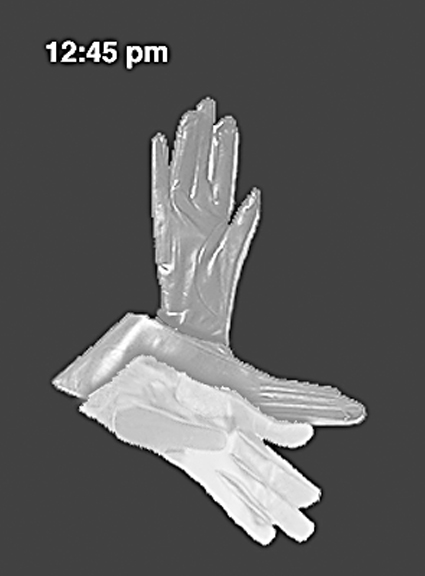
Mari Velonaki, Mutual Exchange
Viewers wearing coloured cotton gloves engage with projected characters by signalling to them. The reactions, moods and life span of the characters are effected by the participants’ gestures, distance from the screen and the colour of both their clothing and the gloves of choice.
The integration of genetic algorithms and a robotic optical recognition system is the challenge, one amplified by the necessity of translating UNIX-based software and hardware into a Macintosh environment.
Mari Velonaki is a media artist with a performance background. She aims to engage spectators with digital characters in interplays activated by sensory triggered interfaces (breath activated, speech recognition, artificial vision systems). Her work has been shown at Artspace, PICA, Sciencentre of Queensland, IMA, Kunsthalle Prisma, Ton and Bild Spectakel. Collaborators: Gary Zebington (graphics & programming), Shannon O’Neill (sound design).
Completion December 2000. New Media Arts Fund, Australia Council; Newton Research Labs, USA.
Martin Walch
Mt Lyell Copper Mine
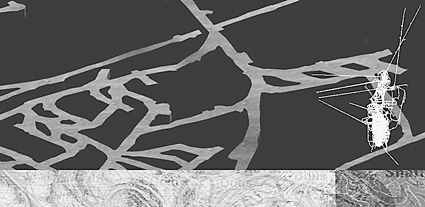
Martin Walch, Mt Lyell Copper Mine
This animation explores the visual and aural spaces both above and below ground at the Mt Lyell Copper Mine in Tasmania, combining topographical modelling, historical and contemporary photography, and recorded sounds from the site.
Immensely challenging, the project has given me the opportunity to extend my arts practice from a static photographic basis to a visually and sonically animated one. At the same time, working with a mining company during a volatile period in its history has presented another set of challenges that have influenced my work.
Martin Walch is a visual artist and writer, living and working in Tasmania. His formal studies include an Honors Degree in Photography and a Master of Fine Arts Degree (by Research) in Digital Stereoscopic Imaging. He is particularly interested in the interactions between people and the physical environments they work/live and recreate in.
Completion November 2000. New Media Arts Fund, Australia Council; extensive in kind support from Copper Mines of Tasmania.
Gary Zebington
Bodyssey
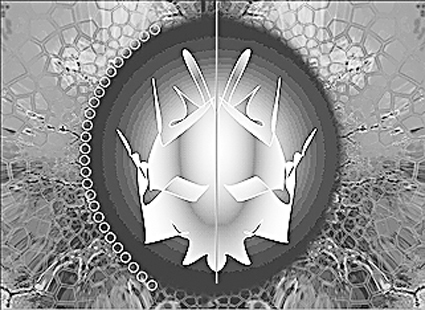
Gary Zebington, Bodyssey
This work chronicles modified phases of the human life cycle. Biotic engineering and older myths of transformation promise freedom from the ancestral, deterministic life cycle. Borrowing form and process from tales of real and invented species, we wander a continuum of bodily experience, through conception to reincarnate uploads into dataspace.
Challenges include: intertwining sound, speech recognition, text-to-speech, vrml, responsive texts and 2D image environments into parallel coherence (eased by the life cycle’s natural narrative); transmuting image matter via inscriptions and conjurations; casting aside notions that form follows function and that sufficiently advanced technologies and magic are indistinguishable.
Gary Zebington converted from painting to digital media in 1990. Graphics and programming have featured in large-scale robotic performances, fibre-optic television, websites, CD-ROMs and international installations. He holds BA, IBM Broadband Scholarship, postgrad Design Computing and has been engaged in the design and development of experimental medical software at Sydney University since 1997. He rarely encounters steering committees. Collaborators: Gary Zebington (graphics, programming, text), Andrew Garton (sound designer), Gina Fenton (producer), Philipa Veitch (researcher).
Completion October 2000. Australian Film Commission.
RealTime issue #38 Aug-Sept 2000 pg. 9,12,13
© RealTime ; for permission to reproduce apply to realtime@realtimearts.net
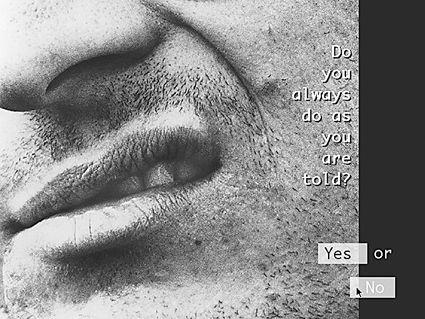
Josephine Starrs and Leon Cmielewski, User Unfriendly Interface
Tertiary institutions everywhere are setting up new media departments, their computer labs bulging with students eager to skill up for the 21st century in which it seems everyone wants to be a web designer.
Courtney Love, recently writing about music pirating, posted to a list serv:
I have a 14-year-old niece. She used to want to be a rock star. Before that she wanted to be an actress. As of 6 months ago, what do you think she wants to be when she grows up? What’s the glamorous, emancipating career of choice? Of course, she wants to be a web designer. It’s such a glamorous business!
Glamorous? Well certainly ubiquitous, the landscape is littered with URLs. Bus and taxi backs point to insurance websites, graffiti points to net.art sites, Telstra has back buttons on their billboards, the accepted interface norm dumbs down another notch. The web is the area where students know they can get work right now, in spite of some employers’ proud boasts of huge burn-out rates; if you look remotely like a plug’n’play pixel monkey, you’re in (for the moment anyway). We wonder about a time when every business has a website, there’s a glut of people out there with web skills who can’t get work and nobody knows how to bang a nail into a piece of wood, or use a welder.
According to Kathy Cleland, new media curator and lecturer:
There is a huge student demand for courses at tertiary institutions which have anything to do with multimedia and this is increasing exponentially. An introductory multimedia course I taught at the beginning of 1999 had 30 students; the same course this year had 95 students. There is also a tendency in full fee paying institutions to over-enrol students to maximise profits which leads to very large tutorial sizes and consequently to staff burnout with huge marking loads. I have been teaching at an institution (half university owned and half corporate) that has 4 semesters per year so there is also very little time for research and skills upgrading.
The difficulties in teaching digital media arise from the breadth and scope of the area. Due to its hybrid nature and links with cultural studies, communication theory, visual design, visual arts, computer science, film studies etc, new media projects typically require a vast skillset and cover a range of considerations which are not necessarily able to be delivered within the one faculty (as lines are currently drawn) or indeed by the one student. This is why it is particularly exciting for us that the School of Design, University of Western Sydney, Nepean is potentially merging with the Communications and Media School. Students currently can choose to undertake subjects across school lines, but it is difficult to “synthesise” school approaches. As new media becomes less new and more consolidated in its own right, we will see some of the moving targets come into focus enough to better track them.
The pedagogical dilemma is the fact that the ‘mission statement’ doesn’t yet exist. There is no agreed canon. It’s too early to be able to draw on a history of interactive media, as we have for film and TV. But then again, that’s often the attraction. It’s new and uncharted, with a plethora of opportunities for innovation.
There is a strong trend towards online education, which makes life easier, or at least more efficient for both students and teachers. List servs can be an extremely useful teaching apparatus, enabling the whole group to communicate their ideas to each other, and also for lecturers to give feedback easily. Online education is going to be a huge growth area and will ultimately challenge the traditional university structure. The fees charged for these courses are much lower than current student fees and you can do a course with the university of your choice anywhere in the world. There are also a lot of corporations looking at education as a vast, extremely lucrative untapped market—so education is not going to remain the exclusive property of universities for much longer. A friend who recently moved to Canada to take up a university teaching position wrote describing a rather dystopian vision of future online education:
Moving to Canada was a mistake because the university I came to is trying really hard to be like a corporate online course farm…I have to be managed and work in a cubicle.
Here it is often visual artists who are teaching digital media in design schools. Practitioners have a wide practical skillset acquired through an exploratory approach to self learning as well as from working in different roles on varied projects, and are experienced in collaborative working models. In our own practice, the aim is to teach people to integrate their creativity more deeply into the computer environment as well as to teach within a cultural context. We encourage practical teamwork as well as learning the toolset, which is an easier task in design than fine art. The fine art world, for all its postmodern rhetoric, is generally trapped in the modernist paradigm of artist as lone lone hero. Consider the promotion of young British artists (or YBAs as they are known) by the advertising firm/art collectors/government consultants, Saatchi and Saatchi, in London. These artists are like popstars, the more famous and controversial the more likely they are to sell their work. And now there are billboards at Heathrow airport of Tracey Emin selling Bombay Sapphire Gin. First artists become products to be promoted and, when famous enough, they can be used to sell other products.
New media artists tend to be critical of the current fine art institutions. We like to employ a hacker mentality in our approach not only to technology but systems in general, whether they be social systems or ‘the media’ themselves. Our interest in the area of new technologies is fuelled by a mixture of scepticism (who is excluded from technotopia and why would anyone want to live there anyway?) as well as enthusiasm for the playful possibilities of digital media. Our own work which includes the User Unfriendly Interface, Paranoid Interface and the Bio-Tek Kitchen game patch deconstructs current interface and game paradigms, subverting them to reveal that our experiences are being increasingly mediated by new technologies and that there are dangers hardwired into this trend.
At UWS we introduce students to different online and gaming cultures, cyberfeminism, hacktivism, and ‘Tactical Media’, which is the rather slippery term used to describe the practices of a loose alliance of international media theorists, artists, designers and activists. We also expose people to the enormous amount of interesting and playful work which is being made around the globe. Often what excites the students excites us and, as play and pleasure have always been an integral part of our work, we encourage people to do the same and sometimes get great results—work which can inspire and entertain us all.
Josephine Starrs and Leon Cmielewski are artists and lecturers in new media at the School of Design, University of Western Sydney, Nepean. Their latest work Dream Kitchen is an interactive stop motion animation CD-ROM. See Working the Screen
Thanks to Robyn Stacey and Sarah Waterson (School of Design, UWS Nepean) and Brad Miller (College of Fine Arts, UNSW), for their valuable input into this article.
RealTime issue #38 Aug-Sept 2000 pg. 8
© Josephine Starrs & Leon Cmielewski; for permission to reproduce apply to realtime@realtimearts.net
Richard Adams
Clem’s Big Scary World
This is possibly the world’s first surreal encyclopaedia on CD-ROM made by a paranoid 93 year-old from Bluebottle Beach on the NSW Central Coast, and possibly the last one too. The big challenge was for one determined pensioner to produce a title with as much material and educational credibility as something like Microsoft’s Encarta. Now Microsoft will no doubt have to hire another 500 researchers to ensure their title stays as informative as Clem’s Big Scary World.
Clem was born in Bluebottle Beach 93 years ago and has never, ever left the place. His hobbies include toast collecting and worrying about a giant tsunami wiping out his town. This CD-ROM is his first brush with technology since buying his trusty old toaster in 1956.
Matthew Beer of Big Stick Productions (www.bigstick.com.au) provided the graphic design, most of the programming, and many of his own images. Richard Fox and Adam Hinshaw assisted with programming, Alex Davies assisted with sound, Robert Adams and Louise Fox provided Clem with his research.
Release July 2000. Australian Film Commission. Website early September: www.bigscaryworld.com [expired]
Keith Armstrong
t_lounge
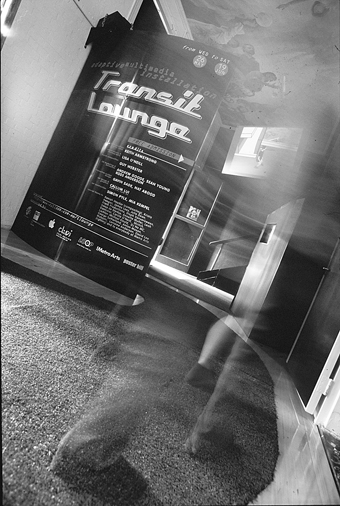
Keith Armstrong, t_lounge
t_lounge substantially reworks a low-budget interactive installation called transit_lounge (1) originally produced for Brisbane’s Metro Arts foyer in mid 1999 (RealTime 32 page 29). t_lounge’s installation space allows audiences to have important but indirect effect upon a dual screen continuous non-linear narrative. The work features 10 characters performed, at times simultaneously, by Lisa O’Neill.
This ongoing practice seeks to develop an ‘open’ framework for site specific ‘new media space’ design which fosters participatory, creative processes between audience and artists. Aiming to avoid direct causal interactivity, it acknowledges systemic or ‘ecological’ operations, and promotes a strong aesthetic and intellectual response.
Keith Armstrong is a Brisbane-based artist with a long history of producing site specific, new media installation and performance works for public places. His major collaborative works have been shown extensively in Queensland in places such as the historic Spring Hill Baths, Platform 1 of Brunswick Street Railway Station and the Metro Arts foyer. Collaborators: Lisa O’Neill (performance direction), Guy Webster (sound), Gavin Sade, Annette Muller, Sean Young, Callum Lui.
Artspace, Sydney, August 10- September 2.
Paul Bai
Greetings from Chinatown
Greetings involves 9 postcards which will be featured on the MAAP website in September as e-greeting cards. The work focuses on the collapse of physical distance between people made possible by modern communication technology while the cultural and social distance remain the same.
The challenge has been to use Macromedia Generator to turn the artworks into electronic greeting cards on the webpage, so people can write text on the e-cards and send them to others on the net.
Paul Bai arrived in Australia in 1988 and studied fine art at the Queensland College of Art. In his work he examines the cultural and political roles of the Chinese in contemporary Australian society. He has had exhibitions at Gallery 4A and the Institute of Modern Art, Brisbane City Gallery and a public installation in Brisbane city.
Arts Queensland. Site launched as part of MAAP2000 Festival September 1 – 17, www.maap.org.au
Tracey Benson
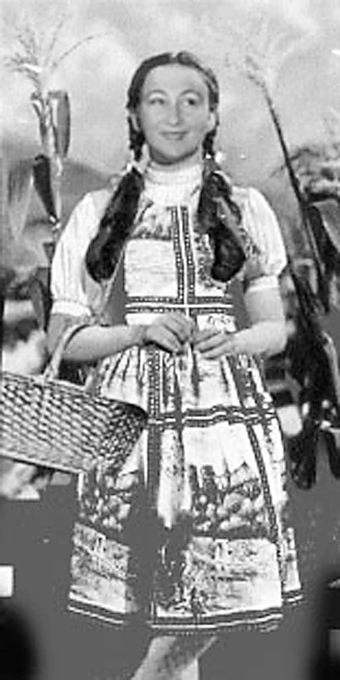
Tracey Benson, Dotty’s tour of Oz
Dotty’s tour of Oz
Dotty’s tour of Oz is an online mystery maze, an Australian landscape through which the user travels as a lost tourist, Dotty, a Judy Garland-like figure trapped in an eternal childhood. The technical challenges are in expanding the web version into an interactive CD-ROM game.
Tracey Benson is a multimedia artist and curator whose work has been presented in the USA, England, Ireland, Netherlands and Russia. She recently exhibited work in the Experimenta Media Arts online gallery, N5M3 (Netherlands) and MAAP’99. She has been artist-in-residence with the Cowgrrls.com project at Cooloola Shire Gallery and lectures part time at the University of the Sunshine Coast in the computer-based Art and Design faculty. Collaborators (CD-ROM): Danny Guinsberg (multimedia artist), Ross Barber (sound artist), Linda Carroli (catalogue writer). traceyb@thehub.com.au
Completion September 2000. Evolution can be viewed at www.bigbananatime/dotty.htm [expires]
Paul Brown
chromos
chromos shows the complete expansion of a set of 4 marks over time. The work is created on-the-fly and so does not show any repetitive behaviour and is different every time it is viewed. It exists on the screen of a computer as either a web-based Shockwave piece or a free-standing CD-ROM application. chromos also includes a set of 8 prints known as The Book of Transformations. To date, the work has consisted of tedious hand-crafting to create the display engine. Ways of building on artificial intelligence or artificial life processing in order to give the piece some behavioural intention are being investigated.
Paul Brown is a New Media Arts Fellow of the Australia Council and artist-in-residence at the Centre for Computational Neuroscience and Robotics and the School of Cognitive and Computer Sciences at the University of Sussex. He is based in Queensland. Collaborator: Gavin Sade (lingo code).
Completion late 2000. New Media Arts, Australia Council.
www.paul-brown.com/GALLERY/TIMEBASE/CHROMOS/INDEX.HTM
Anthony Christou
Yenam
The goal for this crazy, deconstructive and surreal cartoon is to create 3 movies at least 5 minutes long that break the boundaries of what people imagine cartoons to be. The movies are Flash animations for the internet, some 3 dimensional and some 2-dimensional.
Anthony Christou is an emerging visual artist who works in digital media and is a Flash website designer.
Completion December 2000. The storyline and characters can be viewed at www.arcomnet.net.axu/~christou/yenamweb%20pages/yenam.htm [expired]. A series of animations deconstructing Yenam are at www.arcomnet.net.au/~christou/yenam.html [expired].
Martine Corompt
Wild boy
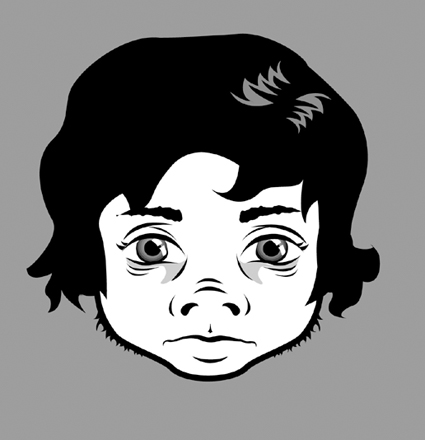
Martine Corompt, Wild Boy
This installation combines sculpture, animation and a pop song, drawing on the yearning and sense of loss that is the hallmark of the sad pop song/ballad. Exaggerating this sentiment, the singer is an animated singing head in the form of a ‘wild’ half human/half beast. This 2 dimensional character without a body and presumably also without a soul, is all the more tragic for its Frankensteinian predicament, being ‘brought to life’ (via animation and song) without history, purpose or consent.
Martine Corompt’s work combines elements such as drawing, video, sound, sculpture automata and, sometimes, computers. Works include Sorry (1996), PetShop (1998) and Dodg’em (1999) which is touring Perth, Brisbane and Sydney this year. She currently works at Media Arts RMIT, lecturing in Experimental Animation and Interactive Installation. Collaborator: David ‘HoneySmack’ Habberfeld.
Wild boy will be exhibited at the Centre for Contemporary Photography, Melbourne, November 23 – Dec 16, 2000.
Daniel Crooks
inside-out; control
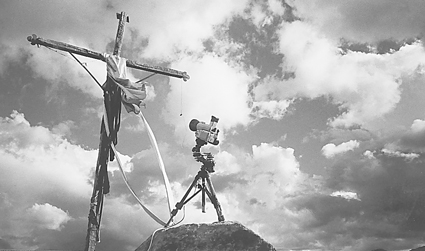
Daniel Crooks, inside-out; control
The aim with this installation is to use the data streams (the rhythms and patterns) of our environment as the direct means of spatial and temporal camera control. The flow of a river modulates the pace of a track-mounted camera. The temperature of a decaying animal controls the frame rate of its own timelapse. The endless flow of numbers tapped and rerouted offers new perceptions of the processes by which they are generated.
The major technical challenges are primarily due to budget constraints. Cheap, custom developed options are usually a little more tricky to get up and running than the expensive, off-the-shelf variety. Learning a programming language is harder than paying someone else who already knows it.
Daniel Crooks trained as an animator and graphic designer. His short films, video and interactive work have won several major awards, including a Dendy Award, an ATOM Award, and the City of Stuttgart Prize for Animation. Following an Australia Council New Media fellowship at RMIT in 1997, Daniel’s work has become increasingly focused on temporal manipulation and motion control, exploring the nature of time, space and environmental actuation.
Exhibition early 2001. New Media Arts Fund, Australia Council. dlab.com.au
Ross Gibson, Kate Richards
Life after Wartime
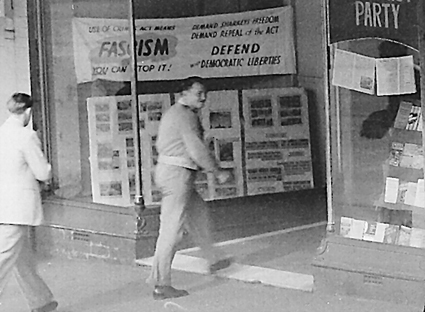
Ross gibson, Kate Richards, Life After Wartime
Life after Wartime is a CD-ROM which brings to light the legacy of a city’s recent past. A story engine produces countless montages of thought and feeling from mysterious forensic photos, evocative captions and musical sound effects. As we follow our curiosities and compulsions, we piece together larger patterns of stories and historical notes that offer ways to account for the photographs. The challenge is in using archival material so that it suggests its own interpretations; straddling documentary and fiction; creating fast, malleable faux 3D space as a metaphor for the consciousness of the story-recipient.
Kate Richards is a freelance multimedia producer and artist. She has exhibited nationally and internationally and is currently a Research Fellow in New Media at UTS. Ross Gibson is a writer and media artist who is currently the Creative Director of Cinemedia’s Screen Gallery, Victoria. Collaborators: Kate Richards (producer), Ross Gibson (writer/director), Greg White (programmer), Aaron Rogers (designer), Chris Abrahams (composer).
Completion, August 2000. UTS Internal Research Grant; Australian Film Commission.
RealTime issue #38 Aug-Sept 2000 pg. 4-5
© RealTime ; for permission to reproduce apply to realtime@realtimearts.net
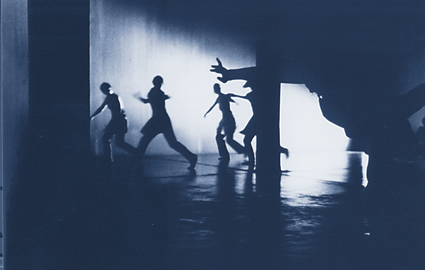
Accumulation
photo Heidrun Löhr
Accumulation
We’ve been watching Rosalind Crisp for a good while now. As a dancer-choreograher she’s made more than her share of moves but always with a strong through-line and serious attention to research and careful development. We have followed her trajectory through many solos including a continuing persona in The Lucy Dances, dance theatre works like The Cutting Room, dance-music collaborations such as Proximity (with Keiko Takeya Contemporary Dance Company, Tokyo). We’ve enjoyed her evolving collaboration with composer Ion Pearce, her dialogue with dancer-writer Eleanor Brickhill. More recently she has concentrated her attention on choreographing for an idiosyncratic company of young female dancers and herself called stella b.
accumulation (1-40) showed us a further development of an ongoing work which we last saw at Artspace in January this year (The View From Here). In this latest version, as well as the core dancers, Crisp has opened the process to a broader range of bodies. An advertisement was placed for people interested in participating. 30 turned up and most of them appear in one magical sequence in accumulation. They arrive quitely en masse, lend a different weight and texture to the work with their graceful (mostly non-dancer) bodies, then leave. Watching them work in unison is a strangely moving experience.
Observing the evolution of this dance, you venture a possible direction for the next version. In accumulation, drama lurks at the edges of abstract scenarios. The program notes, “Two feet are visible in the half light, working the floor. In another space a solo dancer inverts a dance she knew before.” Ion Pearce’s score, this time recorded, seems a little less Zen, more obviously and insistently rhythmic. Richard Manner’s lighting is quietely dramatic marking out evocative spaces. You sense it wouldn’t take much for the dance to tip-toe into the theatrical without surrendering any of its choreographic seriousness. Some of the performers project identies, even palpable personalities. Being caught by Nalina Wait’s intense gaze or watching Eleanor Brickhill’s concentrated dance of tiny adjustments and changes of mind, it’s hard to see them as purely formal presences. At the same time, this is a work about dancing—it’s constructed in layers, it’s arithmetical, cumulative. And all is revealed in the penultimate sequence when some of the intricate patterns are unpicked by the dancers in a line-up in which a series of interlocking, accumulative gestures slip in and out of synch. It ends with a solo of articulating joints. It’s dance we could watch for hours. We await its further unfolding.
–
Rosalind Crisp, stella b. and guests, accumulation (1-40), the outcome of a Performance Space residency; choreography and direction Rosalind Crisp, dance and solo material Eleanor Brickhill, dance & treatment of material Nalina Wait, Kathy Macdonald, Danielle van der Borch, Bronwyn Ritchie, Laurie Foster, sound Ion Pearce, lighting Richard Manner. Performance Space, July 13 -16.
RealTime issue #38 Aug-Sept 2000 pg. 14
© Virginia Baxter; for permission to reproduce apply to realtime@realtimearts.net
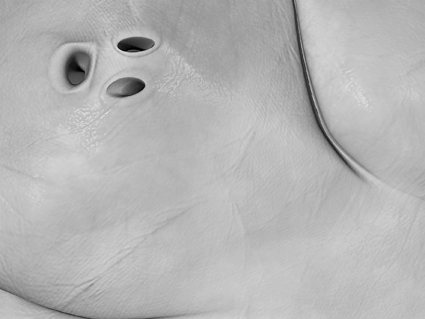
Patricia Piccinini, Breathing Room
With the increasing prevalence of new media work being shown in galleries, installation design is an important area of concern for both artists and curators. Because of the ease with which digital media can be modified and reconfigured, new media works can be exhibited in a variety of formats to suit different exhibition and viewing situations. While many new media works have been created specifically for the web or CD-ROM, these works often achieve parallel lives as gallery installations. On the other hand, the ease of distribution is a double-edged sword as artists relinquish control of how that work is viewed and used. As media artist Leon Cmielewski comments: “the jukebox format encourages people to skip to the next work. [CD-ROMs] take an extraordinary amount of time and effort to compose and I feel everyone’s work deserves at least an even chance when it comes to presentation.”
For this reason, and when given the opportunity, many artists prefer to exhibit installation versions of their work, most frequently using data projectors and sound systems to amplify the work and create a more immersive cinematic environment than is possible via a computer monitor with in-built speakers or headphones.
Spectrascope (Sydney Biennale, Performance Space) co-curator Julianne Pierce says: “Generally speaking, an interactive work exhibited in the context of projected installation is more directly engaging than the same work exhibited on a monitor. The projection will often enhance the image, giving it a more cinematic quality.” Nevertheless, despite the current preference for projected work, bigger is not always better. The large screen experience can prove intimidating or embarrassing for individual users, particularly when they are not sure how to navigate the work or are being required to type in responses while being observed by other audience members.
Another more intimate option is to create custom built installation housings or kiosks such as those made by Ian Haig for his works Hack and Web Devolution, Haig writes, “…nothing is more unengaging than a Mac on a table or a plinth for displaying interactive work. Installations that house the work can give things a much wider context to operate in.” In many cases the nature of the work itself will suggest a particular mode of presentation. Leon Cmielewski says of The User Unfriendly Interface (created with Josephine Starrs) that “in places it used a very intimate interrogation and so we thought a one-to-one kind of experience like that should be housed in a kiosk which precluded more than one person using it and also encouraged people to answer the questions without the embarrassment of having an audience watching their responses (or typing skills).”
Unlike works that are viewed privately, where it can be assumed that the viewer is reasonably computer literate and has a high degree of motivation and commitment, none of these things can be assumed in the gallery context. User navigation guides or help information (as a gallery sheet if not onscreen) can overcome some of these barriers. Time-outs, when the work returns to a home screen after a set period of disuse, or ‘home’ buttons are also helpful in orienting gallery audiences who will often not be entering the work where the artist intends them to start but somewhere in the middle—often at a tricky part that’s hard to get out of!
Another consideration for artists and curators is the length of time audience members are likely to spend with a work in a gallery. Five to ten minutes with an individual work is probably a generous estimate; many will spend considerably less! Interactive multimedia producer and artist Kate Richards thinks that pieces requiring a short time commitment from the player (3 – 6 minutes) are coming into their own. “With Darkness Loiters (Sydney Suburb, in Museum of Sydney, 2000), “Ross Gibson and I have devised a piece that a player might spend only a few minutes to understand the interactivity design and scope. Then, if interested, they can continue interacting for quite some time and so get to understand a deeper layer of writerly connectivity and audio design.”
In Darkness Loiters, audiences become voyeurs, viewing the work via a ‘peephole’ constructed of horizontal wooden slats which allow access to a projected screen at 2 eye levels . Using old crime scene photographs taken in Sydney in the 1940s and 1950s, Richards and Gibson have created an interactive story engine which generates endless paranoid narratives. Small photographic images fade in and out of view in the top half of the screen and when clicked on they flash up full screen before settling into the bottom section of the screen. Once 3 images have been selected, they flash up again in sequence with individual captions forming surreal narrative juxtapositions.
Patricia Piccinini’s Breathing Room (Moet and Chandon 2000, AGNSW) created a particularly powerful and physically immersive installation environment. The work incorporated 3 large back projections of digitised human/animal/mutated skin which ‘breathed’ and pulsated in time to a soundtrack of human breathing. The soundtrack follows a cycle where the pace of the breathing escalates to what sounds like a panic attack before gradually calming and slowing. This work induces an intensely visceral and emotional response—I found it impossible to control my own breathing and heartbeat which also sped up as the pace of the breathing intensified. This visceral sensation was enhanced by innovative use of a mechanised floor which shuddered in time to the breathing.
Justine Cooper, in her new work Scynescape (which I viewed as a work in progress), also sets up a physically immersive environment via multiple video projections of magnified biological samples of the artist onto tensioned sheets of latex. The walls of latex form a maze that audience members navigate, adding their own shadows to the projections and (in the completed version of the work) activating aural components of the work via motion sensors. Cooper comments: “For me installation and projection are integral to the success of the work because I deal directly with issues of space—both body space and ‘experienced space.’…So even while it is necessary for me to create the work sitting in front of a monitor, the last thing in the world I want is for the viewer to sit in front of a box, linked only visually to what is unfolding in front of them.”
The use of ‘sensitive’ spaces where the movements of the audience act as input devices rather than a mouse or keyboard are some of the most fascinating and engaging examples of current new media installation practice. Garth Paine’s Map 2 (viewed via video documentation) is an interactive sound environment that was exhibited as part of the Kunstfest Am Kultur Forum in Berlin (December 1999). Using CCTV cameras and customised software audience members’ movements trigger musical notes and phrases. The area is divided into 4 zones which operate as 4 individual musical instruments allowing up to 4 audience members to participate at a time. In many ways the work is as much performance as installation, as audience members learn how to ‘play’ the work. Paine also collaborates with choreographers and dancers, for example with the innovative Melbourne-based Company in Space (see page 16) developing a new software instrument that will allow real time interactive input from both dancers and the composer. Information and short video excerpts of Garth Paine’s installation works, MAP1 and MAP2 and his new Reeds installation for this year’s Melbourne Festival, are available at www.activatedspace.com.au/installations.
Exhibited as part of Spectrascope, Unstill Life by Mari Velonaki and Gary Zebington also goes beyond the standard mouse/keyboard/screen interface using a video camera and artificial vision systems software (Chognacrome) to create an invisible interactive interface between audience members and a woman’s digital portrait. The portrait is projected onto gossamer fabric creating a wonderfully luminous silvery image which contrasts dramatically with the traditional dark wooden frame that houses it. The Renaissance meets the 21st century. As the title of the work suggests, this is no ordinary still life. As you enter the gallery space, the woman observes and responds to your movements. A container of red apples acts as the interface and when an audience member approaches the container to pick up an apple, the woman becomes alert and excited.
Theoretically the more apples you eat (or appear to eat) the more animated the woman becomes. This work is still in development and the scope of the interaction is presently somewhat limited and unpredictable. Nevertheless, it is an exciting experiment and I am looking forward to seeing Velonaki and Zebington’s future collaborations. There was a truly magical moment when I walked into the room and the woman sat up and looked back at me and I was transfixed but then she lost interest no matter how many apples I pretended to eat!
All quotations in this article are from personal email correspondence.
RealTime issue #38 Aug-Sept 2000 pg. 12
© Kathy Cleland; for permission to reproduce apply to realtime@realtimearts.net
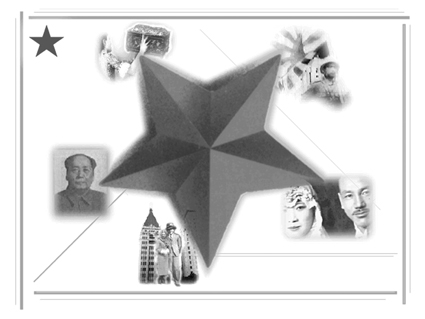
Tatiana Pentes, Strange Cities
Apart, of course, from C3PO’s nervy variation on the loyal poof valet, the best thing about Star Wars (Mach I) was all those twee segues: the windscreen-wiper, the venetian-blind, the diagonal swipe, the horizontal shutter…later zombied back to life in PowerPoint.
In spite of the vistas opened by hyperlinks, much writing for multimedia—and especially for the web—never quite manages decent textual segues, something narrative or perspectival or dialogic that can ease or direct the wormhole transition between nodes. All too often instead you get chunked, clunky Lego blocks of text-as-data and interfaces standing in for connections. Not with these projects.
Tatiana Pentes’ Strange Cities CD-ROM takes the segue and transposes it to a musical idiom that originates in, reconfigures and encases the unbelievable story of her grandparents, who were serial refugees and always-already aliens or exoticised expatriates.
The frame-story is told by the narrator, Sasha, who didn’t believe all their outlandish tales until, after their death, she was about to incinerate a box of old memorabilia from Sergei and Xenia Ermolaeff. We open that box ourselves, and follow the sepia photos and ID papers back to Russia, to the Bolshevik Revolution, escape to China, the marriage in Tianjin, Shanghai’s polyglot immigrant community, the decadent jazz clubs Sergei’s band played, rubbing tuxedo-ed shoulders with Chiang Kai-shek and Charlie Chaplin, Xenia becoming a glamorous nightclub dancer, Mao’s revolution, asylum in Australia and suddenly 50s anti-Reds paranoia, the claustrophobic suburbanality of permanent nostalgia. In and out of frame, as intro and closure, move press clippings, an evocative layered-n-textured Photoshop-ad’s-worth of old photos, creaky newsreels and retooled recent footage, Trotsky speeches, Sergei’s songs and the band’s smoky jazz, contemporary radio broadcasts, un-artificial soundscapes, and narratorial voiceovers.
The effect is that of stretto, the fugue technique of overlapping and entangling voices and time signatures, where Pentes eschews the pull of Hollywoodising the admittedly-amazing story into linear cinematic re-telling, so it’s less trajectory than transitional vignettes. These are composed as ‘movements’—Prima Volta, Mordente and Lacrimoso—with multiple interfaces, menus, image-maps, differentiated mouse-pointer icons and situational identifying soundtracks. Pentes has exploited the ways in which expressive multimedia can parallel the modes, feel and mechanisms of memory-in-anecdote to memorialise her grandparents’ lives in a work that at last makes musical structural metaphors something more than a branding exercise.
Los Dias y las Noches de Los Muertos (The Days and Nights of the Dead), a website from Francesca da Rimini (www.thing.net/~dollyoko/LOSDIAS/INDEX.HTML) with sound by Mikey Grimm and grafix and translations from a big gaggle of collaborators, is virtually nothing but segue, contracted to such a hyperkinetic attack it strafes you. Step 1: download the soundtrack and get its stripped industrial-electronica going. Step 2: um, that’s someone crying isn’t it? & someone screaming…moaning—disconsolate sobs and it sounds like—& feels like—torture…weird how I’m kicked out of viewer-ly complacency by war’s fallout coming tinnily from my tiny speakers. Step 3: “click to start”, a disingenuously clichéd invitation that ends up spawning a new window, ambushing my browser to set off a series of graphical and plain-text detonations.
It’s all auto-refreshing, webpages replaced automatically by another without a mouse-click. Try clicking and you just get more 3-second-delay transitions. We’re talking hypertext-as-70s-zapping in Greenaway split-screen TV here, 5 frames vertiginously kaleidoscoping between quotations from Napoleon on the art of war, press stuff from the Zapatistas, excerpts from the US Space Command’s ‘Vision 2000’ policy (terrifyingly vacuous…but remember Reagan’s ‘Star Wars’?), Machiavellian directives for netwar and a slew of snippets posing as ICQ Logs strobing you in Exhibit-A flashes. In a kind of striking narrativisation of the Seattle WTO protest, globalising multinational capitalism is made to lip-synch the motives and pragmatics of war. So you get, for instance, EXXON announcing “death is nothing; but to live vanquished and without glory is to die every day”; or The Vatican Bank, or Shell, or Coca Cola, philosophising on battle. For anyone who’s followed the harrowing online media accounts, the visceral experiences and pleas of the Zapatistas, colliding—often almost literally—with the blandly glib, spin-doctored policy statements on war and the vortex of imagery…it’s wrenching.
Similarly disturbing, but uncannily, is Whoseland.com, an “inter@ctive documentary” (it’s 2000: let’s declare a moratorium on @) about the 1998 Africa-Australia Exchange on Land Rights for the Millennium (www.whoseland.com). It reads, from Howard’s (un)sorry 2000 state of affairs, as an uncanny present-tense palimpsest of connections made and missed, hopes now boxed-up in apathy, and a productive international effort at recompense, equity, practical solutions and modest proposals. It generates its momentum from chronology: the inception of the project, its main press conferences (one by Ben Elton at his ratbag best), the experiences of the delegates from Maasai and Barabaig peoples in Australia and of the Kimberley Land Council in Africa, the 1998 Melbourne protest march, heading towards the Centenary Celebrations in 2000. Each section’s colour-coded, crystallised in a spiral site-map and navigable by elegant icons, backed by extensive content varying from first-person accounts to full transcripts, a click-zoom-able map of tribal ownership and languages, and a useful collection of research papers.
The writing is taut and engaging throughout, exploiting the narrative drive and delegates’ excitement, heavily and effectively illustrated by photos and vox-pop videos. Return exchange visits were planned for 1999 but—and this is more than the usual existential whinge—although the site promises to provide updated content up to 2000, it peters out at 1999, exacerbating the cross-wired time perspectives.
Sharkfeed, by John Grech and Matthew Leonard (www.abc.net.au/ sharkfeed /index.htm – expired; see RealTime/ OnScreen 38), extends such cross-wiring by looping round a 1960 kidnapping-murder case, and literalises it in ‘rephotography’, which makes a refrain out of re-framing photos with the same subject over disparate time and place locations. In June 1960 the Thorne family from Bondi won the Opera House Lottery (100,000 pounds!), which led to their son Graeme being kidnapped by Stephen Lesley Bradley (Istvan Baranjoy), a migrant Jewish-Hungarian WWII survivor, for a ransom. Graeme died, probably inadvertently but horribly nonetheless on the day of the kidnapping.
As with Strange Cities, the project is in focal flux from the main storyline outwards, bricolaging an album of traces from archival footage, old news media photos, recordings, interview/broadcast transcripts, sound files (from Paul Robeson singing in Sydney to the Police Commissioner’s briefings), headlines, reconstructed evidence snapshots, sketches, photo montages, mixed-time-period panoramas, and crime-scene maps.
The project’s creators explore the way the Thorne case inaugurated the long history of sensationalist quickie-trash true-crime books, yet Sharkfeed regularly falls into the same exploitative formulae, like: “Graeme Thorne was kidnapped on the way to school, a journey from which he never returned. Afterwards, nothing was quite the same again.” Um, yes. Etc. The main navigation option (‘continue’ or ‘about’ as rollovers) is not exactly aesthetically or hypertextually exciting, but you also get regular ‘detour’ possibilities, a nice-if-superfluous VRML interface, and category menus; but it’s the transitions that rescue it from TV-re-enactment, circling round from the compelling narrative-doco and true-crime-voyeur arcs into the wider disturbing social issues. Sure, it leads to some questionable philosophising—“as the lives of all those children were lost, they began another kind of life, in a mythical space from which they can never escape”—and gratuitous puns on ‘corpus’, but it’ll absorb you and make you think, get you arguing and where’s your kid right now?
In contrast to the centripetal pull of a main storyline, Archiving Imagination (www.archiving. com.au/archiving/index.html) is an unapologetically disparate sampler of collaborations between Robin Petterd (digital media artist) and Diane Caney (writer/web-author and editor of the Australian Humanities Review). Most of the works are brief and concentrated, surreal or haiku-ish poetic writing dramatised by video or made into rhythmical movements by minimal design, braided hyperlink arcs, discrete sound effects, muted terrace-house colour schemes and a beautiful line in fade-in-fade-out gif animations lushly mirroring the lyrical text…“and when I sleep my mind bathes in the memory of your skin.” Often coyly unpredictable or navigationally unclear, the design forces cursor exploration: rollovers, image-maps, auto-opening links and floating windows are all used to pointed textual effect with surprises and hidden sections. And the writing itself, to which the focus always returns, is worth the hunt and the wait.
Alyssa Rothwell’s From My Porch CD-ROM is three-in-one: Three Mile Creek, Getting Dollied Up and Pretty Aprons. The first 2 have only minimal writing components, so I won’t cover them here. But Pretty Aprons! An absolute bloody gem, as its characters, or my ex-country-town Dad, would say. After some exquisite time-lapse sand animations, you’re suddenly in front of a sketched old pedal-powered Singer sewing machine, a basket of cloth by your feet, teacup on the edge. You’re on a farm, making aprons for Xmas gifts. Drag your cloth onto the Singer and fragments from sewing patterns or recipes or a faded women’s magazine slide onto the screen: assemble them and the stories start, rendered in miniature-insert sand animations or in beautiful pencil sketches featuring a character wearing something made from the cloth you chose. You can drop in on an old chatty neighbour for eggs and stay for a nice cuppa, which you pour yourself, setting off a tangle of yarns about everything from onions as a baldness cure to growing up a tomboy. At one point the teapot just won’t stop pouring and as the tide rises round the armchair you hear all about the ’54 flood. Then there’s the salesyard, the ballet lesson with the Mums sitting knitting but pirouetting inside, while a Prunella Scales voice harangues you “2,3,4…bottoms in THANK you”…but, oh, my favourite was the piano-practice, where you can either listen to someone practising (oops, wrong note) or play the piano yourself with the mouse (no, really). And if you stop playing for more than 5 seconds Mum querulously yells from the kitchen “Why’ve you stopped?!”
Each time you’ve had enough of a scene you can pull the pins out to return to the sewing machine and there’s another finished apron hanging on the line. A young girl works throughout as the narrator, encouraging you to finish another apron, telling tales on her Mum and her passion for sewing, how once, when the cat finally made a mistake in its acrobatic provocation of the dogs from its perch up on the water-tank, Mum came home to find its insides hanging out, so she took a small needle and some thin fishing line and sewed it back together on the verandah. To this day she wonders if she’d used a bigger needle or a different stitch it’d be walking without a Karloff twist. Funny, real, addictive. For the first time ever I wanna buy a CD-ROM and give it to friends as a present, better’n a book.
Now, naturally, having begun by pontificating about textual transitions, it’s become impossible for me to extricate myself by seguing gracefully to a neat close. So I won’t.
RealTime issue #38 Aug-Sept 2000 pg. 3
© Dean Kiley; for permission to reproduce apply to realtime@realtimearts.net
Drawing as it does on rapidly changing technology, electronic art is always looking out for the next wave, a new process, a new platform. As the technology industries continue to generate novelty—a mixture of promises and products—at a breathtaking rate, artists adopt and adapt both the rhetoric and the technology, slipstreaming behind the biggest, fastest juggernaut around.
So in the year when, as a child, I imagined the future would finally arrive, there is an interesting, subtle sense of pressure on the electronic arts—as if they too should be finally ‘arriving,’ coming up with the goods, delivering on their promises and aspirations, breaking into the mainstream. At the same time, the status of the electronic arts is undergoing perhaps its most serious challenge—because the future is arriving, in a straightforward, quotidian way, but it’s arriving all over the place, indiscriminately and without regard for who’s been waiting the longest. Here I want to discuss that challenge, and show how it may ultimately—in fact hopefully—bring about the end of ‘electronic art,’ ‘digital art’ and ‘new media art’ as they currently exist.
This challenge arises quietly, as a particular threshold is crossed—a threshold of technological saturation. Over the past decade, high-tech (and specifically digital) media forms have proliferated to the point of being ubiquitous in our everyday lives. Almost every manufactured image that we see—every laser-printed flyer taped to a pole, every book jacket, every billboard, every TV ad—is now a high-tech artefact, a product of layers of digital processing and production. Film, a uniquely persistent analogue medium, is embracing digital production. An overwhelming majority of the audio which we encounter is ‘digital’—at least in its means of reproduction, though increasingly in its creation as well. At the same time, ‘new’ media forms (email, the web, console games, mobile phones) are threading themselves ever more tightly into everyday life.
A couple of years ago a new Coles supermarket opened in my neighbourhood, complete with an array of beautiful, flat LCD touchscreens which function as cash registers and point-of-sale advertising displays. When I first saw those screens, I was struck by their potential; I imagined somehow appropriating them for a lavish interactive artwork. They looked so incongruous; precious technological artefacts surrounded by racks of chewing gum and magazines. At some point since then, though, the screens changed: the supermarket assimilated them; now I just see cash registers with banner ads.
The saturation of our lives, and our culture, in media technology, is predictable enough; the process has been clearly underway for decades. What’s more interesting here—and what the supermarket story illustrates—is that this process has finally reached a point where these media technologies are completely unremarkable. The ‘digital-ness’ of a CD simply doesn’t matter (any more); nor does the fact that the titles for the evening news are computer-generated, or that this publication is digitally typeset. Even where the technology itself is unavoidable, the rhetoric around it now concentrates on basic utility value: the commercial, consumer web packages itself as a lifestyle-enhancer, a time-saver, an appliance, but never as a technology.
This process of disappearance or dissolution is facilitated by the increasing sophistication of digital media technologies. This is clear in Hollywood cinema where digital technique is crossing a corresponding threshold of perception; nobody remembers the computer graphics in Saving Private Ryan. Contrast this with the self-referential graphics of 10 or 20 years ago; remember the opening titles to the first series of Towards 2000? Glowing wireframe jet planes and spacecraft zoom out of the screen. The message was clear: “the future is technology, and it’s coming right for you.” Now that we’re here, the glowing wireframe is a retro icon for a simpler time. Contemporary media technology is a shape-shifter—it puts on the skins of forms it’s killed (film grain filters, lens flare effects, vinyl crackle plug-ins)—but can look and sound like anything, or nothing.
What does this shift mean for the electronic or ‘new media’ arts? In one sense, it means almost nothing, or rather, more of the same. As media technologies become more sophisticated and more accessible, the arts benefit; more room for experimentation and play, more potential, more power, more scope. These have always been the payoffs for riding with the technology juggernaut. In another sense however, this shift represents a significant challenge to the ways in which the high-tech arts construct and identify themselves.
Sparked perhaps by the reluctance of the established art-world to accept their work, artists using electronic media have gathered, over the past 2 decades, under such generic banners as ‘electronic art,’ ‘digital art,’ and ‘new media art.’ An active international scene has emerged, with its own institutions, events, stars, critics, and gossip, all organised around a common creative engagement with technology. This identification with a technological medium has been useful in many ways: technology is a drawcard, a (largely) positive cultural marker, often attractive to the powers that be. While often highly critical of its technologies of choice, electronic art has also been happy to borrow the progressive rhetorics of ‘cutting edge’ technoculture for self-promotional purposes.
That rhetoric only works, though, when the technologies involved are new and exotic, and digital media are no longer either of those things. Where does this leave (not-so-) new media art? Those with a hankering for the experimental will no doubt continue to seek out esoteric and emerging technologies; biotech art is already a reality, no doubt nanotech art is close at hand. Having been crowded out of digital media, the high-tech avant-garde might simply move elsewhere. However there is another option which is more radical, but also more interesting: what if artists working with technology stopped identifying their practice as ‘new media art’ or ‘digital art’? How useful are these designators in a culture in which digital media are the ascendant status quo? What if the technology-based banners for this field were simply taken down, now that their age is starting to show?
Suppose for a moment that this were possible, and imagine the consequences. It might demonstrate that these generic labels have never been a useful way of thinking about, or engaging with, this practice. They lump a diverse range of work into a category which ignores the most interesting aspects of the work—its content—and concentrates on a set of technical and production processes. If that category were to dissolve—as it is dissolving in culture at large—we might find a more complex way of thinking about this work. All those clusters of shared values, approaches and aesthetics which already exist within new media practice would come to the fore—those groupings would be recognised, rather than subsumed. At the same time, the networks of trans-disciplinary influence and continuity which already run across the field would develop. These banners involve an act of differentiation, a declaration of a separate practice—yet among the richest zones are those where electronic media meet existing creative and discursive traditions.
The notion of ‘new media’ as some kind of radical move and/or critical problem will, with any luck, recede. That hoary old excuse for the uneven quality of new media practice—that it’s ‘early days’, and that ‘in X years we’ll look back on this as the beginning of a new era’—will go with it. More space and energy will be left for a real engagement with the work, in all its cultural and creative specificity. Of course this is not to propose that the media themselves should be ignored, either by artists or critics. The process of grappling with the medium is part of doing creative work, just as the process of deconstructing, interrogating and analysing those media is part of critical work. In rapidly-changing domains such as the web, these processes are crucial, and certainly net.art plays an ever-more-essential role in offering alternative ways of thinking through that medium. Still, there’s more to it than that.
What about those organisations structured around medium-specific banners? What of the funding bodies, who play an important role in the construction of those categories of practice? Without the banners of ‘new media’ or ‘digital art,’ and the sense of solidarity and legitimacy which they bring with them, artists may find it even more difficult to gain support for their work. It’s these (important) pragmatics which will most likely ensure that this thought-experiment is never realised. Take it instead as a wistful vision; a sprawling continuum where high- and low-tech art co-exist and intermingle. Or better, a polemical jolt, a hypothetical. Either way, the wider process which sparked it is obstinately real; the ‘new media’ are becoming everyday, unremarkable, imperceptible, ubiquitous—and they won’t be new for long. Similarly, the best thing that could happen to ‘new media art’ would be for it to dissolve—not vanish, but dissolve—and for the medium to give way to the work.
This article is a variation of a talk given at the Being Digital forum, chaired by Susan Charlton and organised by dLux media arts, as part of the Sydney Film Festival, Dendy Martin Place, Sydney June 15.
RealTime issue #38 Aug-Sept 2000 pg. 7
© Mitchell Whitelaw; for permission to reproduce apply to realtime@realtimearts.net
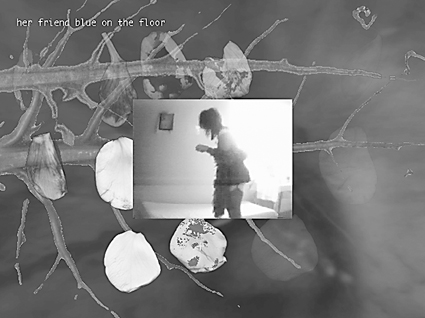
Linda Dement, In My Gash
It was but 6 years ago that the first works on CD-ROM by artists made their appearance, only 5 since the initial net art sites emerged. The rapid expansion of artists’ sites in the last 2 years has eclipsed and diminished the desire to place work onto CD. The considerable range of skills needed to make an interactive CD-ROM and then distribute it have kept artists’ attention on the improving quality and range of options available online—faster access times; browser and production software adapting to the desire for sound and movement; and an on tap means for delivering curated exhibitions to the audience (no freight, no installation, no need for a sustained level of funding).
Moving out of the notional centre (from the confined spaces of the gallery, from the vicissitudes of curatorial taste) into the digital highways and byways of cyberspace is becoming challenged, a la revenant, by the laneways and streetscapes of the analogue city. Drive by was a series of shop window projection installations by the Retarded Eye group for the Perth 2000 International Festival. (See RealTime 37, page 18). One of the works A throw of the dice (can never abolish chance) was made by Vikki Wilson with performer/writer Erin Hefferon as “an experiment in electronic writing to produce a work that makes a ‘movie’ on the fly with text, sound and video. The ‘movie’ is recognisably the same story but different in each version: a series of compressed serial-killer narratives—Perth-dwellers have been living with this story for some time.” The work reiterates its storylines, building a collage of permutations over time and was developed from a narrative database engine (made by Cam Merton of Retarded Eye), holding movies, sounds and sentences scripted to combine into narrative sequences as the engine runs. A DVD delivered the piece to the projector installation and is accessible on the web (http://arc.imago.com.au/ driveby), indicating an inexorable movement by this group and a few others overseas towards forms of online cinema.
As a work distributed on videotape, Love Hotel anticipates these shifts, summarising in 7 minutes of linear exposition the impact of online culture and communities on gender politics. Linda Wallace (www.machinehunger.com.au) takes video collected from Japan and New York and layers it in windows and boxes containing the words of Puppet Mistress (Francesca da Rimini reading excerpts from Fleshmeat, her forthcoming anthology, www.thing.net/~dollyoko), vectoring meanings from the collisions of resulting images. Screened recently as part of d>art00, the project adopts the provisional location of the love hotel to materialise in the media guises of cinema, television, multimedia, internet and next…gallery installation?
Rosalind Brodsky in her time travelling costumes spans right across the 20th century and into 2058, the year of her demise. The space she occupies during this bungy-jump is, of course, the virtual space of the interactive multimedia computer and the encounter between each user and the rich imagination of the artist…No Other Symptoms—Time Travelling with Rosalind Brodsky. Rosalind (the alter ego of the CD-ROM’s maker Suzanne Treister, see RealTime 34) delivers a monologue that ranges across late 20th century media studies discussion points from psychoanalysis to Mary Poppins, vibrators, sci-fi films, the Russian Revolution (complete with clips from Eisenstein’s October), 60s euphoria and hope for the future. Stories of Old Europe—pogroms, revolts, émigrés—are encountered. They are central to her history. Rosalind wishes to be “…connected to (her) roots…” and interspersed are photos and videos of the Treister family members, as family and as players in re-enactments of historical moments and encounters with extensive figments of Freud, Jung, Klein, Lacan and Kristeva. Rosalind as a time traveller is able, of course, to warn Freud to leave for London…he does. She sees a lot more of him. And so can we…
Lisa Roberts time travels via the simple action of turning the hands of a clock backwards and forwards (I discovered eventually this had to be performed quite vigorously), until entry is given to the labyrinths of the CD-ROM Terra Incognita. The smoke and mirror possibilities of the authoring tool Director (in spite of inexorable pixel-dissolves) recreated the séance-like atmosphere of the magic lantern, with static images from the artist’s experienced pencil and paint gestures flickering through parts of the writer Carmel Bird’s fiction, the images forming “the basis for an interactive ‘map’ of the creative process” perceived by the artist in response to the writer’s work. This is the work of a mature artist picking up and learning a complex multimedia tool.
Juvenate, from the Perth team of Michelle Glaser, Andrew Hutchison and Marie-Louise Xavier, also explores intersections of memory—“The beginning and the end reach out their hands to each other.” The simple action of rolling over unmarked parts of the images stimulates sounds and successive images to emerge in a flow of snapshot and watercolour elements constructed around the domestic. Abrasions, lesions and drips intervene into the sound of children’s voices as the user moves through the 36 scenes following a route that can be re-visited once learnt.
Linda Dement has recently completed her third CD-ROM, In My Gash. Like the earlier works, she creates a gentle correspondence between the user and the complex representations seen and heard, that in spite of the implication and threat of violence witnessed gives access through a real engagement to comprehension rather than the dead-end of the hopeless and intractable. As Anna Munster has observed: “Dement’s 3D animated renderings of gashes seemingly offer up representations of the mysterious leap from the physical to the psychical, from the outside to the inside, from the beautiful to the grotesque that straddle our understanding of gender relations (Photofile 60, forthcoming).”
TellTale is the flipside CD-ROM, “a mixture of sweetness, courage, nauseating patheticness and romance” in the words of its creator, Rebecca Bryant. As an immersion into the world of a soapie-like group of ‘characters in situations’, it enables the user to terminate irksome storylines, back into a more promising combination of plotline options and when all else fails, simply read scurrilous footnotes about members of the cast. Whilst navigation is elegantly designed and effected, the flux that personifies the notion of the soapie is placed into a state of fixity when delivered as a CD-ROM. Internet narrative possibilities have advanced this option more recently, utilising streamlined vector graphics which, when coupled with graphic images of the kind in TellTale, simulate a cinematic experience. (Jonni Nitro at www.eruptor.com and Too Hot at www.toohot.com are examples of the form if not the content).
The use of the 360 degree virtual space linked via rollovers to movies and graphic sequences enables discrete narratives to be coordinated into the virtual installation of Cross Currents by Dennis Del Favero, investigating the sex slave trade of Western Europe (see RealTime 34), or the encyclopedic Lore of the Land from Fraynework Multimedia. A big budget project involving Indigenous and non-indigenous Australians mostly in Victoria, the multi-faceted chapters examine history, ecology, culture, law and land with an approach that encourages the upkeep of an integrated personal journal of the user’s journey through the work, collecting images and notes along the way. A curious game of Discovery is incorporated (separately authored by Troy Innocent) which involves collecting artefacts from an uninhabited cave, egged on by an off-screen Aboriginal voice, before returning them to the ground. The goal of all this earnest activity is to move towards understanding, and the achievement of, reconciliation. The navigation system whilst easy to use keeps this rich resource at arm’s length relying, like a television doco, on the personalities of the individual contributors to provide the spirit of the piece. The outcomes of individual journals linked through a website forum (www.loreoftheland.com.au) potentially close the gap between the user and the experience and process of assimilating this work.
User confidence is challenged in the elegant Electronic Sound Remixers by Tobias Kazumichi Grime, where the ubiquitous Director authoring tool enables the user to combine from a palette of attractive sounds a mix using a design grid with an attractive variety of visual slider devices. Is the mix actual or, as the user begins to suspect, the result of options only partially given by the author?
Virtual kitchens were a factor in the mix of the year’s completed works. Dream Kitchen by Leon Cmielewski and Josephine Starrs submerges us beneath the smooth surfaces of the domestic laboratory to examine its seams and what lies hidden: fire-raising pencils and pens, anthropomorphised garbage, an opportunity to take the Interface Test and apply an increasing electrical voltage to a dead frog. Witnessing from a surveillance position behind the phone the S&M goings-on of the otherwise absent owners adds spice to this ingenious wunderküchekabinet. Michael Buckley’s Good Cook dives beneath the psychic surfaces of the professional kitchen during a sleepless night for the chef. The user shares his frustration at not being able to shake off meandering thought and image recollections as the mouse threads our way from the trials of the previous night’s work to childhood memories and the paternal pathways of songs and scriptures.
Delivered after a short gestation, the pixel, the byte and the inkjet are seamlessly integrated via the CCD and the chip into a contemporary practice that is again dissolving the artificial barriers to the possible erected by corporate culture and the ambitions of software engineers. Time-based technologies used to ‘fix light to a time signature’ are in ever more constant flux, again redefining the terms of hybridity, again continuing the development trajectory of the newer media within screen culture.
RealTime issue #38 Aug-Sept 2000 pg. 6
© Mike Leggett; for permission to reproduce apply to realtime@realtimearts.net
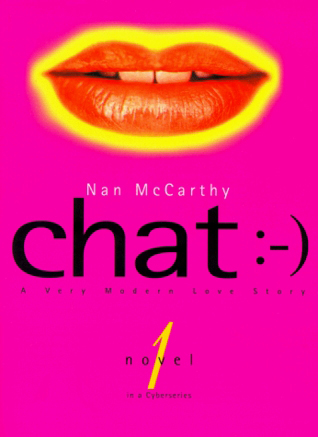 You’re the cutest thing that I ever did see/really luv your peaches wanna shake your tree/Lovey dovey, lovey dovey, lovey dovey all the time/Oooey baby I sure show you a good time.
You’re the cutest thing that I ever did see/really luv your peaches wanna shake your tree/Lovey dovey, lovey dovey, lovey dovey all the time/Oooey baby I sure show you a good time.
Er, sorry about that. Don’t know what’s wrong with me today. Must be that email I just got from Peaches. I mean seriously, do you know anyone called Peaches? What about Buck, heard from him lately? Unlikely as it may sound, this nomenclature resonates with literary gravitas and the portent of tele-communications historiography. Stay with me.
Since McLuhan’s observation that new technologies are always inscribed by earlier modes and practices, media theory has insisted that its forms do not arrive unheralded. Cybercultural genealogy is awash with theorists peering further and further into the past. Commentators such as Margaret Wertheim (The Pearly Gates of Cyberspace: A history of space from Dante to the Internet, Doubleday, Sydney, 1999) argue that the idea of cyberspace is unthinkable without critiquing the changing metaphysical and scientific conceptions of space, and writers like Janet Abbate (Inventing the Internet, MIT Press, Cambridge Massachusetts, 1999) or Katie Hafner and Matthew Lyon (Where Wizards Stay Up Late: the Origins of the Internet, Touchstone, New York 1996) dispute the conventional myth that the internet’s origins are limited to American military scenarios. But as these areas of inquiry are comprehensively covered, others remain somewhat under researched.
Electronic mail, while implicit in the cited studies, seems not to receive the same sort of sustained critique. One way to redress the gap is to historicise the email novel. This emerging genre can be traced to 18th century British and European cultures where an increasingly literate population and the technological advancements of the postal service give rise to the epistolary novel. Works such as Les Liaisons Dangereuses by Choderlos de Laclos, Jean Jacques Rousseau’s La Nouvelle Heloise or Samuel Richardson’s Pamela are narratives constructed from letters whose formal and thematic properties presage certain contemporary literary genres.
How to spot an email novel? Well, the title must include technological form, literary vehicle and a signifier of lerv. Cyber word, colon: love word. Consider, Chat: a cybernovel (Nan McCarthy, Peachpit Press, Berkeley 1996); Virtual Love: a novel (Simon & Schuster, New York 1994.); Safe Sex: An e-mail romance (Linda Burgess & Stephen Stratford, Godwit Publishing Limited, Auckland 1997); and Email: a love story (Stephanie D Fletcher, Headline Book Publishing, London 1996) and you begin to see the point. To a large extent, email novels function according to the generic principles of epistolary fiction. The exchanges are presented chronologically, framed by dates, salutations and signatures. In both genres there is a strong emphasis on the body’s absence: correspondents are separated spatially and temporally and the missive is used as a means to negotiate this gap. And both narratives are informed by themes of love, seduction, adultery and betrayal. More specifically, one might draw parallels between 2 of the texts by comparing their articulations of subjectivity formation.
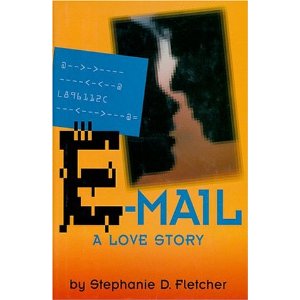 Both the 18th century epistolary novel Les Liaisons Dangereuses and Fletcher’s E-Mail: A Love Story, for example, wrestle with the problem of women’s sexuality in terms of the transgression of institutional ideology. Laclos’ Mme de Merteuil is exiled because she dares to usurp the masculine privilege of the sexual aggressor and Katherine Simmons, the protagonist of E-Mail: A Love Story, is reformed at the novel’s end by her return to legitimate sexual acts defined by the marital contract. The configuration of identity seems to concern both genres since the epistle form permits an opportunity to explore or radicalise questions of subject formation. Mme de Merteuil explicitly refers to her propensity for dissembling and reinventing herself and the correspondents in Fletcher’s text regularly discuss the advantages of and need for the use of pseudonyms (hence “Peaches” and “Your cowboy, Buck”).
Both the 18th century epistolary novel Les Liaisons Dangereuses and Fletcher’s E-Mail: A Love Story, for example, wrestle with the problem of women’s sexuality in terms of the transgression of institutional ideology. Laclos’ Mme de Merteuil is exiled because she dares to usurp the masculine privilege of the sexual aggressor and Katherine Simmons, the protagonist of E-Mail: A Love Story, is reformed at the novel’s end by her return to legitimate sexual acts defined by the marital contract. The configuration of identity seems to concern both genres since the epistle form permits an opportunity to explore or radicalise questions of subject formation. Mme de Merteuil explicitly refers to her propensity for dissembling and reinventing herself and the correspondents in Fletcher’s text regularly discuss the advantages of and need for the use of pseudonyms (hence “Peaches” and “Your cowboy, Buck”).
While the 2 genres share some formal and thematic elements, there are of course points of departure. Part of the problem is to do with the awkward mimetic situation of email novels because they use the conventions of print technology to describe, represent and invoke the tropes of electronic communication. Email novels quote the digital sign. In place of the usual epistolary preface, E-mail a love story begins with 3 pages that reproduce the instructions for a fictitious computer based communications system called ‘Luxnet’ (based presumably on services such as America On Line or CompuServe): “to learn more about electronic mail simply click your mouse over the mail icon on the screen.” Needless to say, there is no mouse, icon or screen.
This mimetic fissure is tackled by Carl Steadman in a fascinating internet based project called Two Solitudes, an e-mail romance (http://www.freedonia.com/ – link expired). Steadman (one of the co-founders of Suck) has written a novel dictated by the email interface rather than the print environment. One ‘subscribes’ to the story using similar protocols to Listserv discussion groups. What follows is a series of emails purported to be copies of the correspondence from the exchanges of 2 people of indeterminate gender (Lane and Dana) but amorous intent. The technological verisimilitude is so successful that it is quite possible to forget one is reading fake mail. It is a compelling literary experiment clearly informed by the epistolary theory of Jacques Derrida’s The Post Card (1987).
Where Steadman’s theoretically astute email fiction is overtly indebted to an epistolary past (and all that that implies about the author/reader dynamic of tele-communication), the email novels must also be seen within their literary heritage. Just because someone in Email: A Love Story signs his missives from a ‘cyber Romeo’, doesn’t mean he can’t grow up to be John Malkovich.
RealTime issue #38 Aug-Sept 2000 pg. 27
© Esther Milne; for permission to reproduce apply to realtime@realtimearts.net
Anyone interested enough to pass by the Stock Exchange building in Sydney a few months ago would have witnessed the spectacle of the dotcom crash, or “new media adjustment”, as financial pundits would have it. Small-time investors and internet start-up owners stood, some with noses unselfconsciously pressed to the glass, watching their stock devalue minute by minute. Informed by the U.S. NASDAQ (the American financial index for new media stock) the electronic red ticker streamed a sorry story; some stocks nosedived to within a hair’s breadth of their issue price, others simply entered negative figures.
The crash came at an interesting time. In internet years (roughly comparable to dog years in terms of development), the web was colonised by technology corporations a very long time ago. They are responsible for both interpreting the web as a rampantly commercial space (with all that that entails), and developing sophisticated platforms from which to serve what they call “content”, a lazily defined term which means anything from editorial to a nifty, Java-scripted button on a navigation bar. Strategies ranged from providing millions of free email addresses and giving away software to skimming a percentage off the top of credit card purchases. Very few of them made actual money and the market eventually got nervous, hence the crash. Things, as they say, will never be the same again.
The development of the technology, however, continues apace. WAP (Wireless Application Protocol) will be coming to someone with a fairly hefty mobile phone plan near you very soon, delivering components of the web (news headlines, movie session times, sporting updates and of course stock reports) to the thing that just used to go ring ring. Interactive TV has already been introduced, and Pay TV viewers are familiarising themselves with the idea of fusing a website interface with broadcast programs—checking their email while the cricket is playing. All pretty handy.
So what’s an article about a bunch of well-off wankers losing their money during a period of vastly accelerated technological growth and innovation doing in RealTime? Serving as speculation, mainly, about what all of this means for the way in which information we want to find and “content” we might very well create, will be disseminated in the future. These emerging technologies will indeed be handy, but who will be setting the agenda as to how they are used? In a post-crash environment, where the cash won’t be flowing anywhere near as freely as it did before, the web as it spreads to TV and your phone will be economically rationalised. Internet service providers of all kinds now have a vested interest in keeping their subscribers within the walls of the content that they have purchased or aggregated. Some are giving away free access—you don’t pay a cent, but you can’t actually leave the network you’re in to explore the rest of the web. So if you’re forced to bank online because your local branch has closed down, and you can’t afford to pay for an internet connection, welcome to the “walled garden.” Others provide services exclusively to their paying customers; everything from 5 email addresses to animated short films and “superior” news coverage. Stuff the rest of the rabble will never see, unless they upgrade.
Of course it’s all in the name of commercial good sense, but does it have to be inevitable that the medium that started as a tool for Cold War military communication, transmogrified into an academic language (Hyper Text Markup Language or HTML) and still boasts worldwide access to information about subversive and marginalised cultures, will become a segregated medium?
Firstly, to the culture. The internet industry workforce is home to some of the most brilliant technology heads outside of the science world. They are able to solve problems more quickly than it would take to explain them, and remain wisely apolitical within the sphere of the working day; a geeky empire unto themselves. But the industry is still bloated with counter-culture poseurs; under 35 year-olds with Palm Pilots and wardrobes full of utility chic couture, spouting new media pseudo ideology-speak as flimsy as the content they are responsible for publishing on the web. Attend a meeting with these kids and buzz phrases such as “synergy” (a greasy economic fit between 2 businesses) and “robust nature” (the ability for “content” to be pillaged for e-commerce opportunities and syndication models) will zap around the room like so much locally routed data. It is very possible you will witness them encouraging each other to “think outside of the square” (come up with ethically unsound solutions to content problems, such as sell the arts section of a website to a sponsor and skew the editorial in its favour). And if you’re unlucky enough to suggest something which doesn’t have a “fit”—even outside the square—it’s possible you’ll be told to “take it offline.”
It is to these people that many writers and filmmakers will be entrusting their work. These are the people who will privilege sport and mainstream computer games over the arts because the stats tell them to. If you’re lucky enough to find decent arts listings on a commercial website, it’ll be a personal indulgence on the part of the producer who runs it.
Further up the food chain, however, are the heavyweights. The ones glamorised by IBM advertisements. Old tie private schoolboys, ex-lawyers, ex-traditional media and too bright MBA grads who, come lately or by right of birth, subscribe to the old capitalist school of dress and behaviour; they wear suits (jeans are allowed on Fridays, providing they don’t have a meeting with the Telstra guys), make or tastefully ignore sexist jokes and earn a shitload of money for the privilege. Despite the recent dotcom ‘adjustment’ on the NASDAQ, these people still command salaries that start at 140k (even without equity) and just keep on getting higher. A polyglot of marketing executives, business strategists, e-commerce directors, CEOs and managing directors, these are the people who hold the purse strings. They are the people responsible for encouraging the syndication of content (ie that stuff we used to call editorial —the stuff it simply doesn’t make sense to produce in-house) across as many portals (the gateway to the rest of an internet network) as possible, to whom the term “media saturation” is freely interchangeable with “cost-effective.”
These are the people responsible for the hype surrounding convergence, who are currently shaping the “content” landscape on the web, setting the precedent for the licensing of short films from artists at rip-off rates, readily getting rid of web pages that aren’t paying for themselves. These are the people who are excited by the prospect of an internet/interactive TV/broadband (expensive, fast access to the net) environment by which your capacity to surf is limited to the content the corporation owns.
Despite what the Information Technology (a strange misnomer if ever there were one) sections of newspapers would have you believe, convergence is a fair way off becoming a digital reality for most people. But by the time it is, getting the right kind of money from a web company who wants to appear credible by licensing your film, might be nigh impossible. Looking to your interactive TV for inspiring content will feel strangely similar to subscribing to cable TV. Only instead of there being 200 channels of rehashed crap, there will be thousands of sites shoving crass advertorial and e-commerce opportunities down your throat—and the 9 rebranded corporations that used to form Microsoft will have a finger in most of them. We’ll look back with consumerist nostalgia to the time when advertising was actually distinguishable from the television show itself.
Maybe when the Coalition is voted out there will be more government subsidies and new media grants to ensure that interesting sites are built and web events take place. And hopefully, some of those projects will use the medium to critique the medium.
And hopefully most of us won’t be sucked in by a website funded by a bank whose spuriously deconstructive sociopolitical agenda—or is it an advertising campaign?—is to “unlearn.”
RealTime issue #38 Aug-Sept 2000 pg. 25
© Nadine Clements; for permission to reproduce apply to realtime@realtimearts.net
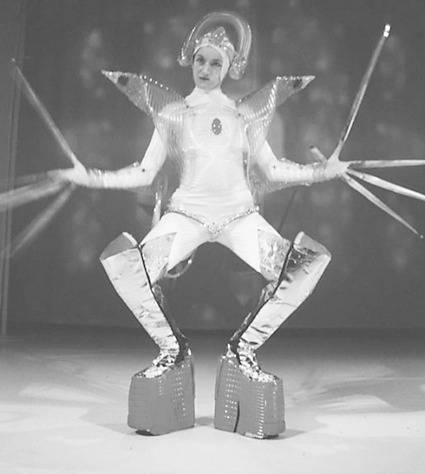
66B/cell, Cybermyth
Fusion, n. Fusing; fused mass; blending of different things into one; coalition
“…when two strange images meet, two images that are the work of two poets pursuing separate dreams, they apparently strengthen each other…”
Gaston Bachelard, Poetics of Space
Fusion was an evening of multimedia presentations, a part of the St. Kilda Film Festival program. Curator Sue McCauley successfully brought together a range of material with the stated aim of exploring the interactive possibilities of digital media. The program was scheduled to take place in 3 separate sessions. The first introduced several new innovative CD-ROM works; the second focused on the demonstration of a number of politically charged interactive documentaries; and the third showcased a variety of performance pieces which also incorporated digital material.
Curator Sue McCauley comments: “As the curator of the program for the second year in succession, I knew that the festival and particularly the venue was a fantastic opportunity to showcase the latest in CD-ROM and performance. It is not often that artists get this sort of opportunity. As a survey type, I felt that I could do 3 very different sorts of programs where artists could demonstrate their works for the general festival-going audience.
“I have recently also coordinated the digital arts program for the Next Wave Festival, Wide Awake Dreaming at Twilight. In both events I focused on creating contexts for the exhibition of multimedia works that did not rely on viewers looking at works on the computer. I was interested in getting away from the idea that the site of production was the exhibition platform. I want to give artist the opportunity to escape the box when showing their work. So works were incorporated in installation, in theatrical peformance or as installations.”
It has become common practice to incorporate CD-ROMs into film festival programs. In the last couple of years at the Melbourne International Film Festival, exhibitions of multimedia works have been set up in foyers and adjacent gallery spaces enabling patrons to move between film screenings and the interactives. There were, however, several things that made the Fusion program quite distinctive. First was the diversity of material that was presented—a demonstration of the real range of work currently being undertaken. Second was the impressive way that a human presence was brought back to the centre of the multimedia stage. This took the form of the creators of the CD-ROMs actually presenting their work, taking the audience through some of the pathways of their creations, and answering questions about the work and the creative process. It also took the form, in the final session, of a number of manifestations of the performing body, from playfully acerbic monologues to high-tech choreographed dance ensembles.
The first session, Surface Tension, featured 2 CD-ROMs which could be described as explorations of personal spaces and the subterranean, shifting zones beneath the surface of things. Leon Cmielewski and Josephine Starr’s Dream Kitchen is an interactive stop-motion animation. The space for this interactive is a pristine, gleaming kitchen setting. Cmielewski explained that the concept originated in a story from Japan where people put on VR helmets to see what their dream kitchen might be like. Once we start to explore this dream zone, however, we encounter ‘eaky borders’ which allow us to slip into the oven, under the fridge, down the sink. Here we discover debris, missing pens and pencils, and rodents: we are even able to administer electric shock to a rat. Each return to the kitchen space finds it in increasing disarray—dirtier, messier, falling apart. In comparison, the space for Matthew Riley’s Memo is more personal and meditative. Riley’s idea was to create an artist’s diary full of hand-drawn, painterly sketches and scrawling text in a high-tech medium. He wanted this journal-like structure to incorporate his many observations of the relationships between popular culture and the everyday. And he felt that interactivity would enable him to suggest complex conjunctions of meaning between situations as diverse as phone sex, football, gambling, and shopping, with a focus on the different ways in which language works.
The second session featured a series of interactive documentaries with tough political and educational agendas. It became clear that interactivity has provided practitioners with many new opportunities. It was also evident from the work that the interactive form of documentary has become the site of close callaboration between the subjects and the storytellers. Filmmaker and activist Richard Frankland introduced the CD-ROM The Lore of the Land and spoke of the way Fraynework Multimedia’s work supported Indigenous people in telling their own stories by not editing the material that they have collected. Similar sentiments were expressed by those who worked on the disturbing and poetic East Timor Identity, Resistance and Dreams of Return. The producers saw themselves as facilitators encouraging the stories of East Timorese refugees in exile to be told. The final documentary, Mabo: The Native Title Revolution, turned out to be an equally interesting hybrid that includes a re-edit of filmmaker Trevor Graham’s Land Bilong Islanders with a new ending taken from his other film Mabo: Life of an Island Man. A great deal of extra material has also been gathered together into this CD-ROM to make it a valuable research resource with clear educational potential.
The third session was the most provocative and high octane. Live performers interacted with digital projections of pre-recorded images—a fusion of voices, bodies, and dancing limbs in a multimedia theatre-scape. Frank Lovece’s Poopants was a voice-driven work dedicated to narrative. Lovece’s fast-track monologue touched on issues of violence, the republic, race and class as his words and voice interacted with projected image fragments. A series of screens and structures were strategically set up on stage to further break up and fragment the images, and complicate possible readings or interpretations. The next 2 performances were Cazerine Barry’s innovative dance works. Pony Girl took its inspiration from Girl’s Own Annuals and Barry’s prancing, energetic body took mock riding lessons from a 60s style projected voice. Lampscape was a more mesmeric piece with Barry dancing behind a large gauze screen shadowed by, and interacting with, images of herself projected through the screen—a theatre of the figural. The final performance was a futuristic work of alchemy which came from the Tokyo-based collaborative group 66b/cell’s Cybermyth, a collaboration of Japanese and Australian performers. The work they presented was a remix of Goethe’s Faust—a kind of Faust in Space—with characters plucked from the text free-form, clothed in graphically striking cyber costumes which intermittently flashed and created their own light shows, performing choreographed Butoh-inspired dance movements which also incorporated digital video projections. During question time, one of the artists explained that they had tried the piece with visuals alone but felt that it wasn’t enough. The stage, they said, needed a human body.
This was one of Fusion’s real achievements. Invoking McCauley’s words, Fusion was a program which “escaped the box”.
Fusion, St Kilda Film Festival, The George Ballroom, Melbourne, June 2
RealTime issue #38 Aug-Sept 2000 pg. 20
© Anna Dzenis; for permission to reproduce apply to realtime@realtimearts.net
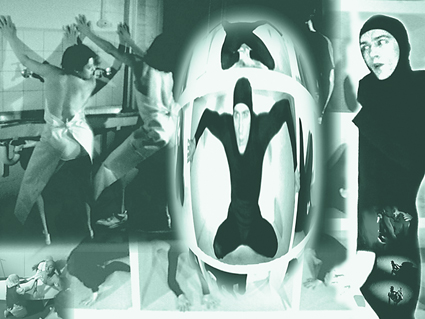
Stark White
The centrality of the abstract yet highly physical concept of the body in contemporary criticism renders our material form as the supreme subject of cultural, psycho-physiological forces. From Sigourney Weaver to genetic engineering, Artaud to dance music, the body has become a mesmerically omnipresent object which is gazed at, deconstructed, theorised, disciplined and choreographed. Choreography and criticism replicate a form of social violence which the body must routinely endure.
This insensitivity to the needs of the body as a living body—a critical-choreographic refusal of the soft body—is forcefully rendered in dance-maker Brett Daffy’s film Stark White. Daffy formerly acted as the archetypal self-mutilating, queer ‘hard-boy’ of Gideon Obarzanek’s early choreography and his independent dance proceeds from this precedent. With Stark White, Daffy’s disconcertingly pliable anatomy is pulled apart and reformulated in horribly compelling, ‘unnatural’ ways. This happens both internally—Daffy choreographing Daffy—and externally—women pulling at his limbs, angrily manipulating his joints, and grabbing at his form, before these bodies too undulate under the influence of an internal, psychophysical aphasia. The dancer moves from the bewildered voyeur of others’ psycho-somatic abjection to the primary subject of these forces, awakening to find himself enmeshed in an Escher-like landscape of physical and architectural repetition.
Brett Daffy extends this choreographic violence into the cinesonic language of Stark White. He and director Sherridan Green reject the tendency of dance film to sew together isolated frames so as to reconstitute a single, moving body. Image, sound and gesture are fragmented by the very processes of filmic production, and there is little attempt here to bring them back together. Stark White is not a montage of random material, but it does not conceal the brutality of its production. Like the protagonist, the audience is forced to recall its own position as producer of the cinematic experience—as flickering eyes and aural filters—fragmenting the film even as one attempts to draw it into coherence. Daffy, Green and composer Luke Smiles are therefore unconcerned by the body lying out of shot or gaps in the linearity of sound and image. The film jumps and shudders, creating something akin to a great, fleshy car backfiring crystalline apostrophes as it bunny-hops down a tinted, scratched subterranean road.
Daffy nevertheless prevents his work from becoming consistent with implicitly sadomasochistic, misogynistic or simply oppressively voyeuristic modes prevalent in advertising, painting (especially the nude), dance and ballet. He achieves this by placing himself and not the women at the centre of the literal and metaphoric technologies of the work. The cinesonic focus and choreographic violence spirals around his form and disorientation, his alienation and recovery. After seeing him both literally and metaphorically stripped and shaved, our gaze forces his body into the realm of sexual ambivalence and ambiguity. He is transfigured, a queer Christ perhaps. Like Calvin Klein’s models, Daffy lies beyond the heterosexed. Unlike advertorial homoeroticism though, this transmutation (this crucifixion?) is achieved through ecstatically painful dismemberment, by cathecting bodily parts and gestures such that monsters are born. The finale leaves us with this sexual beast flipping through the axial patterns elaborated in Leonardo’s Ecce homo, yet menaced by the possibility of psychological, sexual and physical hybridity that one sees in Hieronymous Bosch. A post-human for our age of monsters.
Stark White, writer/choreographer/ performer/producer Brett Daffy, director/ editor Sherridan Green, sound score Luke Smiles, Motion Laboratories, performers Sally Smith, Larissa O’Brien, Sharilee Brown, Lina Limosani, Ben Gauci, Larrissa McGowen, Paul Hickman, Kathleen Skipp, Anna Smallwood.
RealTime issue #38 Aug-Sept 2000 pg. 16
© Jonathan Marshall; for permission to reproduce apply to realtime@realtimearts.net
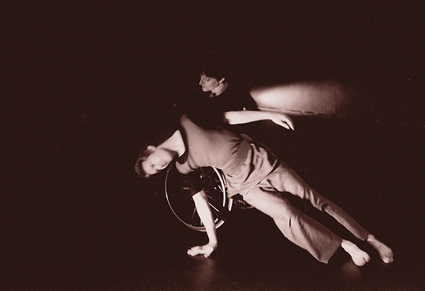
David Corbet & Janice Florence
photo Ryk Goddard
David Corbet & Janice Florence
Improvisation in whatever artform is about freedom; freedom of expression at the most overt level, throwing off all the restrictions and codes of artistic practice and replacing them with a spontaneous exploration of the very process of creating art. That it is art in process and simultaneously ‘in product’ is what places us, as observers, in a new relationship with the performers.
In dance, improvisation as a mode of performance represents fluidity, play and impulse, in contrast to the often rigid structure and form of choreographed movement. Sally Banes, in her 1993 text Democracy’s Body, describes improvisation’s extremity best: “If all dance is evanescent, disappearing the moment it has been performed, improvisation emphasises that evanescence to the point that the identity of the dance is attenuated, leaving few traces in written scores, or even muscle memory.”
In May, the Choreographic Centre hosted a weekend of improvisation, featuring the work of 4 groups that have embraced improvisation for the development of their performance. Familiar to Melbourne audiences, the groups were in Canberra as part of the third annual Precipice event.
Peter Trotman and Lynne Santos
Their improvisation starts with heavy movement—arms sweeping. Then it floats—the hands flexed. They are giving into their own weight, moving in isolation and yet there are moments of connection in the randomness. The pace increases and the movement becomes more abrupt, but there is still a seeming softness to their joints.
There are static moments; then they are leaning into and later onto each other, pushing away and falling upon. There is a fluttering of hands. “Heart beating pulse racing eyes blinking tongue licking,” Trotman blurts out. There’s a story to this performance, but where it ended up I have no idea…
State of Flux
The focus here is more on contact improvisation…physical support, touch, suspension of weight. The duet between 2 of the performers, one in a wheelchair, conveyed the honesty of contact improvisation. There are chance funny moments…he balances on her lap, shifts position his bum is in her face…and intimate moments…wheelchair discarded, rolling on the floor, moving over each other…and some pretty clumsy moments too…the uneasiness and heaviness of it all, bodies not intuitively sensing each other’s next movement. Sometimes it seems like the distance between the individuals is expansive; at other times it seems like the group is a single entity.
Five Square Metres
There’s a definite frivolity to this group; the 4 performers are expressive and frequently quite silly. The wit and chatter is all a vital part of the improvisation. The use of breath is another clever layer of the performance…sighs, deep inhalations and exclamations, all uttered on top of each other and set against equally staccato movement, such as shuffling in file and bumping into each other. There seems to be more of a narrative than in the other events on the program. The movement is but one element of the performance, and more driven by the group than the individual, almost a kind of expression of community.
Gallymaufry
Andrew Morrish brings out his mike, Madeleine Flynn plucks her violin and Tim Humphrey toots the trumpet. Morrish does most of the talking, absurd little phrases really, amusing as part of the situation, “I’ve been dreaming after hours.” The music is cartoon-like in the way it complements his prattle. He steps away from the microphone, arms reaching, then stretching gently, he steps out into more dynamic movement. Humphrey is yelling, “Open that door and jump!” Is it a command for Morrish or for us? Madeleine goes to the accordion and Morrish is moving again. It’s the funny mishmash of music, word and movement that gives the performance its meaning.
In an evening full of humour and more than the usual risk-taking, these groups created new performances and challenged us as observers to do a little risk-taking of our own.
Precipice: on and over the edge, The Choreographic Centre, Canberra, May 26-28
RealTime issue #38 Aug-Sept 2000 pg. 15
© Julia Postle; for permission to reproduce apply to realtime@realtimearts.net
Abracadabra opens Reel Dance and, as with any good password to any good world of wonders, transportation begins immediately. Phillippe Decouflé’s 1998 dance film (France) is an excellent password for this particular dance film festival, which goes right past mundane questions of ‘is it really dance?’ to the much more intriguing questions of how physical languages and cinematic languages might intersect. Abracadabra begins at the beginning of this question by linking dance to early cinema. A series of what film theorist Tom Gunning calls “attractions” are displayed. The word attraction partly refers to attraction as in circus act or novelty. Decouflé revels in this meaning, presenting danced oddities and bizarre displays with great glee. Then there is the attraction people have to the trompe d’oeil or cinematic trick of the eye. The viewer’s eyes are tricked overtly and inventively through various devices in Abracadabra, such as the use of deep focus creating illusions of outlandish differences of scale between foreground and background objects and actions. The final vignette is an acrobatic display in which the dancers do incredible things which, with enough skill, could really happen in the real world. These displays then evolve into the hilariously impossible and the audience realises a cinematic trick is being played on them. Both senses of the word attraction apply here—the acrobatics are an attraction or an act, and the moving image is itself a trick of the eye that attracts our attention.
This combination of attractions is one of the things that Reel Dance seems to propose defines dance on screen: physicality far enough outside of the norm to present itself as an attraction, combined with the many cinematic conventions that have evolved through and since early cinematic tricks of the eye. It’s not exactly a new form, but it’s an intriguing combination—making use of the conventions of cinema with dancing rather than acting as a vehicle for conveying content.
This combination was explored throughout the weekend, with many of the films drawing on particular film genres and infiltrating them with particular forms of dance. Dancers from the Frankfurt Ballet were involved in an overlong but intriguing dance in the genre of science fiction called The Way of the Weed (Belgium). Wim Vandekeybus contributed The Last Words, a magic realist fantasy film driven by physicality rather than being about it. Nussin (Netherlands), brilliantly directed by Clara van Gool, referenced gritty, naturalist filmmaking, set in a run down housing development in the middle of an icy winter. Combining this cinematic style with the tango, a most elegant, precise and aristocratic dance, created a feverish heat and chilling beauty.
Not all films were equally successful in their intersection of the capacities of cinema with physicality although the 2 films that appealed the least shared the prize for Best Screen Choreography at IMZ dance screen 99. Margaret Williams’ Dust (UK) felt like it drew mainly on the cinematic conventions of advertising with its beautiful but meaningless shots, textures, angles, cutting and sound. Her film Men irritated with its cute humanism, exploiting men over 70 and beautiful landscapes—just like a National Geographic documentary making the extremes of nature into comfortable TV.
On the other hand, La Tristeza Complice (Belgium), a film which exploited the cinematic tradition of verité documentary most subtly and poetically, was not an audience favourite. Perhaps people were irritated by the grainy degraded quality of the image and the odd marks and scratches which flashed by on the screen. However, these could be viewed as cinematic expressions of the subject matter, the elevation of the everyday, degraded and scratchy as it may be, to the status of image, and the manipulation of the dynamics of those moving images into an aria of the ordinary. Verité documentary often has odd flashes of beauty caught more by perseverance than by plan, and this film seemed to make a choreography of these images of dancers laughing, eating, smoking, arguing and passing the languages of their bodies and lives to each other. The film was itself a dance, made in the editing suite, and, since it is documenting a rehearsal, the editor’s marks—the chinagraph pencil marks for dissolves and cuts—were left on the image as clues to the working process of making this film dance.
The selections representing Australian work in Dance on Screen, as finalists for the Reel Dance Awards, were surprising and intriguing, the films presented in the historical retrospective session a bit less so. It is certainly tricky to present a whole country’s output (since the beginning of its engagement with the form) in one session, which perhaps explains why, in a festival that had a very strong curatorial vision throughout, the retrospective session seemed to lack focus and momentum.
However, in the Dance Awards screening, a much stronger through line appeared. There were very few well-known dancers or dance companies—almost none of the usual suspects. Instead, maverick filmmakers experimenting with the moving image through the device of moving bodies prevailed. There was a strong emphasis on the choreography which takes place in post production—after the dance has been danced and the film has been shot—through editing and digital effects. The tricks of the eye become trickier, more apparent, less illusory precisely because they couldn’t possibly happen in ‘real life.’ But as manipulations of the moving body they are the definition of choreography. They are the manipulation of the dynamics, rhythms, shapes and causes of movement, even though a real body could never do these ‘post produced’ moves. They are dance attractions engaging with the new form of cinematic attractions—the digitally generated tricks of the eye.
Finally, there were even magic words uttered at the closing ceremony of Reel Dance. Annette Shun Wah, chair of One Extra, expressed the hope that Reel Dance (a One Extra event) would “inspire”, and sent the spectators forth from this world of wonders, saturated with the potency of its images and ideas, to create next year’s attractions.
One Extra Dance Company, Reel Dance, curated by Erin Brannigan, Reading Cinema, Sydney, May 19-21
RealTime issue #38 Aug-Sept 2000 pg. 15
© Karen Pearlman; for permission to reproduce apply to realtime@realtimearts.net
With access to funding more competitive and scarce than ever, the relationship between universities and dance artists seems to have gained new significance. The academy has been a traditional source of valuable employment for many dancers and choreographers but a new dimension has recently appeared where choreographers are engaging with the research paradigms of universities. Melbourne has seen a steady growth in the number of practitioners returning to do postgraduate studies in dance as a way of deepening their practice and extending their careers. The universities have also become more explicit in their demands that practitioners who are also lecturers/teachers become better qualified academically. This has led dancers to engage with theoretical constructs in ways that did not exist 10 years ago. But what sort of a marriage is it, this meshing of the academy and practice? And how do the artists themselves view the intersection of dance and theory? The relationship is in continual flux but talking to 3 Melbourne choreographers and a performance maker, some interesting themes emerged about this occasionally uncomfortable relationship.
For choreographer Anna Smith, who teaches technique sessionally and is a research associate at the Victorian College of the Arts, the relationship is clearly positive. She is appreciative of the support and access to resources the work gives her and is philosophical about the impact the teaching work has on her own practice. She often finds it problematic trying to separate her teaching from her choreographic practice, even though both require a different focus and intent. But she says, “I have to be pragmatic about it and value it for what it gives me which is space in the studio and a lot of support—not just financial support but also people walking in. I could grab someone in the hallway and say could you just have a look at this.”
This appreciation of the support universities provide was echoed by all the artists I talked to. The job of teaching itself was also often a big attraction. Dianne Reid, ex-Dance Works dancer, choreographer and dance-video maker has been teaching technique, composition and theory at Deakin University’s Rusden campus for 4 years now. Teaching for her is an extension of her skills as a performance-maker and an opportunity to try new ways of delivering the material, such as her highly performative lectures—a major hit with first year theory students. She loves the investigative environment of the university which leaves her free to experiment and tailor courses which reflect both her own artistic interests and the needs of the students. She is currently developing a dance-video unit for third year Bachelor of Contemporary Arts students, allowing her to combine teaching requirements with her passion for dance and the camera.
The downside of having an ongoing position is the loss of profile. Suddenly Reid has become strictly a dance educator not an artist, something that clearly rankles. “You tend to disappear in people’s eyes when you are at a university.”
The sheer workload for full-time teachers also has an impact. Multi-disciplinary artist Margaret Trail (not strictly speaking a choreographer but whose work is often seen in dance contexts such as Dancehouse) has been teaching full-time for 2 years at Victoria University of Technology in the Performance Studies course. While she loves teaching, the first 18 months of full-time work were challenging. Rocked by the demands of the workload and the new administrative responsibilities of the full-timer, she was left with no choice but to concentrate wholly on the job itself, to the detriment of her practice. “I do get enormously frustrated with the university and that’s compounded by the fact that as a full-time staff member you can’t walk away. You have to take the university on. You have to make a relationship with this bureaucracy which is often dysfunctional, which tends to undervalue teaching, which is increasingly driven by economic, not educational motives and you have to survive inside it and feel alright.”
High profile choreographer Lucy Guerin did a stint of teaching technique and choreographing at the Victorian College of the Arts in 1999 and felt uncomfortable with aspects of the job. To be responsible for the training of students and to respond to their multifarious needs weighed heavily on her. “I’m really happy to go in and give people a taste of my work and my choreography and where it has come from—what its technical origins are. But in terms of teaching long-term and taking responsibility for people’s development, I felt I couldn’t really take that on in the way they needed.”
However, Guerin saw the opportunity to choreograph as beneficial and a way to develop her ideas with a large group of dancers otherwise impossible for her to access. In so doing, she saw the process quickly shift from being exclusively about her ideas to also becoming a response to the needs of students. How could she achieve a common stylistic understanding from 19 dancers of different abilities and yet foster a personal investigation and embodied awareness of her choreography? She relates the almost rigid approach of some students to the legacy of dance training throughout Australia. Tired students are striving to reach a standard of technical excellence that is perceived to be appropriate for the professional arena. The demands of this kind of training leave little time to concentrate on investigation and experiential understanding of movement. “It’s not the fault of the institution. They are very aware of these problems. It’s just how to implement [the changes] within this kind of structure which is subject to all this history. The students come in with particular preconceptions about what they are going to be doing and it’s quite hard to break them down.”
Another major challenge for practitioners working within universities, and one with huge potential implications, is negotiating the vexed issue of theory and dance. Traditionally resistant to entering this domain, many dancers and choreographers, either through postgraduate degrees or as lecturers, are now being asked to rigorously confront theoretical frameworks and use these to analyse and inform their practice. It remains unclear how this will change the ways artists create or think about their work—the relationship between dance and theory is still nebulous and few choreographers currently write about their work. If the growth in practitioners doing postgraduate research continues, a major shift in approach will surely follow. But how do practitioners feel about the meeting of theory and practice? Although wary of the academisation of practice, Margaret Trail says, “I’m terribly interested in that cross-over because to me it has only ever been productive, although I do think they are 2 different ways to process information and I never take my Lacan down to the studio. Still, encounters with theory have only ever been exciting and wonderful and have opened things up in practice.”
Certainly, doing justice to both the theorising about and making of dance work is difficult. It requires skill in juggling and expertise in very different forms of knowledge. Writing takes just as much practice as dancing, which can then interfere with the experiential nature of the studio work and even the needs of dancers’ bodies. Research into dance has its own needs but the body of writing on dance research remains comparatively small and is still justifying its own place in many universities. Questions also remain about the balance of practice and research and the impact they will have on each other. But Dianne Reid, who has been granted research leave by Deakin University to take part in Luke Hockley’s forthcoming project at The Choreographic Centre, sees the emerging relationship as moving in the right direction. As long as artists remain proactive and have clear plans about how to work within the institution, they can develop a positive relationship. “There’s more and more understanding and support and inquiry into research into the arts which we used to just call working or rehearsing or process but really it’s the same thing.”
–
RealTime issue #38 Aug-Sept 2000 pg. 14
© Shaun Davies; for permission to reproduce apply to realtime@realtimearts.net




































 You’re the cutest thing that I ever did see/really luv your peaches wanna shake your tree/Lovey dovey, lovey dovey, lovey dovey all the time/Oooey baby I sure show you a good time.
You’re the cutest thing that I ever did see/really luv your peaches wanna shake your tree/Lovey dovey, lovey dovey, lovey dovey all the time/Oooey baby I sure show you a good time. Both the 18th century epistolary novel Les Liaisons Dangereuses and Fletcher’s E-Mail: A Love Story, for example, wrestle with the problem of women’s sexuality in terms of the transgression of institutional ideology. Laclos’ Mme de Merteuil is exiled because she dares to usurp the masculine privilege of the sexual aggressor and Katherine Simmons, the protagonist of E-Mail: A Love Story, is reformed at the novel’s end by her return to legitimate sexual acts defined by the marital contract. The configuration of identity seems to concern both genres since the epistle form permits an opportunity to explore or radicalise questions of subject formation. Mme de Merteuil explicitly refers to her propensity for dissembling and reinventing herself and the correspondents in Fletcher’s text regularly discuss the advantages of and need for the use of pseudonyms (hence “Peaches” and “Your cowboy, Buck”).
Both the 18th century epistolary novel Les Liaisons Dangereuses and Fletcher’s E-Mail: A Love Story, for example, wrestle with the problem of women’s sexuality in terms of the transgression of institutional ideology. Laclos’ Mme de Merteuil is exiled because she dares to usurp the masculine privilege of the sexual aggressor and Katherine Simmons, the protagonist of E-Mail: A Love Story, is reformed at the novel’s end by her return to legitimate sexual acts defined by the marital contract. The configuration of identity seems to concern both genres since the epistle form permits an opportunity to explore or radicalise questions of subject formation. Mme de Merteuil explicitly refers to her propensity for dissembling and reinventing herself and the correspondents in Fletcher’s text regularly discuss the advantages of and need for the use of pseudonyms (hence “Peaches” and “Your cowboy, Buck”).



